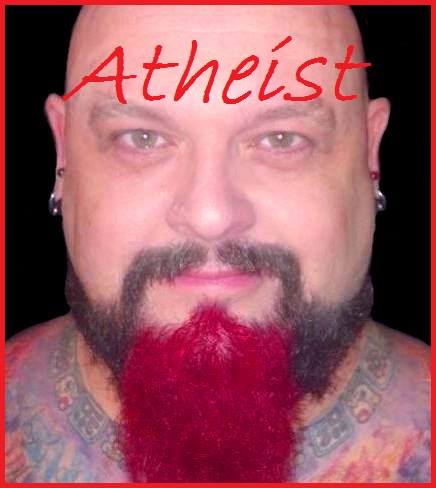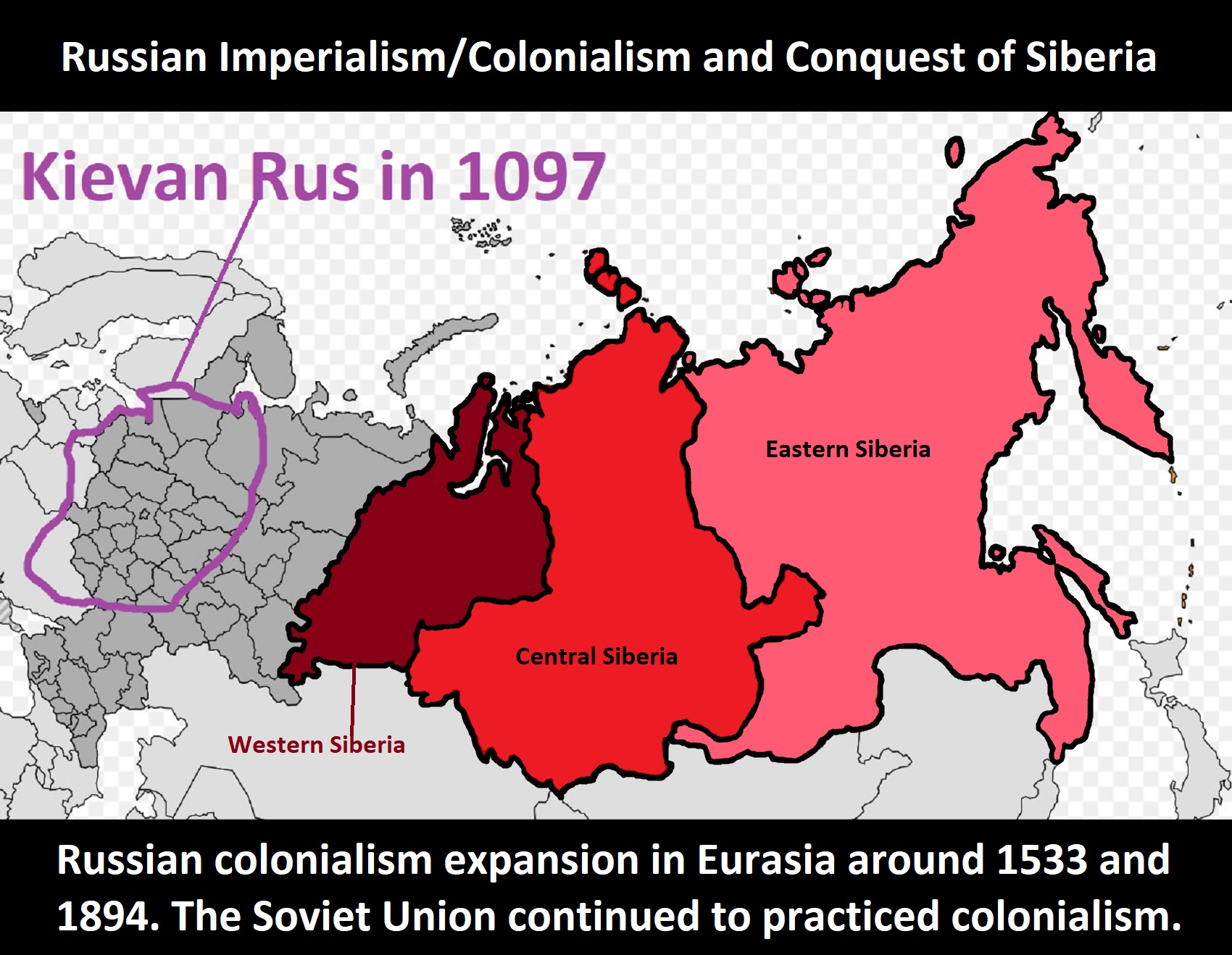
ref, ref, ref, ref, ref, ref, ref
Russian Imperialism Colonialism and Conquest of Siberia
Russian colonialism expansion in Eurasia around 1533 and 1894. The Soviet Union continued to practiced colonialism.
“Russia or the Russian Federation, is a transcontinental country spanning Eastern Europe and Northern Asia. It is the largest country in the world, encompassing one-eighth of Earth’s inhabitable landmass. Russia extends across eleven time zones and shares land boundaries with fourteen countries. It is the world’s ninth-most populous country and Europe’s most populous country. The country’s capital and largest city is Moscow. Saint Petersburg is Russia’s cultural center and second-largest city. Other major urban areas include Novosibirsk, Yekaterinburg, Nizhny Novgorod, and Kazan.” ref
“The East Slavs emerged as a recognisable group in Europe between the 3rd and 8th centuries CE. The first East Slavic state, Kievan Rus’, arose in the 9th century, and in 988, it adopted Orthodox Christianity from the Byzantine Empire. Rus’ ultimately disintegrated, with the Grand Duchy of Moscow growing to become the Tsardom of Russia. By the early 18th century, Russia had vastly expanded through conquest, annexation, and the efforts of Russian explorers, developing into the Russian Empire, which remains the third-largest empire in history.” ref
“However, with the Russian Revolution in 1917, Russia’s monarchic rule was abolished and eventually replaced by the Russian SFSR—the world’s first constitutionally socialist state. Following the Russian Civil War, the Russian SFSR established the Soviet Union with three other Soviet republics, within which it was the largest and principal constituent. At the expense of millions of lives, the Soviet Union underwent rapid industrialisation in the 1930s, and later played a decisive role for the Allies of World War II by leading large-scale efforts on the Eastern Front. With the onset of the Cold War, it competed with the United States for global ideological influence; the Soviet era of the 20th century saw some of the most significant Russian technological achievements, including the first human-made satellite and the first human expedition into outer space.” ref
“In 1991, the Russian SFSR emerged from the dissolution of the Soviet Union as the independent Russian Federation. A new constitution was adopted, which established a federal semi-presidential system. Since the turn of the century, Russia’s political system has been dominated by Vladimir Putin, under whom the country has experienced democratic backsliding and a shift towards authoritarianism. Russia has been involved militarily in a number of post-Soviet conflicts, which has included the internationally unrecognized annexations of Crimea in 2014 from neighboring Ukraine, followed by the further annexation of four other regions in 2022 during an ongoing invasion. International rankings of Russia place it low in measurements of human rights and freedom of the press; the country also has high levels of perceived corruption.” ref
I hate all imperialism: American imperialism, and Russian imperialism
“Russian imperialism includes the policy and ideology of power exerted by Russia, as well as its antecedent states, over other countries and external territories. This includes the conquests of the Russian Empire, the imperial actions of the Soviet Union (as Russia is considered its main successor state), as well as those of the modern Russian Federation. Some postcolonial scholars have noted the lack of attention given to Russian and Soviet imperialism in the discipline.” ref
“The Far North was a fabled territory to city dwellers in “civilized,” temperate Europe. Classical Greek and Roman geographers told their readers that north beyond civilized settlements roamed cannibals; dog-headed people who barked; people who hibernated half of the year or spent half the year underwater; people who had no notion of private property, marriage, or laws. Medieval travel writers including Marco Polo repeated the fantastic tales. Meanwhile, the Russian kingdoms of Novgorod and then Moscow developed a trade in expensive furs—sable, fox, and beaver—with northern hunters. By the end of the sixteenth century, Cossacks employed by Russian agents shattered Tatar rule in Sibir and extended the Czar’s sovereignty through a series of fortified trading posts where natives were obliged to pay tribute in the form of furs, receiving “gifts” from “the czar’s exalted hand” in return.” – Shamans and Religion, An Anthropological Exploration in Critical Thinking by Alice Beck Kehoe
“The “gifts” were axes and knives, cloth, beads, tea, sugar, and tobacco, presented with exotic food (Russian bread) and liquor. Superficially, it looked like the Western European trade with American Indians that would develop a century later, except that Russia considered the Siberian nations to be their subjects and enforced tribute with military campaigns. Siberia being an exceedingly large territory, it took Russia a good two centuries to push sovereignty eastward to the Pacific, and then the Bolshevik Revolution of 1917 turned the Czar’s rule into Soviet domination.” – Shamans and Religion, An Anthropological Exploration in Critical Thinking by Alice Beck Kehoe
“Russian or Soviet, the conquering power officially classified the non-Russian people as “aliens.” A few “aliens” were formally educated town-dwellers or peasant farmers and could be treated like Russians, many were classified as “nomads” who moved with their herds regularly to seasonal pastures, and others were classified as “wanderers” who hunted and fished apparently (so far as the Russian officials noticed) without fixed movements. Nomads and wanderers were required to turn in annual fur tributes, but the Russian colonial officials let them continue their “alien” customs. “Aliens” who accepted Christian baptism were compelled to settle in Russian outposts. Native women who were married to, or kept as concubines by, Russians expected this, but for native men, it meant leaving their families and occupations of herding or hunting.” – Shamans and Religion, An Anthropological Exploration in Critical Thinking by Alice Beck Kehoe
“For the Russian enterprise, it meant these men ceased to pay fur tribute; therefore, there was little government effort to convert the Siberians until, in 1702, Peter the Great encouraged the Russian Orthodox missionaries to bring soldiers with them to persuade whole villages to accept baptism after the priests burned their shrines and images of spirits. Czar Peter protected the Crown’s revenue by rescinding the rule that converts were freed of fur tribute. Through the eighteenth and early nineteenth centuries, Russian interventions in Siberia became increasingly onerous for the indigenous nations. Siberian families became accustomed to trade for metal kettles as well as axes, knives, and traps, and purchased flour, tea, and sugar that were regularly eaten. Liquor and tobacco remained important constituents of the fur trade.” – Shamans and Religion, An Anthropological Exploration in Critical Thinking by Alice Beck Kehoe
“The “aliens” were subject to labor taxes including road building, carting, providing firewood to heat the trading posts, and assisting officials. An 1822 law formally recognized a policy of indirect rule with Russian officials governing through designated male “clan elders” regardless of whether the people had clans. These appointees administered customary law and relieved some of the burdens of tribute collecting. A designated “clan elder” could be a shaman, or simply the oldest active responsible man in a district. Historian Yuri Slezkine (1994:88) considers this attitude toward the empire’s “aliens” to reflect nineteenth-century Western intellectuals’ belief that uncivilized (i.e., not living in cities) peoples are indicative of the early condition of human-kind, incapable of performing the obligations and rights of citizens. Superficially, the policy seems benign, but in fact, it was racist, denying the social achievements of the small nations adapted to the harsh environments of the north.” – Shamans and Religion, An Anthropological Exploration in Critical Thinking by Alice Beck Kehoe
Indigenous peoples of Siberia
The 2021 census recorded 1,620,000 indigenous Siberians:
Aleuts, Alutor, Ainu in Russia, Altaians, Buryat, Chuvans, Chukchis, Chulyms, Dolgans, Evenks, Evens, Enets, Itelmens, Kamchadals, Kereks, Kets, Koryaks, Khakas, Khanty, Mansi, Nanai, Nenets, Negidals, Nivkh, Nganasan, Orochs, Oroks, Samoyedic, Shors, Selkup, Soyot, Siberian Tatars, Taz, Teleuts, Tofalar, Tuvans, Siberian Turks, Udege, Ugric, Ulchs, Yakuts, Yukaghirs, Yukaghir, and Siberian Yupik. ref
“A large minority of people in North Asia, particularly in Siberia, follow the religio-cultural practices of shamanism. The people of Siberia comprise a variety of ethnic groups, many of whom continue to observe shamanistic practices in modern times. Many classical ethnographers recorded the sources of the idea of “shamanism” among Siberian peoples.” ref
“Shaman” Terminology in Siberian languages:
- ‘shaman’: saman(Nedigal, Nanay, Ulcha, Orok), sama (Manchu). The variant /šaman/ (i.e., pronounced “shaman”) is Evenk (whence it was borrowed into Russian).
- ‘shaman’: alman, olman, wolmen(Yukagir)
- ‘shaman’: [qam](Tatar, Shor, Oyrat), [xam] (Tuva, Tofalar)
- The Buryatword for shaman is бөө (böö) [bøː], from early Mongolian böge. Itself borrowed from Proto-Turkic *bögü (“sage, wizard”)
- ‘shaman’: ńajt (Khanty, Mansi), from Proto-Uralic*nojta (c.f. Sámi noaidi)
- ‘shamaness’: [iduɣan](Mongol), [udaɣan] (Yakut), udagan (Buryat), udugan (Evenki, Lamut), odogan (Nedigal). Related forms found in various Siberian languages include utagan, ubakan, utygan, utügun, iduan, or duana. All these are related to the Mongolian name of Etügen, the hearth goddess, and Etügen Eke ‘Mother Earth’. Maria Czaplicka points out that Siberian languages use words for male shamans from diverse roots, but the words for female shaman are almost all from the same root. She connects this with the theory that women’s practice of shamanism was established earlier than men’s, that “shamans were originally female.” ref
“More than 1.67 million people in Canada identify themselves as an Aboriginal person, according to the 2016 Census.” ref
So basically there are as many indigenous peoples in Canada as there are in Siberia.
To me, Russia, Canada, and America should give back land and give reparations too. If they think they can’t give the land back then they should make a “colonizer tax” and give all funds to the Indigenous peoples of each area.
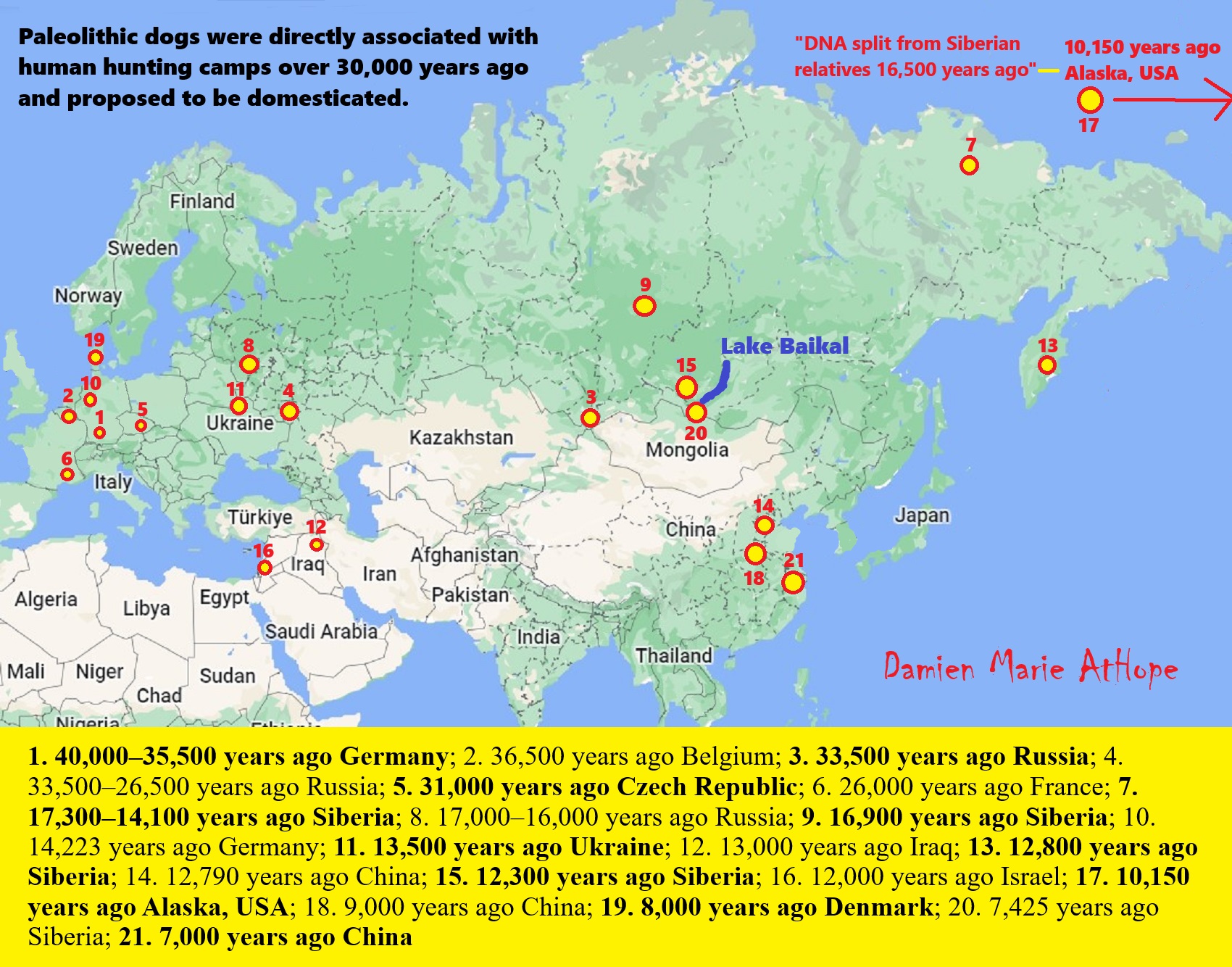
“The Paleolithic dog was a Late Pleistocene canine. They were directly associated with human hunting camps in Europe over 30,000 years ago and it is proposed that these were domesticated. They are further proposed to be either a proto-dog and the ancestor of the domestic dog or an extinct, morphologically and genetically divergent wolf population. There are a number of recently discovered specimens which are proposed as being Paleolithic dogs, however, their taxonomy is debated. These have been found in either Europe or Siberia and date 40,000–17,000 years ago. They include Hohle Fels in Germany, Goyet Caves in Belgium, Predmosti in the Czech Republic, and four sites in Russia: Razboinichya Cave in the Altai Republic, Kostyonki-8, Ulakhan Sular in the Sakha Republic, and Eliseevichi 1 on the Russian plain.” ref
- 40,000–35,500 years ago Hohle Fels, Schelklingen,Germany
2. 36,500 years ago Goyet Caves,Samson River Valley, Belgium
3. 33,500 years ago Razboinichya Cave, Altai Mountains, (Russia/Siberia)
4. 33,500–26,500 years ago Kostyonki-Borshchyovo archaeological complex, (Kostenki site) Voronezh, Russia
5. 31,000 years ago Predmostí, Moravia, Czech Republic
6. 26,000 years ago Chauvet Cave, Vallon-Pont-d’Arc, Ardèche region, France
7. 17,300–14,100 years ago Dyuktai Cave, northern Yakutia, Siberia
8. 17,000–16,000 years ago Eliseevichi-I site, Bryansk Region, Russian Plain, Russia
9. 16,900 years ago Afontova Gora-1, Yenisei River, southern Siberia
10. 14,223 years ago Bonn–Oberkassel, Germany
11. 13,500 years ago Mezine, Chernigov region, Ukraine
12. 13,000 years ago Palegawra, (Zarzian culture) Iraq
13. 12,800 years ago Ushki I, Kamchatka, eastern Siberia
14. 12,790 years ago Nanzhuangtou, China
15. 12,300 years ago Ust’-Khaita site, Baikal region, Siberia
16. 12,000 years ago Ain Mallaha (Eynan) and HaYonim terrace, Israel
17. 10,150 years ago Lawyer’s Cave, Alaska, USA
18. 9,000 years ago Jiahu site, China
19. 8,000 years ago Svaerdborg site, Denmark
20. 7,425 years ago Lake Baikal region, Siberia
21. 7,000 years ago Tianluoshan archaeological site, Zhejiang province, China ref
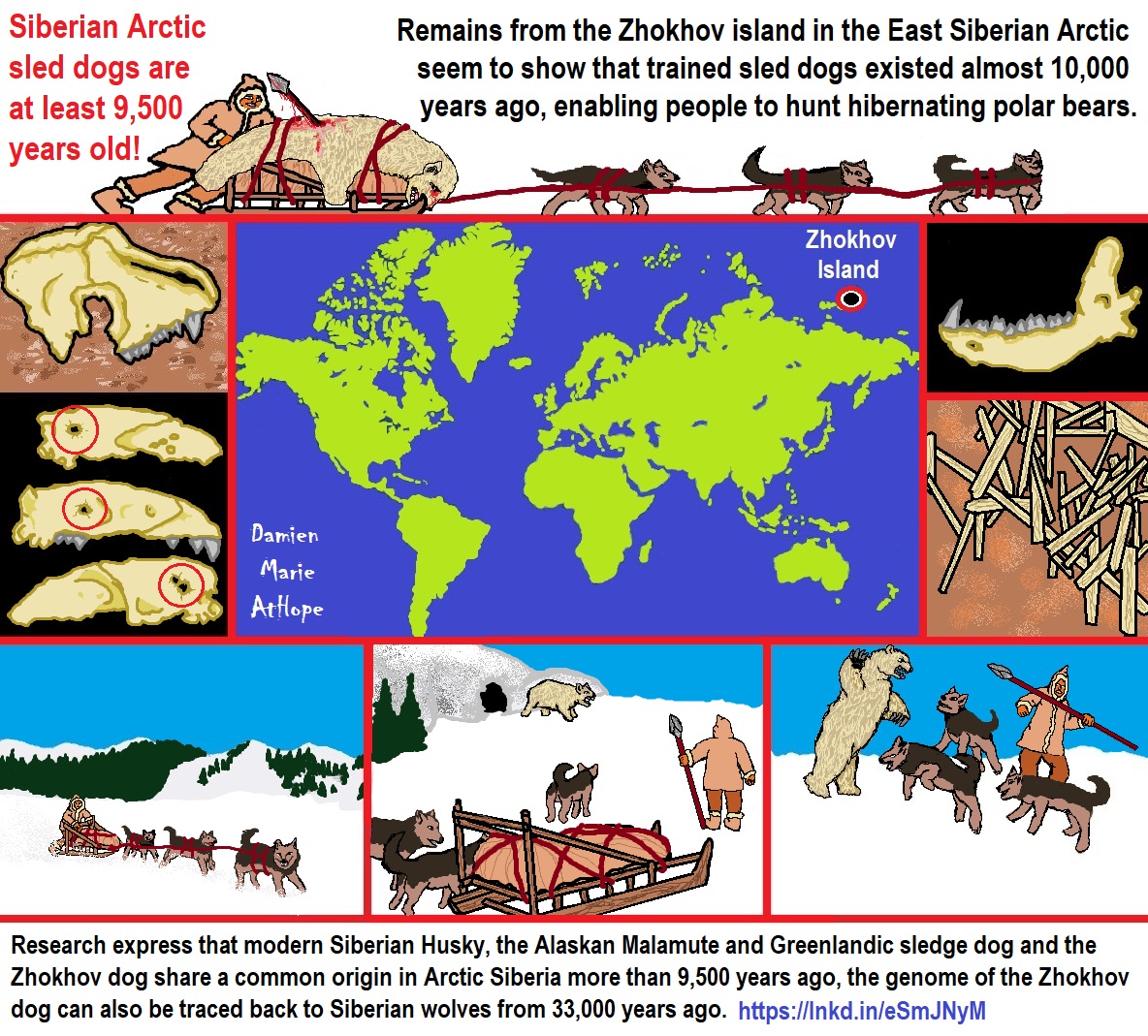
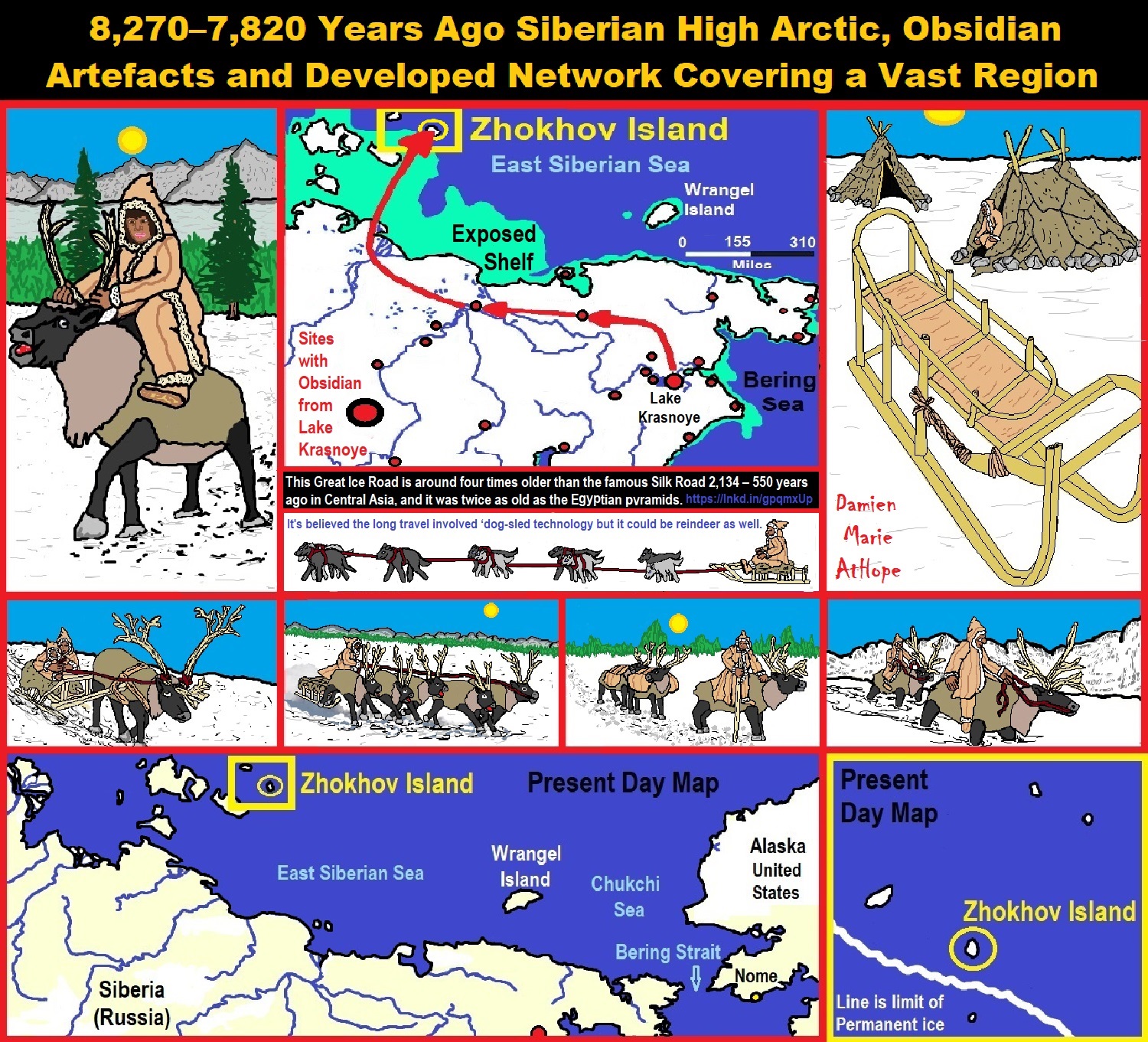
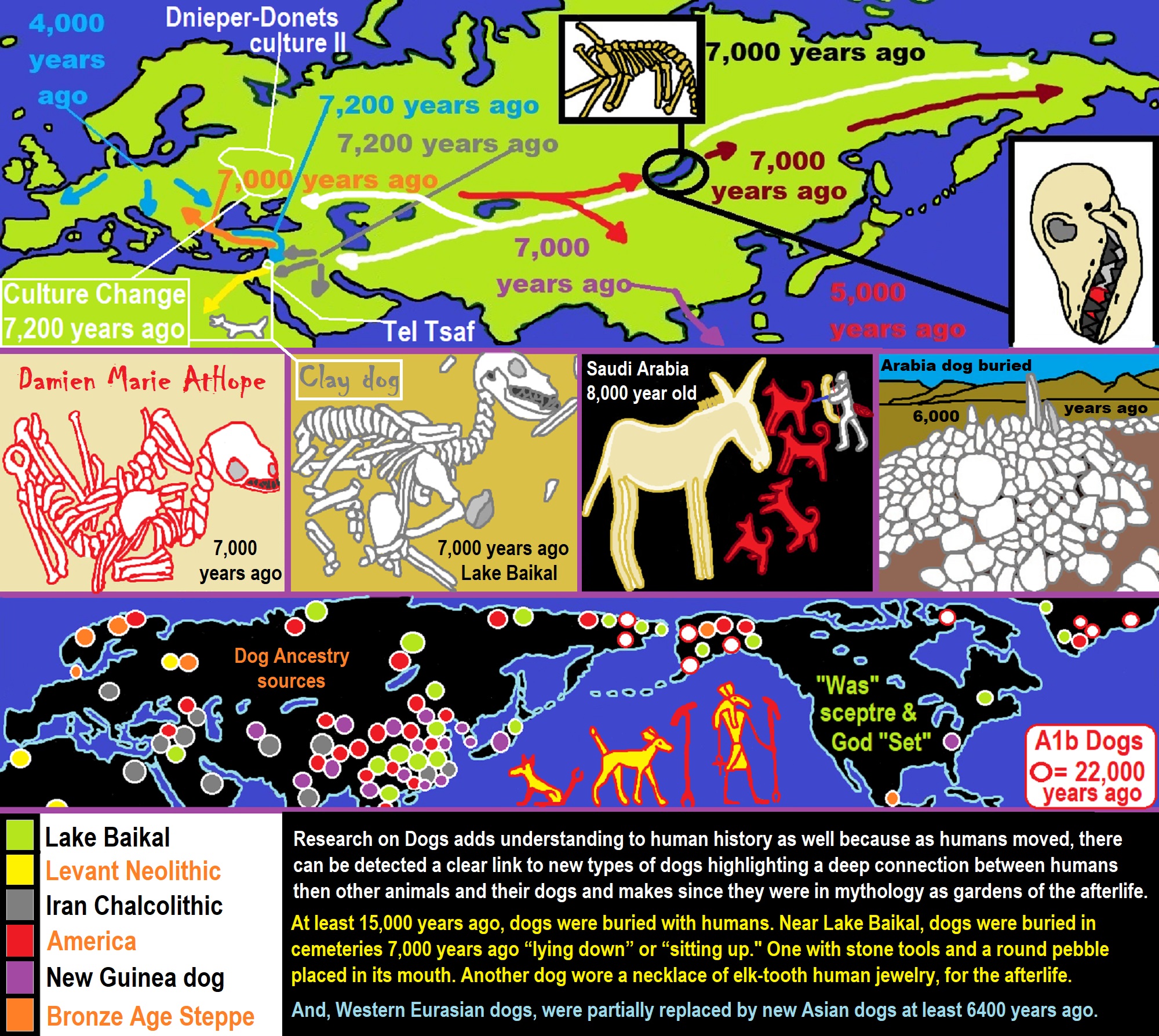
Comparative Mythology
“Since the term ‘Ancient North Eurasian’ refers to a genetic bridge of connected mating networks, scholars of comparative mythology have argued that they probably shared myths and beliefs that could be reconstructed via the comparison of stories attested within cultures that were not in contact for millennia and stretched from the Pontic–Caspian steppe to the American continent.” ref
“The mytheme of the dog guarding the Otherworld possibly stems from an older Ancient North Eurasian belief, as suggested by similar motifs found in Indo-European, Native American and Siberian mythology. In Siouan, Algonquian, Iroquoian, and in Central and South American beliefs, a fierce guard dog was located in the Milky Way, perceived as the path of souls in the afterlife, and getting past it was a test.” ref
“The Siberian Chukchi and Tungus believed in a guardian-of-the-afterlife dog and a spirit dog that would absorb the dead man’s soul and act as a guide in the afterlife. In Indo-European myths, the figure of the dog is embodied by Cerberus, Sarvarā, and Garmr. In Zoroastrianism, two four-eyed dogs guard the bridge to the afterlife called Chinvat Bridge. Anthony and Brown note that it might be one of the oldest mythemes recoverable through comparative mythology.” ref
“A second canid-related series of beliefs, myths and rituals connected dogs with healing rather than death. For instance, Ancient Near Eastern and Turkic–Kipchaq myths are prone to associate dogs with healing and generally categorised dogs as impure. A similar myth-pattern is assumed for the Eneolithic site of Botai in Kazakhstan, dated to 3500 BCE or around 5,500 years ago, which might represent the dog as absorber of illness and guardian of the household against disease and evil. In Mesopotamia, the goddess Nintinugga, associated with healing, was accompanied or symbolized by dogs. Similar absorbent-puppy healing and sacrifice rituals were practiced in Greece and Italy, among the Hittites, again possibly influenced by Near Eastern traditions.” ref
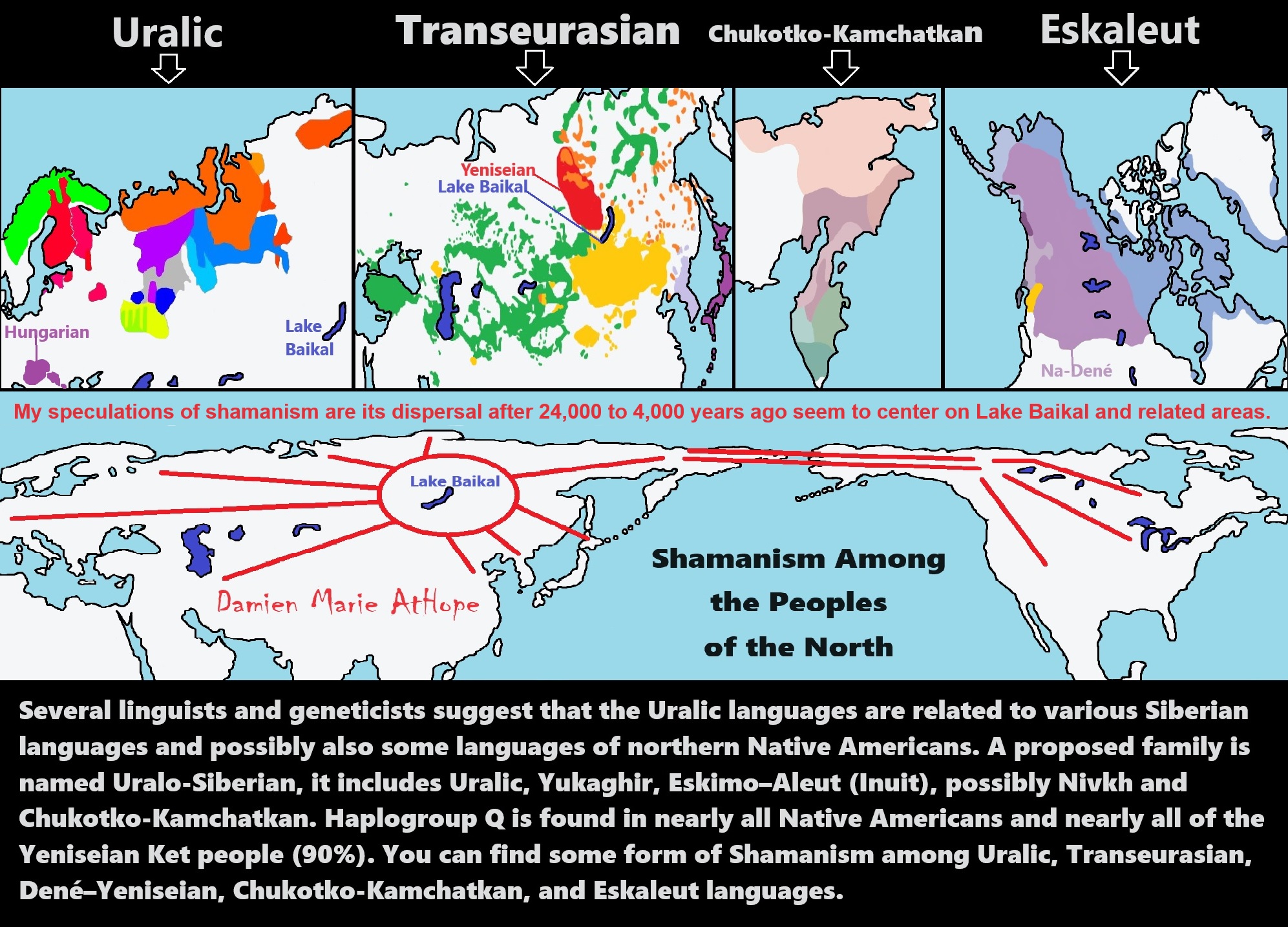
ref, ref, ref, ref, ref, ref, ref, ref, ref
“Several linguists and geneticists suggest that the Uralic languages are related to various Siberian languages and possibly also some languages of northern Native Americans. A proposed family is named Uralo-Siberian, it includes Uralic, Yukaghir, Eskimo–Aleut (Inuit), possibly Nivkh, and Chukotko-Kamchatkan. Haplogroup Q is found in nearly all Native Americans and nearly all of the Yeniseian Ket people (90%).” ref, ref
You can find some form of Shamanism, among Uralic, Transeurasian, Dené–Yeniseian, Chukotko-Kamchatkan, and Eskaleut languages.
My speculations of shamanism are its dispersals, after 24,000 to 4,000 years ago, seem to center on Lake Baikal and related areas. To me, the hotspot of Shamanism goes from west of Lake Baikal in the “Altai Mountains” also encompassing “Lake Baikal” and includes the “Amur Region/Watershed” east of Lake Baikal as the main location Shamanism seems to have radiated out from.
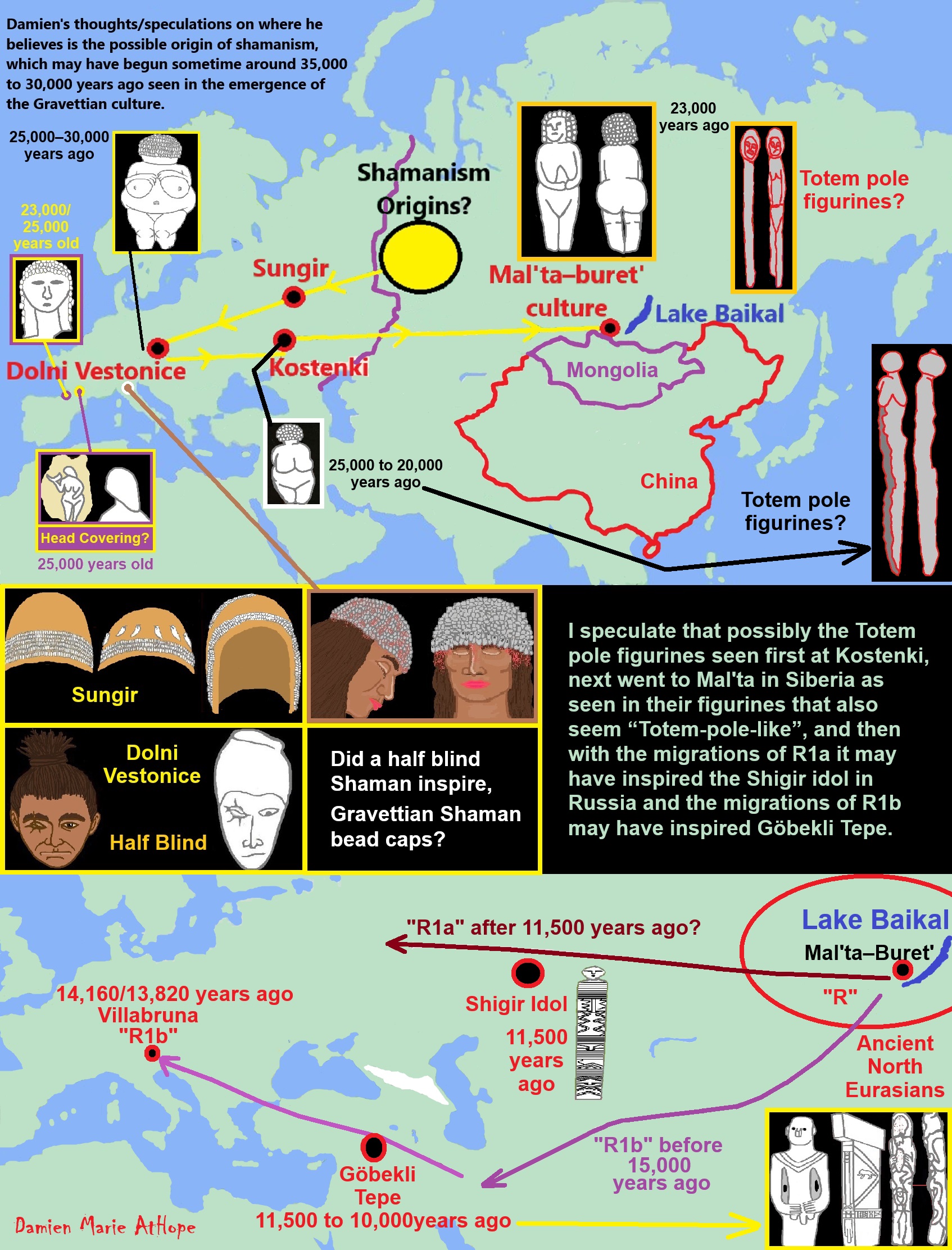
ref, ref, ref, ref, ref, ref, ref, ref, ref, ref, ref, ref, ref, ref, ref, ref, ref, ref, ref
Here are my thoughts/speculations on where I believe is the possible origin of shamanism, which may have begun sometime around 35,000 to 30,000 years ago seen in the emergence of the Gravettian culture, just to outline his thinking, on what thousands of years later led to evolved Asian shamanism, in general, and thus WU shamanism as well. In both Europe-related “shamanism-possible burials” and in Gravettian mitochondrial DNA is a seeming connection to Haplogroup U. And the first believed Shaman proposed burial belonged to Eastern Gravettians/Pavlovian culture at Dolní Věstonice in southern Moravia in the Czech Republic, which is the oldest permanent human settlement that has ever been found. It is at Dolní Věstonice where approximately 27,000-25,000 years ago a seeming female shaman was buried and also there was an ivory totem portrait figure, seemingly of her.
And my thoughts on how cultural/ritual aspects were influenced in the area of Göbekli Tepe. I think it relates to a few different cultures starting in the area before the Neolithic. Two different groups of Siberians first from northwest Siberia with U6 haplogroup 40,000 to 30,000 or so. Then R Haplogroup (mainly haplogroup R1b but also some possible R1a both related to the Ancient North Eurasians). This second group added its “R1b” DNA of around 50% to the two cultures Natufian and Trialetian. To me, it is likely both of these cultures helped create Göbekli Tepe. Then I think the female art or graffiti seen at Göbekli Tepe to me possibly relates to the Epigravettians that made it into Turkey and have similar art in North Italy. I speculate that possibly the Totem pole figurines seen first at Kostenki, next went to Mal’ta in Siberia as seen in their figurines that also seem “Totem-pole-like”, and then with the migrations of R1a it may have inspired the Shigir idol in Russia and the migrations of R1b may have inspired Göbekli Tepe.
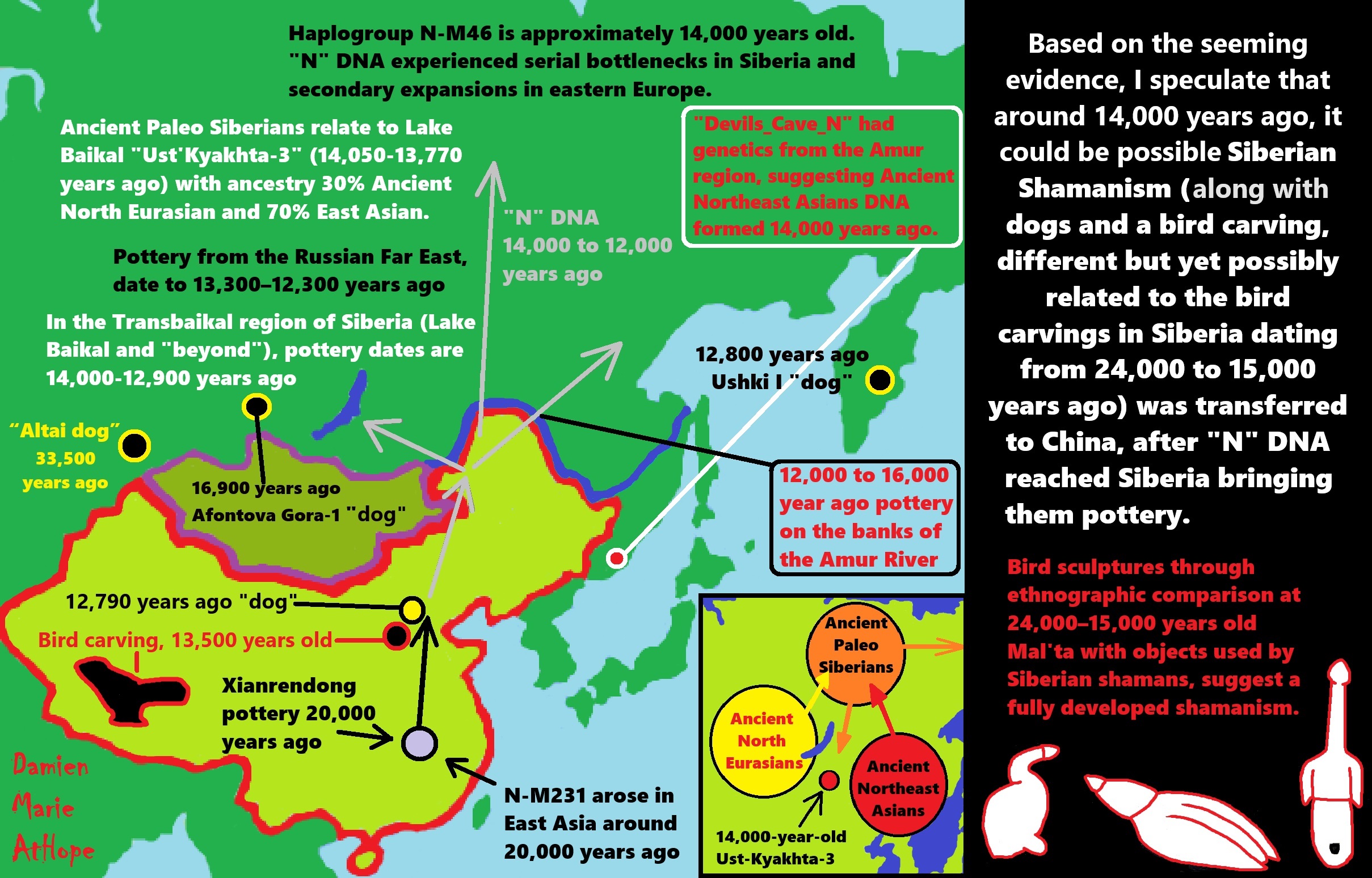
ref, ref, ref, ref, ref, ref, ref, ref, ref, ref, ref, ref, ref, ref, ref, ref
Based on the seeming evidence, I speculate that around 14,000 years ago, it could be possible Siberian Shamanism (along with dogs and a bird carving, different but yet possibly related to the bird carvings in Siberia dating from 24,000 to 15,000 years ago) was transferred to China, after “N” DNA reached Siberia bringing them pottery. Bird sculptures through ethnographic comparison at 24,000–15,000 years old Mal’ta with objects used by Siberian shamans, suggest a fully developed shamanism.
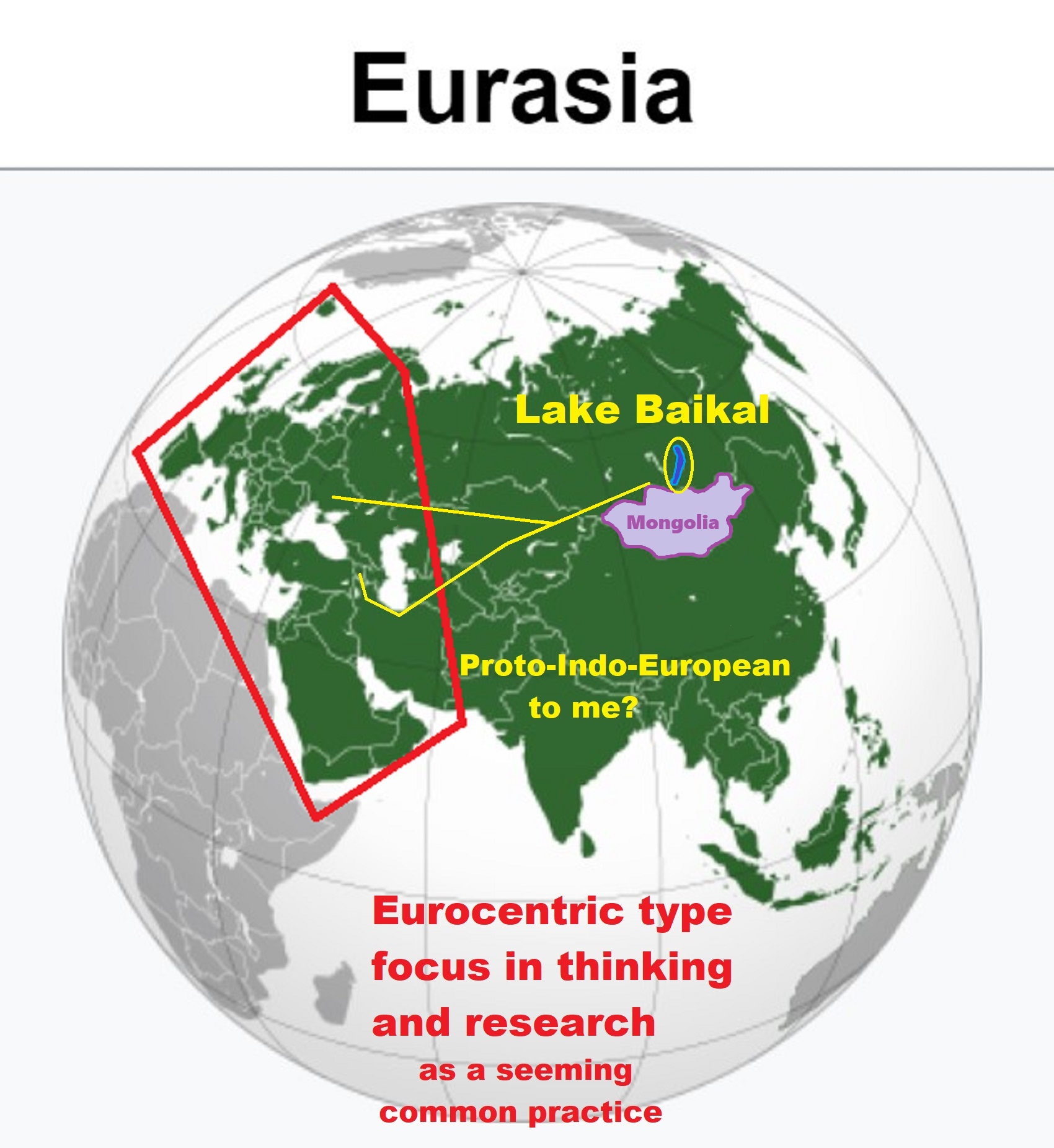
Origins of ‘Transeurasian’ languages traced to Neolithic millet farmers in north-eastern China about 9,000 years ago
“A study combining linguistic, genetic, and archaeological evidence has traced the origins of a family of languages including modern Japanese, Korean, Turkish and Mongolian and the people who speak them to millet farmers who inhabited a region in north-eastern China about 9,000 years ago. The findings outlined on Wednesday document a shared genetic ancestry for the hundreds of millions of people who speak what the researchers call Transeurasian languages across an area stretching more than 5,000 miles (8,000km).” ref
“Millet was an important early crop as hunter-gatherers transitioned to an agricultural lifestyle. There are 98 Transeurasian languages, including Korean, Japanese, and various Turkic languages in parts of Europe, Anatolia, Central Asia, and Siberia, various Mongolic languages, and various Tungusic languages in Manchuria and Siberia. This language family’s beginnings were traced to Neolithic millet farmers in the Liao River valley, an area encompassing parts of the Chinese provinces of Liaoning and Jilin and the region of Inner Mongolia. As these farmers moved across north-eastern Asia over thousands of years, the descendant languages spread north and west into Siberia and the steppes and east into the Korean peninsula and over the sea to the Japanese archipelago.” ref
“Eurasiatic is a proposed language with many language families historically spoken in northern, western, and southern Eurasia; which typically include Altaic (Mongolic, Tungusic, and Turkic), Chukchi-Kamchatkan, Eskimo–Aleut, Indo-European, and Uralic.” ref
“Voiced stops such as /d/ occur in the Indo-European, Yeniseian, Turkic, Mongolian, Tungusic, Japonic and Sino-Tibetan languages. They have also later arisen in several branches of Uralic.” ref
“Uralo-Siberian is a hypothetical language family of Uralic, Yukaghir, Eskimo–Aleut and besides linguistic evidence, several genetic studies, support a common origin in Northeast Asia.” ref
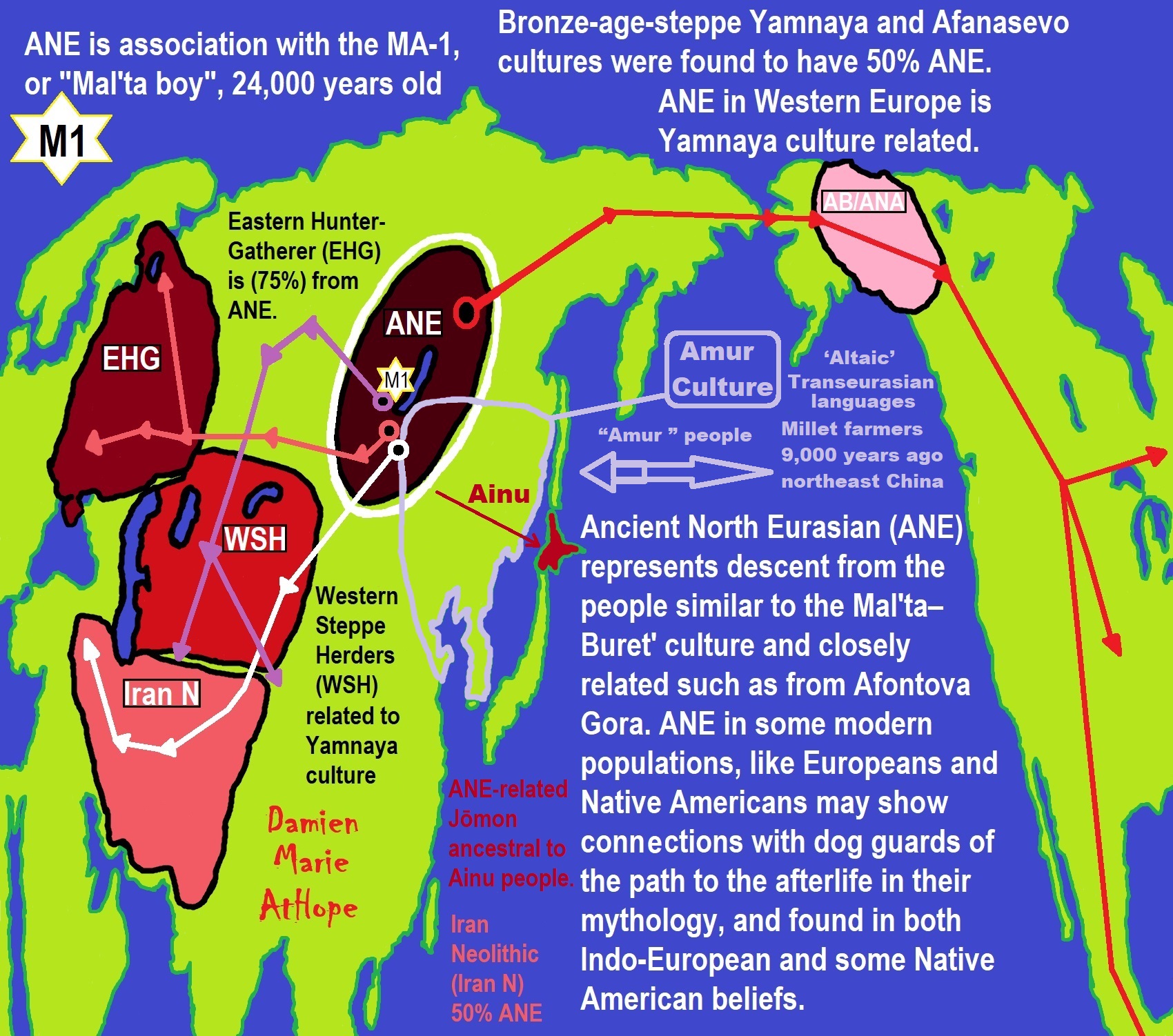
Ancient North Eurasian (ANE)
Ancient Beringian/Ancestral Native American (AB/ANA)
Eastern Hunter-Gatherer (EHG)
Western Hunter-Gatherers (WHG)
Western Steppe Herders (WSH)
Scandinavian Hunter-Gatherer (SHG)
Early European Farmers (EEF)
Jōmon people (Ainu people OF Hokkaido Island)
Neolithic Iranian farmers (Iran_N) (Iran Neolithic)
Haplogroup R possible time of origin about 27,000 years in Central Asia, South Asia, or Siberia:
- Mal’ta–Buret’ culture (24,000-15,000 years ago)
- Afontova Gora culture (21,000-12,000 years ago)
- Trialetian culture (16,000–8000 years ago)
- Samara culture (7,000-6,500 years ago)
- Khvalynsk culture (7,000-6,500 years ago)
- Afanasievo culture (5,300-4,500 years ago)
- Yamna/Yamnaya Culture (5,300-4,500 years ago)
- Andronovo culture (4,000–2,900 years ago) ref
Groups partially derived from the Ancient North Eurasians
“The ANE lineage is defined by association with the MA-1, or “Mal’ta boy”, remains of 24,000 years ago in central Siberia Mal’ta-Buret’ culture 24,000-15,000 years ago. The Ancient North Eurasians (ANE) samples (Afontova Gora 3, Mal’ta 1, and Yana-RHS) show evidence for minor gene flow from an East Asian-related group (simplified by the Amis, Han, or Tianyuan) but no evidence for ANE-related geneflow into East Asians (Amis, Han, Tianyuan), except the Ainu, of North Japan.” ref
“The ANE lineage is defined by association with the MA-1, or “Mal’ta boy”, remains of 24,000 years ago in central Siberia Mal’ta-Buret’ culture 24,000-15,000 years ago “basal to modern-day Europeans”. Some Ancient North Eurasians also carried East Asian populations, such as Tianyuan Man.” ref
“Bronze-age-steppe Yamnaya and Afanasevo cultures were ANE at around 50% and Eastern Hunter-Gatherer (EHG) at around 75% ANE. Karelia culture: Y-DNA R1a-M417 8,400 years ago, Y-DNA J, 7,200 years ago, and Samara, of Y-haplogroup R1b-P297 7,600 years ago is closely related to ANE from Afontova Gora, 18,000 years ago around the time of blond hair first seen there.” ref
Ancient North Eurasian
“In archaeogenetics, the term Ancient North Eurasian (often abbreviated as ANE) is the name given to an ancestral West Eurasian component that represents descent from the people similar to the Mal’ta–Buret’ culture and populations closely related to them, such as from Afontova Gora and the Yana Rhinoceros Horn Site. Significant ANE ancestry are found in some modern populations, including Europeans and Native Americans.” ref
“The ANE lineage is defined by association with the MA-1, or “Mal’ta boy“, the remains of an individual who lived during the Last Glacial Maximum, 24,000 years ago in central Siberia, Ancient North Eurasians are described as a lineage “which is deeply related to Paleolithic/Mesolithic hunter-gatherers in Europe,” meaning that they diverged from Paleolithic Europeans a long time ago.” ref
“The ANE population has also been described as having been “basal to modern-day Europeans” but not especially related to East Asians, and is suggested to have perhaps originated in Europe or Western Asia or the Eurasian Steppe of Central Asia. However, some samples associated with Ancient North Eurasians also carried ancestry from an ancient East Asian population, such as Tianyuan Man. Sikora et al. (2019) found that the Yana RHS sample (31,600 BP) in Northern Siberia “can be modeled as early West Eurasian with an approximately 22% contribution from early East Asians.” ref
“Populations genetically similar to MA-1 were an important genetic contributor to Native Americans, Europeans, Central Asians, South Asians, and some East Asian groups, in order of significance. Lazaridis et al. (2016:10) note “a cline of ANE ancestry across the east-west extent of Eurasia.” The ancient Bronze-age-steppe Yamnaya and Afanasevo cultures were found to have a noteworthy ANE component at ~50%.” ref
“According to Moreno-Mayar et al. 2018 between 14% and 38% of Native American ancestry may originate from gene flow from the Mal’ta–Buret’ people (ANE). This difference is caused by the penetration of posterior Siberian migrations into the Americas, with the lowest percentages of ANE ancestry found in Eskimos and Alaskan Natives, as these groups are the result of migrations into the Americas roughly 5,000 years ago.” ref
“Estimates for ANE ancestry among first wave Native Americans show higher percentages, such as 42% for those belonging to the Andean region in South America. The other gene flow in Native Americans (the remainder of their ancestry) was of East Asian origin. Gene sequencing of another south-central Siberian people (Afontova Gora-2) dating to approximately 17,000 years ago, revealed similar autosomal genetic signatures to that of Mal’ta boy-1, suggesting that the region was continuously occupied by humans throughout the Last Glacial Maximum.” ref
“The earliest known individual with a genetic mutation associated with blonde hair in modern Europeans is an Ancient North Eurasian female dating to around 16000 BCE from the Afontova Gora 3 site in Siberia. It has been suggested that their mythology may have included a narrative, found in both Indo-European and some Native American fables, in which a dog guards the path to the afterlife.” ref
“Genomic studies also indicate that the ANE component was introduced to Western Europe by people related to the Yamnaya culture, long after the Paleolithic. It is reported in modern-day Europeans (7%–25%), but not of Europeans before the Bronze Age. Additional ANE ancestry is found in European populations through paleolithic interactions with Eastern Hunter-Gatherers, which resulted in populations such as Scandinavian Hunter-Gatherers.” ref
“The Ancient North Eurasians (ANE) split from the ancestors of European peoples somewhere in the Middle East or South-central Asia, and used a northern dispersal route through Central Asia into Northern Asia and Siberia. Genetic analyses show that all ANE samples (Afontova Gora 3, Mal’ta 1, and Yana-RHS) show evidence for minor gene flow from an East Asian-related group (simplified by the Amis, Han, or Tianyuan). In contrast, no evidence for ANE-related geneflow into East Asians (Amis, Han, Tianyuan), except the Ainu, was found.” ref
“Genetic data suggests that the ANE formed during the Terminal Upper-Paleolithic (36+-1,5ka) period from a deeply European-related population, which was once widespread in Northern Eurasia, and from an early East Asian-related group, which migrated northwards into Central Asia and Siberia, merging with this deeply European-related population. These population dynamics and constant northwards geneflow of East Asian-related ancestry would later gave rise to the “Ancestral Native Americans” and Paleosiberians, which replaced the ANE as dominant population of Siberia.” ref
Groups partially derived from the Ancient North Eurasians
“Eastern Hunter-Gatherer (EHG) is a lineage derived predominantly (75%) from ANE. It is represented by two individuals from Karelia, one of Y-haplogroup R1a-M417, dated c. 8.4 kya, the other of Y-haplogroup J, dated c. 7.2 kya; and one individual from Samara, of Y-haplogroup R1b-P297, dated c. 7.6 kya. This lineage is closely related to the ANE sample from Afontova Gora, dated c. 18 kya. After the end of the Last Glacial Maximum, the Western Hunter-Gatherers (WHG) and EHG lineages merged in Eastern Europe, accounting for early presence of ANE-derived ancestry in Mesolithic Europe. Evidence suggests that as Ancient North Eurasians migrated West from Eastern Siberia, they absorbed Western Hunter-Gatherers and other West Eurasian populations as well.” ref
“Caucasian Hunter-Gatherer (CHG) is represented by the Satsurblia individual dated ~13 kya (from the Satsurblia cave in Georgia), and carried 36% ANE-derived admixture. While the rest of their ancestry is derived from the Dzudzuana cave individual dated ~26 kya, which lacked ANE-admixture, Dzudzuana affinity in the Caucasus decreased with the arrival of ANE at ~13 kya Satsurblia.” ref
“Scandinavian Hunter-Gatherer (SHG) is represented by several individuals buried at Motala, Sweden ca. 6000 BC. They were descended from Western Hunter-Gatherers who initially settled Scandinavia from the south, and later populations of EHG who entered Scandinavia from the north through the coast of Norway.” ref
“Iran Neolithic (Iran_N) individuals dated ~8.5 kya carried 50% ANE-derived admixture and 50% Dzudzuana-related admixture, marking them as different from other Near-Eastern and Anatolian Neolithics who didn’t have ANE admixture. Iran Neolithics were later replaced by Iran Chalcolithics, who were a mixture of Iran Neolithic and Near Eastern Levant Neolithic.” ref
“Ancient Beringian/Ancestral Native American are specific archaeogenetic lineages, based on the genome of an infant found at the Upward Sun River site (dubbed USR1), dated to 11,500 years ago. The AB lineage diverged from the Ancestral Native American (ANA) lineage about 20,000 years ago.” ref
“West Siberian Hunter-Gatherer (WSHG) are a specific archaeogenetic lineage, first reported in a genetic study published in Science in September 2019. WSGs were found to be of about 30% EHG ancestry, 50% ANE ancestry, and 20% to 38% East Asian ancestry.” ref
“Western Steppe Herders (WSH) is the name given to a distinct ancestral component that represents descent closely related to the Yamnaya culture of the Pontic–Caspian steppe. This ancestry is often referred to as Yamnaya ancestry or Steppe ancestry.” ref
“Late Upper Paeolithic Lake Baikal – Ust’Kyakhta-3 (UKY) 14,050-13,770 BP were mixture of 30% ANE ancestry and 70% East Asian ancestry.” ref
“Lake Baikal Holocene – Baikal Eneolithic (Baikal_EN) and Baikal Early Bronze Age (Baikal_EBA) derived 6.4% to 20.1% ancestry from ANE, while rest of their ancestry was derived from East Asians. Fofonovo_EN near by Lake Baikal were mixture of 12-17% ANE ancestry and 83-87% East Asian ancestry.” ref
“Hokkaido Jōmon people specifically refers to the Jōmon period population of Hokkaido in northernmost Japan. Though the Jōmon people themselves descended mainly from East Asian lineages, one study found an affinity between Hokkaido Jōmon with the Northern Eurasian Yana sample (an ANE-related group, related to Mal’ta), and suggest as an explanation the possibility of minor Yana gene flow into the Hokkaido Jōmon population (as well as other possibilities). A more recent study by Cooke et al. 2021, confirmed ANE-related geneflow among the Jōmon people, partially ancestral to the Ainu people. ANE ancestry among Jōmon people is estimated at 21%, however, there is a North to South cline within the Japanese archipelago, with the highest amount of ANE ancestry in Hokkaido and Tohoku.” ref
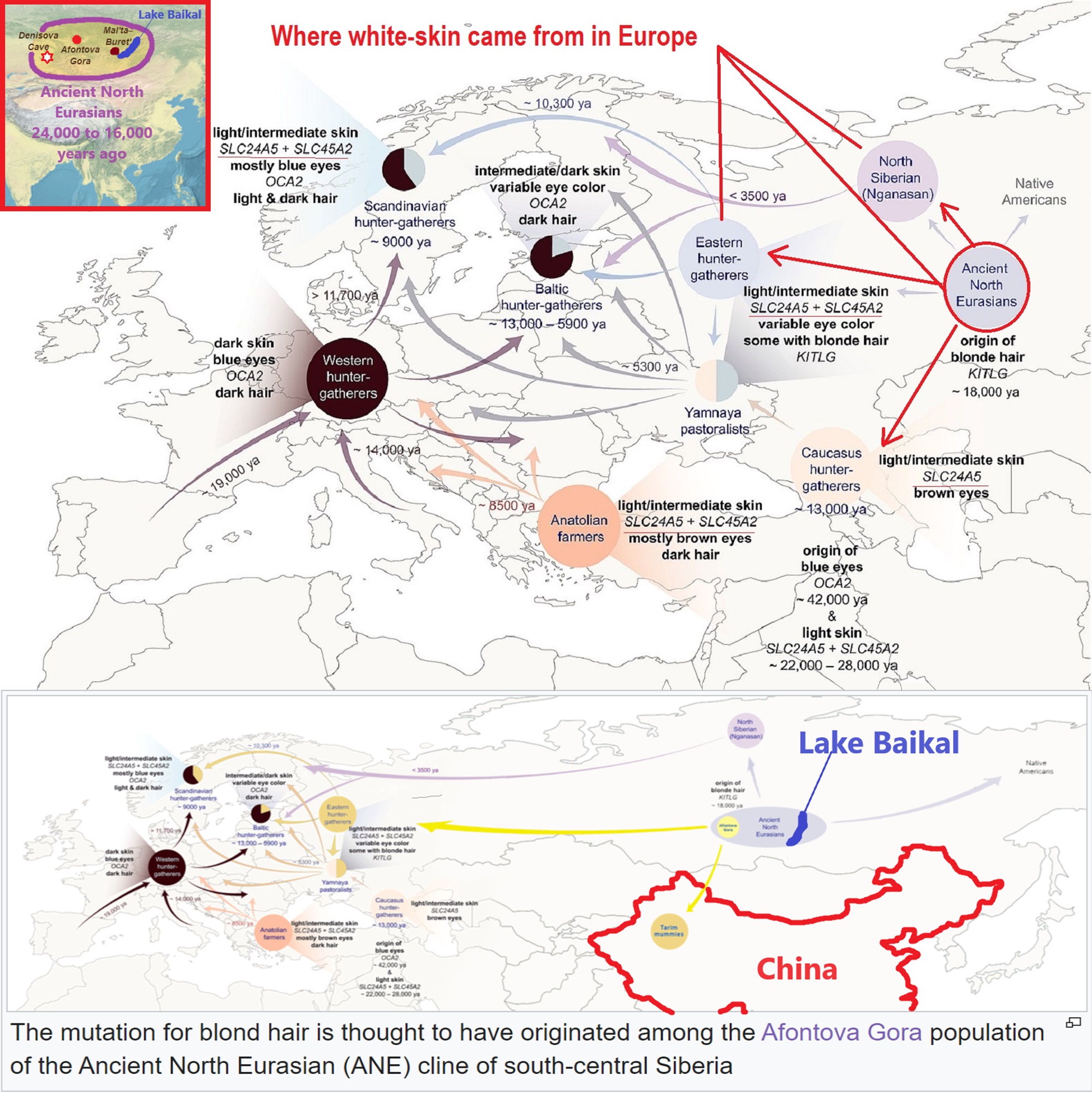
“Lighter skin and blond hair evolved in the Ancient North Eurasian (ANE) population. The SLC24A5 gene’s derived threonine or Ala111Thr allele (rs1426654) has been shown to be a major factor in the light skin tone of Europeans. Possibly originating as long as 19,000 years ago, it has been the subject of selection in the ancestors of Europeans as recently as within the last 5,000 years, and is fixed in modern European populations.” ref, ref
I don’t see it as white skin being more evolved than those with dark skin, as bigots could see it, but rather it is just one of many factors that happen when the evolutionary pressures on a region like Siberia have on evolutionary changes that would not have happened if not for the different climate pressures the far north have that is not experienced in lower latitudes.
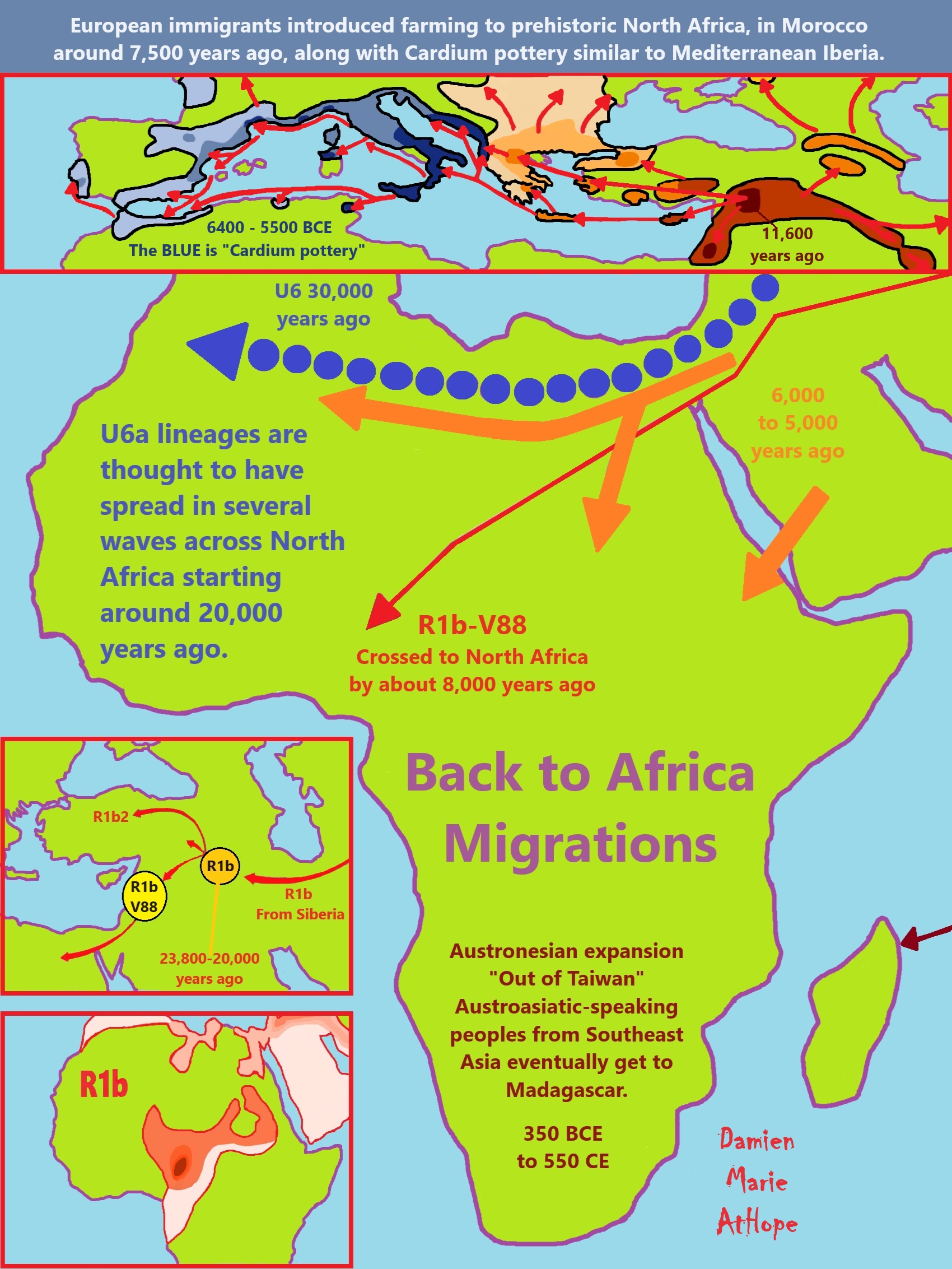
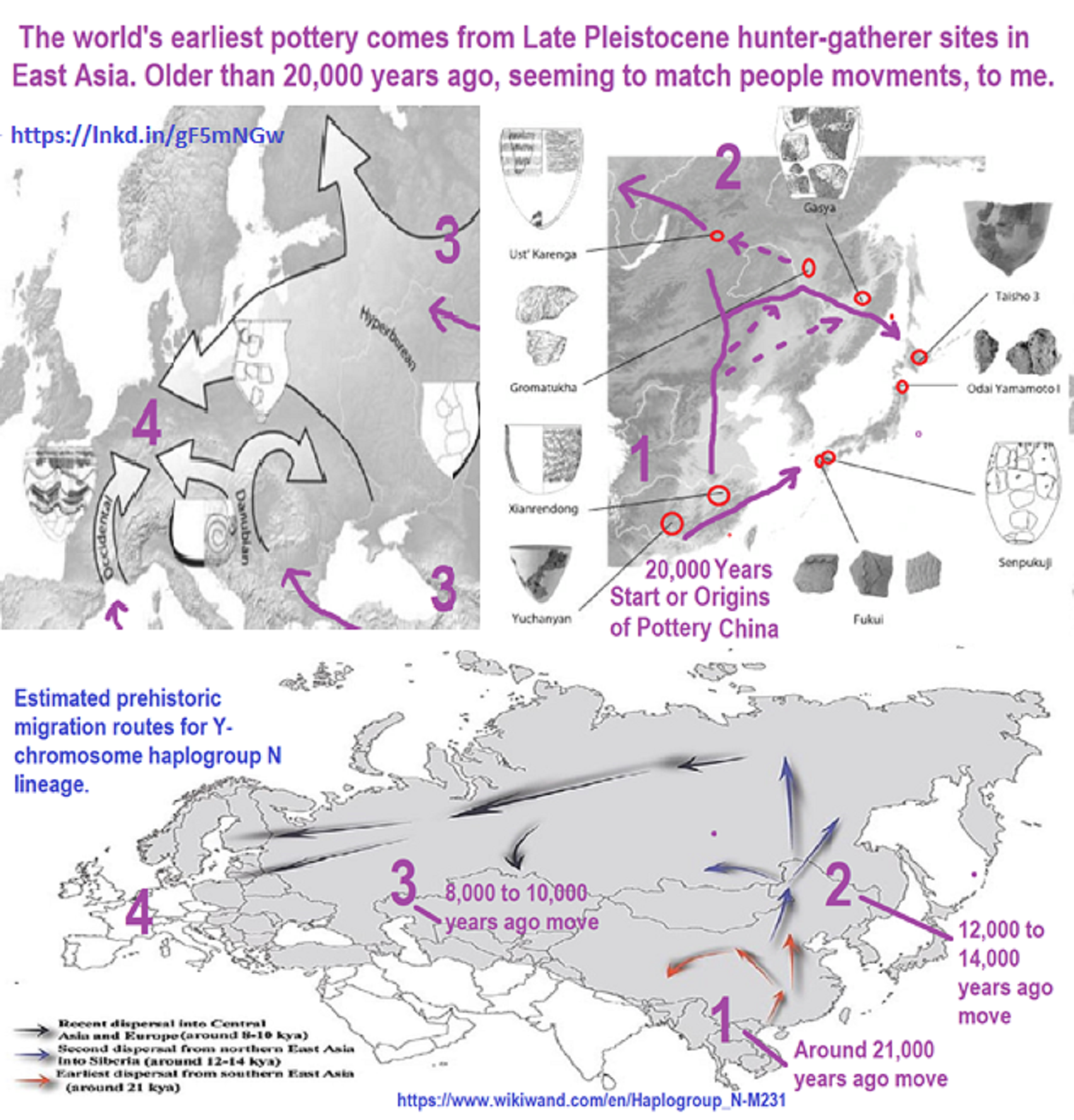
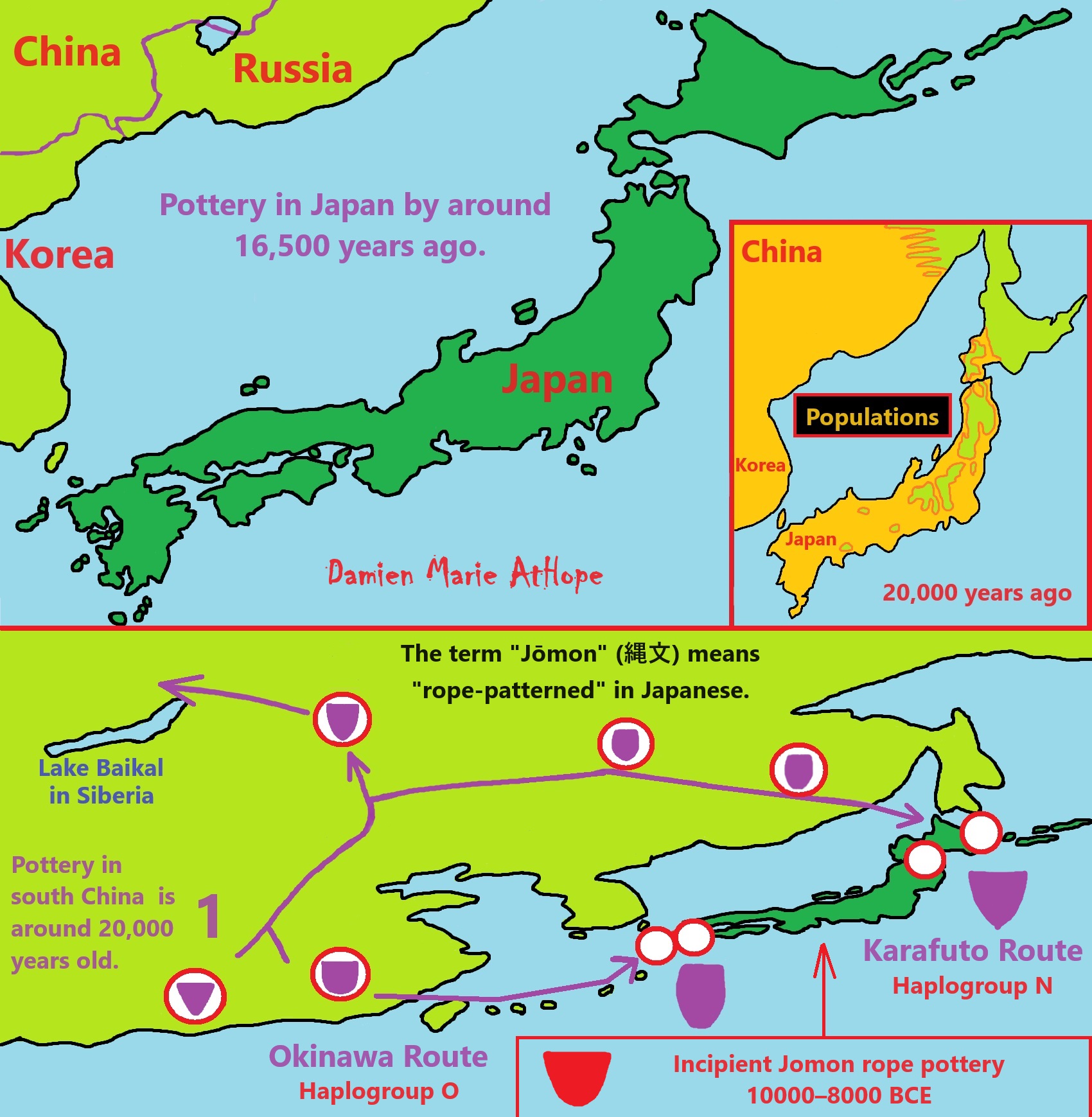
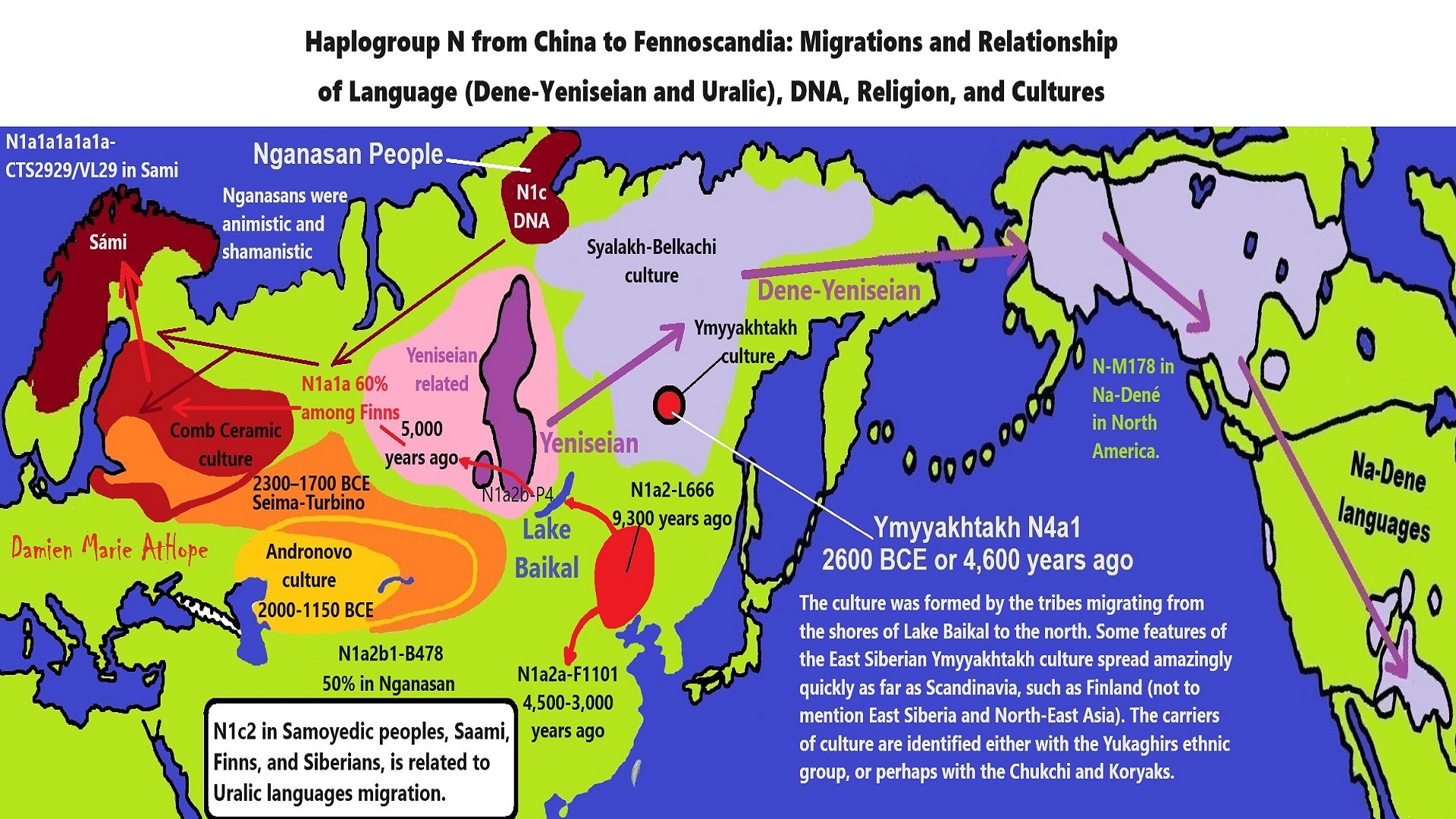
ref, ref, ref, ref, ref, ref, ref, ref, ref, ref, ref, ref, ref, ref, ref, ref
Postglacial genomes from foragers across Northern Eurasia reveal prehistoric
mobility associated with the spread of the Uralic and Yeniseian languages
Abstract
“The North Eurasian forest and forest-steppe zones have sustained millennia of sociocultural connections among northern peoples. We present genome-wide ancient DNA data for 181 individuals from this region spanning the Mesolithic, Neolithic, and Bronze Age. We find that Early to Mid-Holocene hunter-gatherer populations from across the southern forest and forest-steppes of Northern Eurasia can be characterized by a continuous gradient of ancestry that remained stable for millennia, ranging from fully West Eurasian in the Baltic region to fully East Asian in the Transbaikal region. In contrast, cotemporaneous groups in far Northeast Siberia were genetically distinct, retaining high levels of continuity from a population that was the primary source of ancestry for Native Americans. By the mid-Holocene, admixture between this early Northeastern Siberian population and groups from Inland East Asia and the Amur River Basin produced two distinctive populations in eastern Siberia that played an important role in the genetic formation of later people. Ancestry from the first population, Cis-Baikal Late Neolithic-Bronze Age (Cisbaikal_LNBA), is found substantially only among Yeniseian-speaking groups and those known to have admixed with them. Ancestry from the second, Yakutian Late Neolithic-Bronze Age (Yakutia_LNBA), is strongly associated with present-day Uralic speakers. We show how Yakutia_LNBA ancestry spread from an east Siberian origin ~4.5kya, along with subclades of Y-chromosome haplogroup N occurring at high frequencies among present-day Uralic speakers, into Western and Central Siberia in communities associated with Seima-Turbino metallurgy: a suite of advanced bronze casting techniques that spread explosively across an enormous region of Northern Eurasia ~4.0kya. However, the ancestry of the 16 Seima-Turbino-period individuals–the first reported from sites with this metallurgy–was otherwise extraordinarily diverse, with partial descent from Indo-Iranian-speaking pastoralists and multiple hunter-gatherer populations from widely separated regions of Eurasia. Our results provide support for theories suggesting that early Uralic speakers at the beginning of their westward dispersal where involved in the expansion of Seima-Turbino metallurgical traditions, and suggests that both cultural transmission and migration were important in the spread of Seima-Turbino material culture.” ref
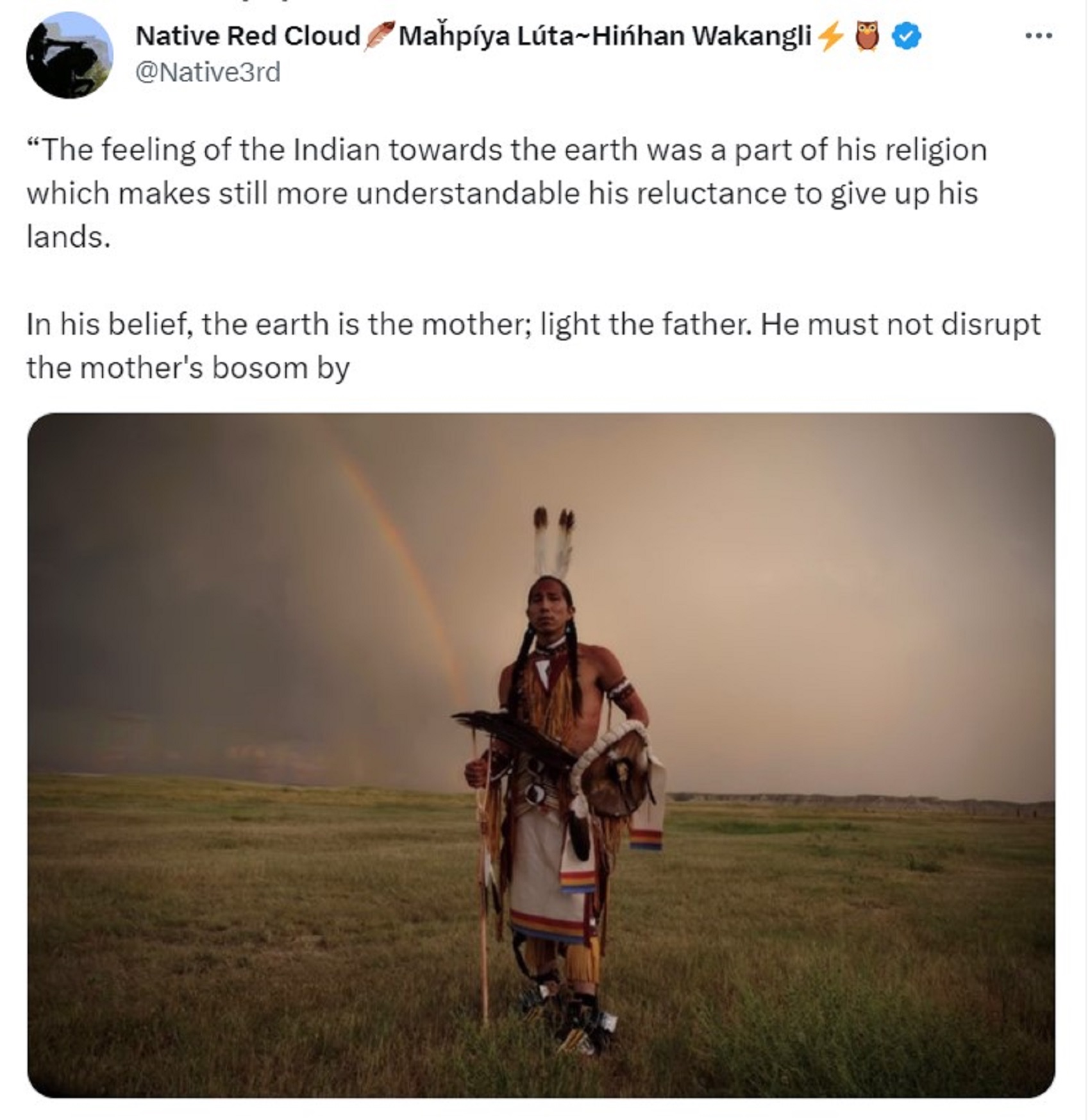
“Yurok religion comprised of rituals and ceremonies performed to honor their Creator (Sky Father) and Mother Earth for providing them their daily means of livelihood. Women functioned as shamans or doctors who healed people of their illnesses.” ref
“the earth is the mother; light the father” So… Sky Father and Earth Mother
“The Ojibwe religion infiltrated into every part of life, believing in only one Supreme Being, Gitchie Manitou, The Creator, whose mighty power governs and directs the beginning and end of all things. Gitche Manitou (Gitchi Manitou, Kitchi Manitou, etc.) means “Great Spirit” in several Algonquian languages. In addition to the Algonquian Anishinaabeg, many other tribes believed in Gitche Manitou. References to the Great Manitou by the Cheyenne and the Oglala Sioux (notably in the recollections of Black Elk), indicate that belief in this deity extended into the Great Plains, fully across the wider group of Algonquian peoples.” ref, ref
So “Gitche Manitou” is a Sky God/Sky Father
So the Ojibwe people have something similar to a Sky Father and Earth Mother
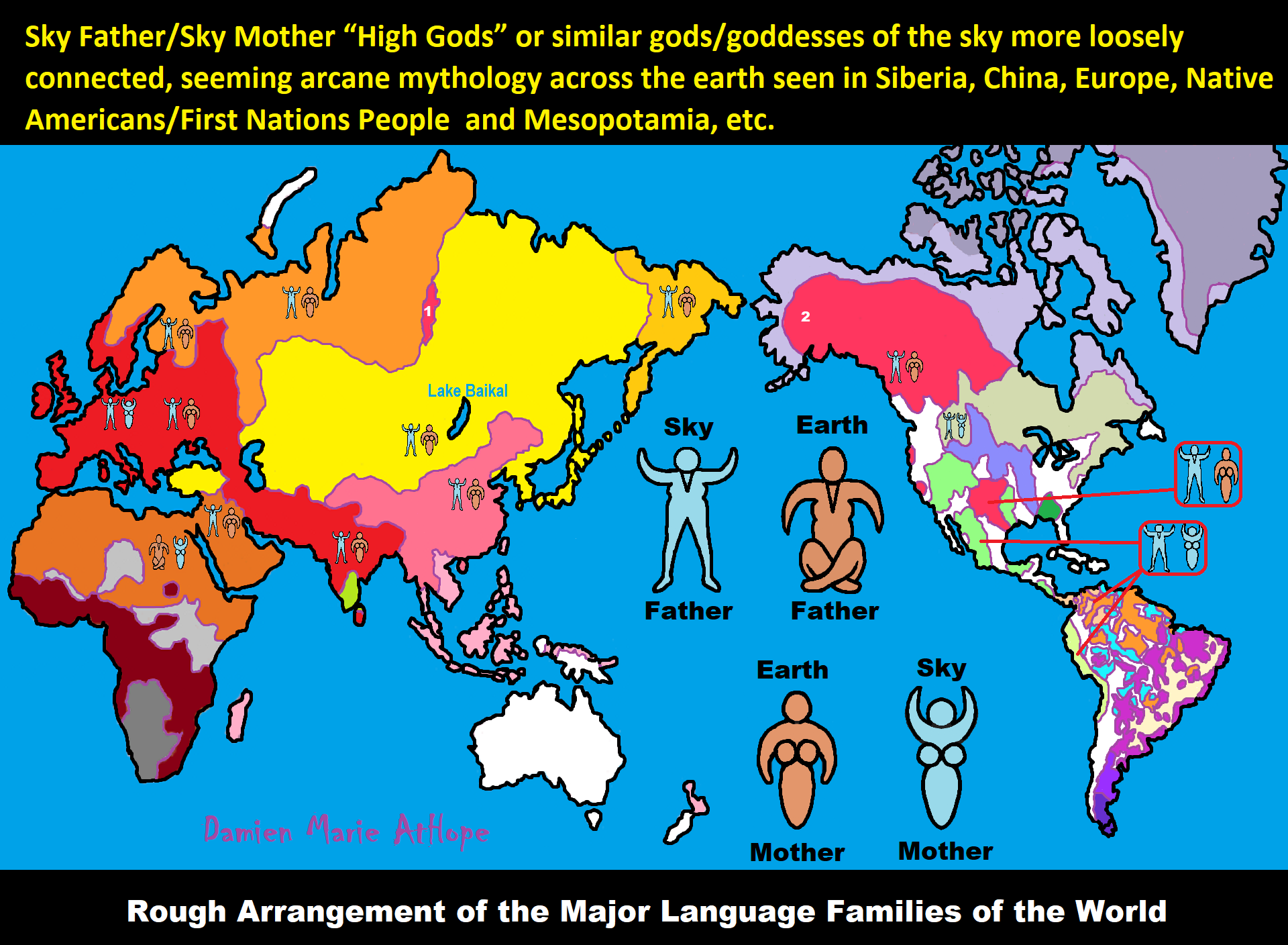
ref, ref, ref, ref, ref, ref, ref, ref, ref, ref, ref, ref, ref, ref, ref, ref, ref
“These ideas are my speculations from the evidence.”
I am still researching the “god‘s origins” all over the world. So you know, it is very complicated but I am smart and willing to look, DEEP, if necessary, which going very deep does seem to be needed here, when trying to actually understand the evolution of gods and goddesses. I am sure of a few things and less sure of others, but even in stuff I am not fully grasping I still am slowly figuring it out, to explain it to others. But as I research more I am understanding things a little better, though I am still working on understanding it all or something close and thus always figuring out more.
Sky Father/Sky God?
“Egyptian: (Nut) Sky Mother and (Geb) Earth Father” (Egypt is different but similar)
Turkic/Mongolic: (Tengri/Tenger Etseg) Sky Father and (Eje/Gazar Eej) Earth Mother *Transeurasian*
Hawaiian: (Wākea) Sky Father and (Papahānaumoku) Earth Mother *Austronesian*
New Zealand/ Māori: (Ranginui) Sky Father and (Papatūānuku) Earth Mother *Austronesian*
Proto-Indo-European: (Dyḗus/Dyḗus ph₂tḗr) Sky Father and (Dʰéǵʰōm/Pleth₂wih₁) Earth Mother
Indo-Aryan: (Dyaus Pita) Sky Father and (Prithvi Mata) Earth Mother *Indo-European*
Italic: (Jupiter) Sky Father and (Juno) Sky Mother *Indo-European*
Etruscan: (Tinia) Sky Father and (Uni) Sky Mother *Tyrsenian/Italy Pre–Indo-European*
Hellenic/Greek: (Zeus) Sky Father and (Hera) Sky Mother who started as an “Earth Goddess” *Indo-European*
Nordic: (Dagr) Sky Father and (Nótt) Sky Mother *Indo-European*
Slavic: (Perun) Sky Father and (Mokosh) Earth Mother *Indo-European*
Illyrian: (Deipaturos) Sky Father and (Messapic Damatura’s “earth-mother” maybe) Earth Mother *Indo-European*
Albanian: (Zojz) Sky Father and (?) *Indo-European*
Baltic: (Perkūnas) Sky Father and (Saulė) Sky Mother *Indo-European*
Germanic: (Týr) Sky Father and (?) *Indo-European*
Colombian-Muisca: (Bochica) Sky Father and (Huythaca) Sky Mother *Chibchan*
Aztec: (Quetzalcoatl) Sky Father and (Xochiquetzal) Sky Mother *Uto-Aztecan*
Incan: (Viracocha) Sky Father and (Mama Runtucaya) Sky Mother *Quechuan*
China: (Tian/Shangdi) Sky Father and (Dì) Earth Mother *Sino-Tibetan*
Sumerian, Assyrian and Babylonian: (An/Anu) Sky Father and (Ki) Earth Mother
Finnish: (Ukko) Sky Father and (Akka) Earth Mother *Finno-Ugric*
Sami: (Horagalles) Sky Father and (Ravdna) Earth Mother *Finno-Ugric*
Puebloan-Zuni: (Ápoyan Ta’chu) Sky Father and (Áwitelin Tsíta) Earth Mother
Puebloan-Hopi: (Tawa) Sky Father and (Kokyangwuti/Spider Woman/Grandmother) Earth Mother *Uto-Aztecan*
Puebloan-Navajo: (Tsohanoai) Sky Father and (Estsanatlehi) Earth Mother *Na-Dene*
ref, ref, ref, ref, ref, ref, ref, ref, ref, ref, ref, ref, ref, ref, ref, ref, ref, ref, ref, ref, ref, ref, ref, ref, ref, ref, ref
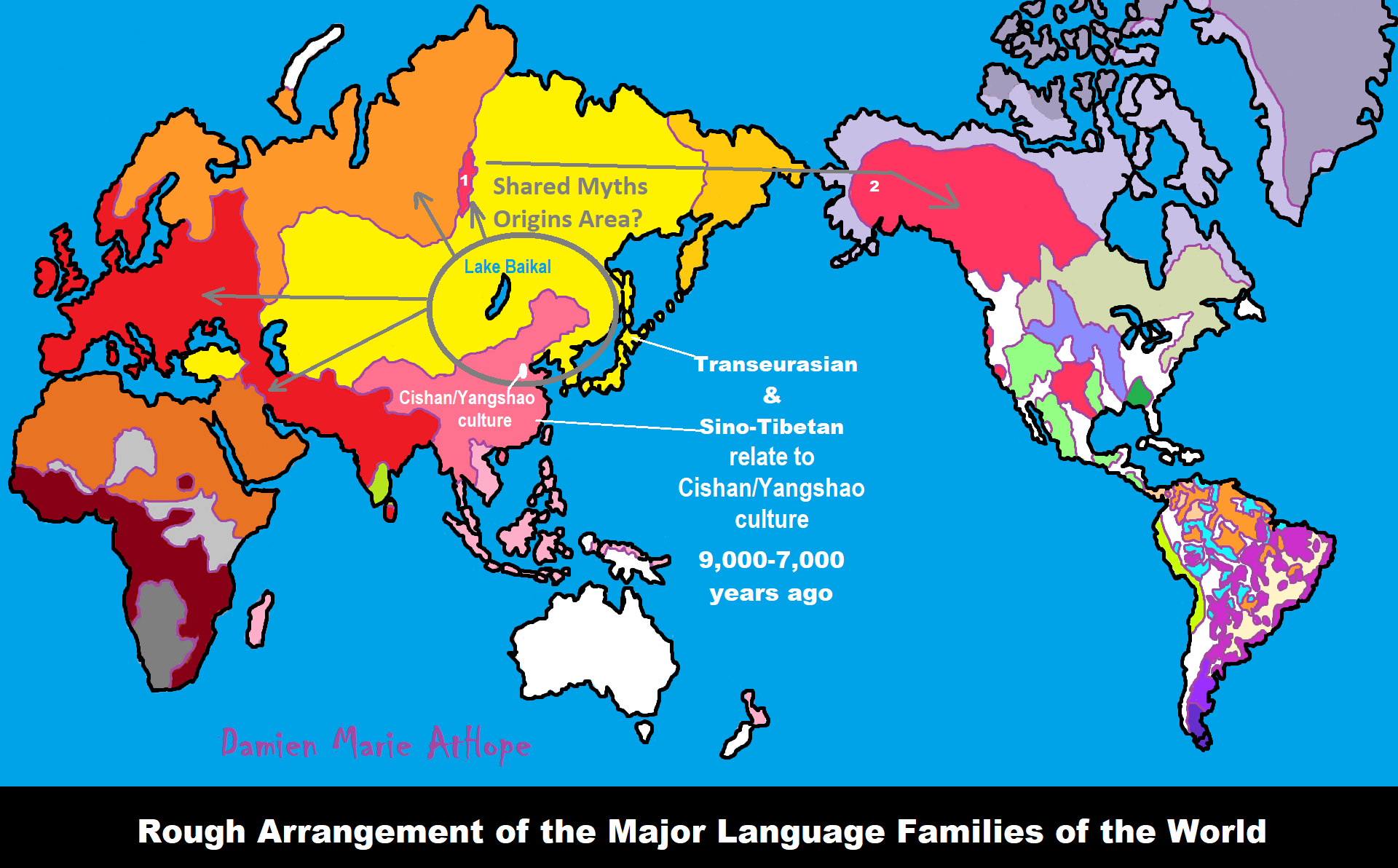
“Following World War II, nomadic indigenous groups in Siberia were forced to settle into one place. This practice is called involuntary sedentism. From age 2, indigenous children had to attend boarding schools where they could not speak their indigenous language. Students could be taken from their families if their parents refused to send them to boarding school. Students learned Russian language and Russian culture far away from their families and were not able to talk with them during the school year. By the mid-1980s, children were allowed to return to their home communities thanks to the new openness or glasnost policies of the USSR. For the first time, people were able to openly talk about the problems of boarding schools and of children not being able to live with their families.” ref

- My Thoughts on the Mal’ta–Buret’ culture‘s Ancient North Eurasian “R” (Y-DNA) Migrations and its Possible relations/influence on Afroasiatic and Proto-Indo-European languages
- My Thoughts on Possible Migrations of “R” DNA and Proto-Indo-European?
- Proto-Indo-European (PIE), ancestor of Indo-European languages: DNA, Society, Language, and Mythology
- Yamnaya culture or at least Proto-Indo-European Languages/Religions may actually relate back to North Asia?
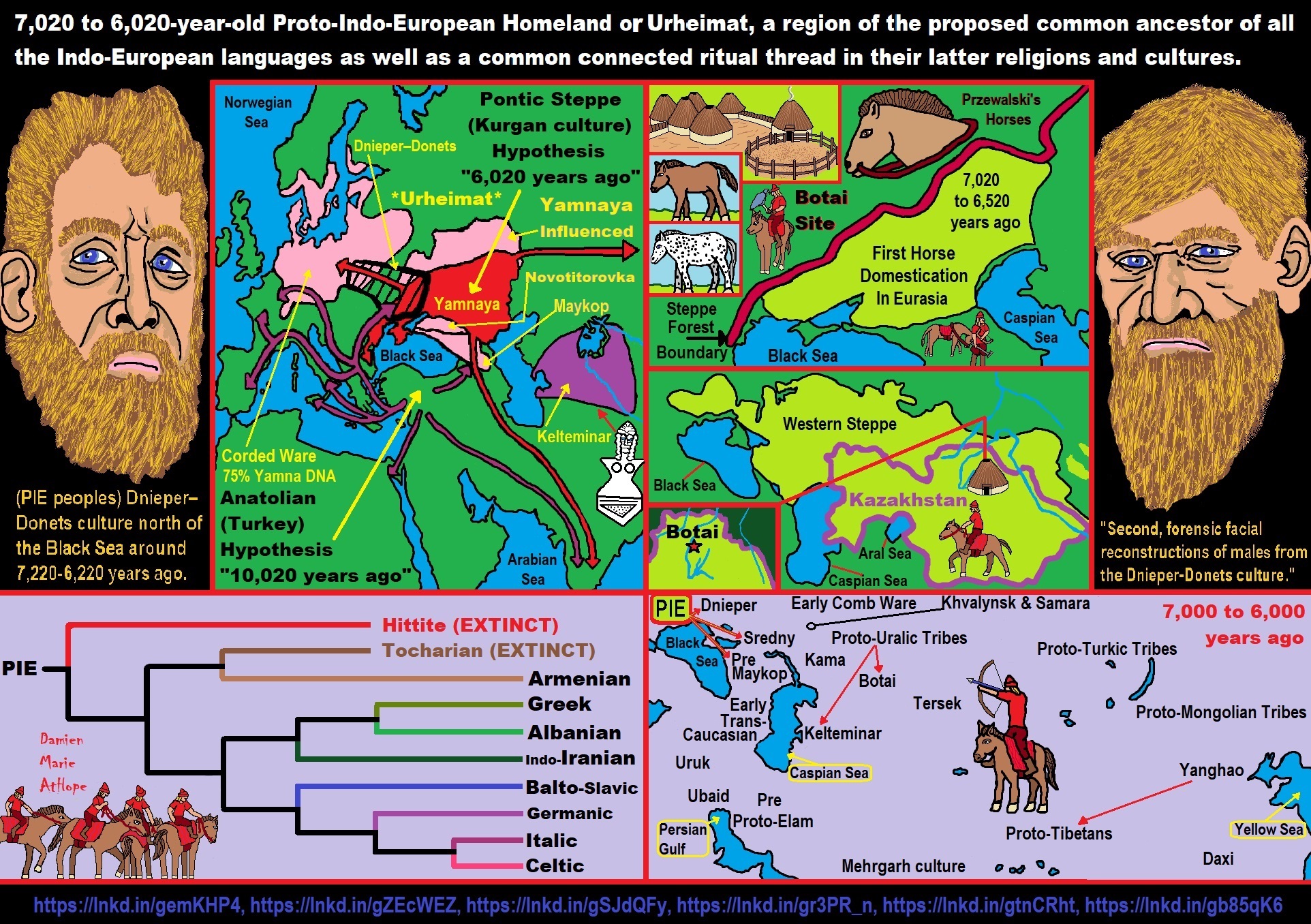
ref, ref, ref, ref, ref, ref, ref, ref, ref, ref, ref, ref, ref, ref
- Indo-European language Trees fit an Agricultural expansion from Anatolia beginning 8,000 – 9,500 years ago?
- 7,020 to 6,020-year-old Proto-Indo-European Homeland of Urheimat or proposed home of their Language and Religion
- Understanding Proto-Indo-Europeans and Paganism Religions
- Hell and Underworld mythologies starting maybe as far back as 7,000 to 5,000 years ago with the Proto-Indo-Europeans?
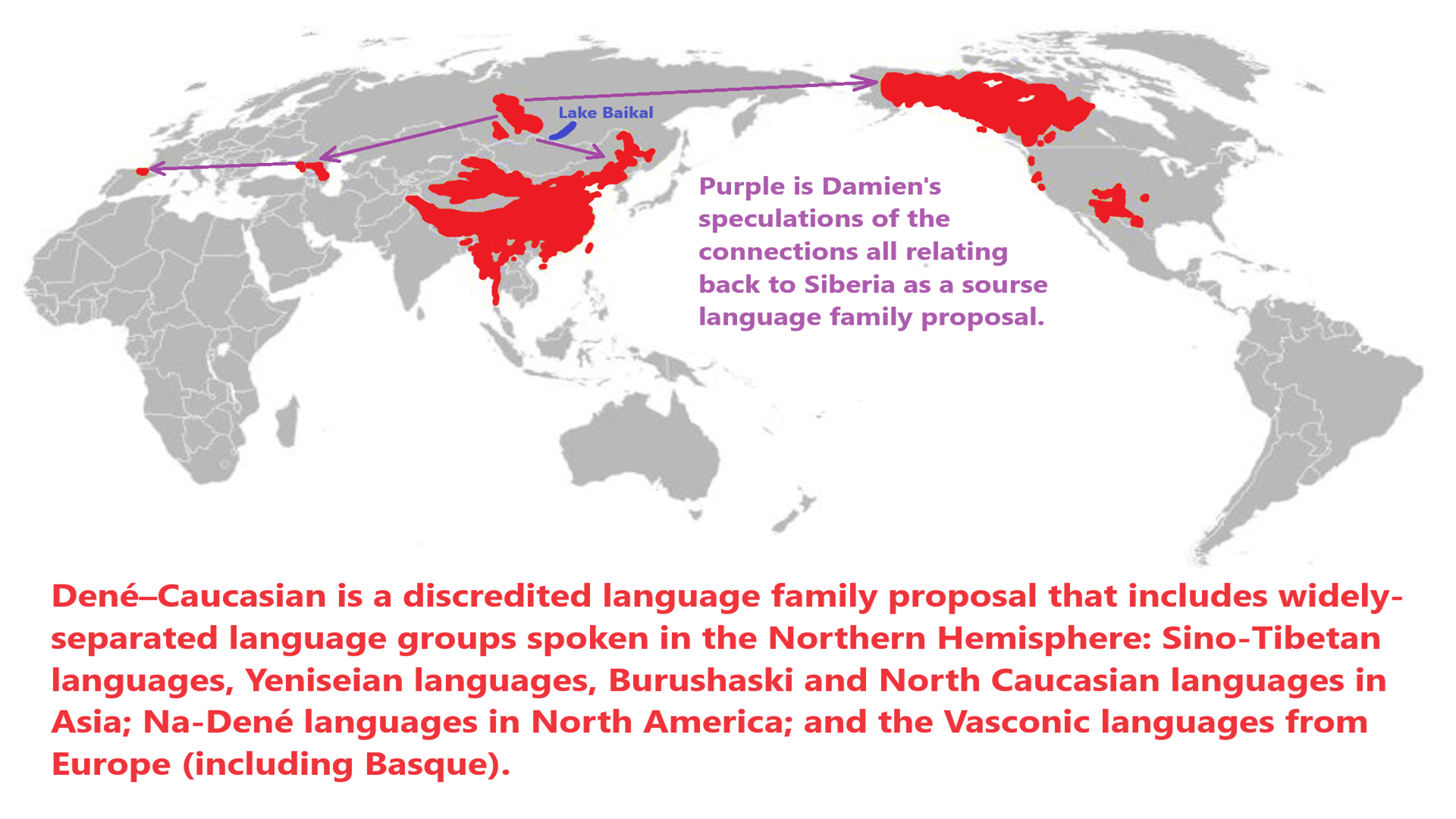
“Dené–Caucasian is a discredited language family proposal that includes widely-separated language groups spoken in the Northern Hemisphere: Sino-Tibetan languages, Yeniseian languages, Burushaski and North Caucasian languages in Asia; Na-Dené languages in North America; and the Vasconic languages from Europe (including Basque). A narrower connection specifically between North American Na-Dené and Siberian Yeniseian (the Dené–Yeniseian languages hypothesis) was proposed by Edward Vajda in 2008, and has met with some acceptance within the community of professional linguists. The validity of the rest of the family, however, is viewed as doubtful or rejected by nearly all historical linguists.” ref
“The Dené–Caucasian family tree and approximate divergence dates (estimated by modified glottochronology) proposed by S. A. Starostin and his colleagues from the Tower of Babel project:
- Dené–Caucasian languages [8,700 BCE or around 10,700 years ago]
- Na-Dené languages (Athabascan–Eyak–Tlingit)
- Sino-Vasconic languages [7,900 BCE or around 9,900 years ago]
- Vasconic (see below)
- Sino-Caucasian languages [6,200 BCE or around 8,200 years ago]
- Burushaski
- Caucaso-Sino-Yeniseian [5,900 BCE or around 7,900 years ago]
- North Caucasian languages
- Sino-Yeniseian [5,100 BCE or around 7,100 years ago]
“John D. Bengtson groups Basque, Caucasian and Burushaski together in a Macro-Caucasian (earlier Vasco-Caucasian) family (see the section on Macro-Caucasian below). According to him, it is as yet premature to propose other nodes or subgroupings, but he notes that Sumerian seems to share the same number of isoglosses with the (geographically) western branches as with the eastern ones:
- Dené–Caucasian
- The Macro-Caucasian family
- Basque
- North Caucasian
- Burushaski
- Sumerian
- Sino-Tibetan
- Yeniseian
- Na-Dené” ref
- The Macro-Caucasian family
“It has been conjectured that the North-West Caucasian languages may be genetically related to the Indo-European family, at a time depth of perhaps 12,000 years before the present. This hypothesized proto-language is called Proto-Pontic, but is not widely accepted. There does at least appear to have been extensive contact between the two proto-languages, and the resemblances may be due to this influence. A few linguists have proposed even broader relationships, of which the Dene–Caucasian hypothesis is perhaps the most popular. Dene–Caucasian links the North Caucasian (including Northwest Caucasian), Basque, Burushaski, Yeniseian, Sino-Tibetan, and Na–Dene families. However, this is an even more tentative hypothesis than Nostratic, which attempts to relate Kartvelian, Indo-European, Uralic, and Altaic, etc., and which is widely considered to be undemonstrated.” ref
“Nostratic is a hypothetical language macrofamily including many of the language families of northern Eurasia. Though a historically important proposal, in a contemporary context it is typically considered a fringe theory. Although the exact composition varies based on proponent, it typically comprises Kartvelian, Indo-European and Uralic languages; some languages from the similarly controversial Altaic family; the Afroasiatic languages; as well as the Dravidian languages (sometimes also Elamo-Dravidian).” ref
“Iran Neolithic (Iran_N) individuals dated ~8,500 years ago carried 50% Ancient North Eurasian-derived admixture and 50% Dzudzuana-related admixture, marking them as different from other Near-Eastern and Anatolian Neolithics who didn’t have Ancient North Eurasian admixture. Iran Neolithics were later replaced by Iran Chalcolithics, who were a mixture of Iran Neolithic and Near Eastern Levant Neolithic.” ref
I speculate that possibly this “Iran Neolithic” difference is a later migration relating to Ancient North Eurasian admixture, with the source languages from Siberia (pre-proto-indo-europeain, like some kind of pre/proto-Yeniseian, or Dené–Yeniseian languages/or Dené–Caucasian) that then merged into proto-indo-European languages seen just west of Iran in the Caucasus and East Turkey areas. Also, I speculate that the idea of pottery was likewise brought by these peoples and they, to me could have influenced the creation of the earliest pottery in Tell Hassuna and Jarmo (Iraq).
“Proto-Yeniseian or Proto-Yeniseic is the unattested reconstructed proto-language from which all Yeniseian languages are thought to descend from. It is uncertain whether Proto-Yeniseian had a similar tone/pitch accent system as Ket people, who practiced Shamanism and connected to Tengrism. Many studies about Proto-Yeniseian phonology have been done, however there are still many things unclear about Proto-Yeniseian. The probable location of the Yeniseian homeland is proposed on the basis of geographic names and genetic studies, which suggests a homeland in Southern Siberia.” ref
“Tengri (Old Turkic: 𐰚𐰇𐰚:𐱅𐰭𐰼𐰃, romanized: Kök Teŋri/Teŋiri, lit. ’Blue Heaven’; Old Uyghur: tängri; Middle Turkic: تآنغرِ; Ottoman Turkish: تڭری; Kyrgyz: Теңир; Kazakh: Тәңір; Turkish: Tanrı; Azerbaijani: Tanrı; Bulgarian: Тангра; Proto-Turkic *teŋri / *taŋrɨ; Mongolian script: ᠲᠩᠷᠢ, T’ngri; Mongolian: Тэнгэр, Tenger; Uyghur: تەڭرى tengri ) is the all-encompassing God of Heaven in the traditional Turkic, Yeniseian, Mongolic, and various other nomadic Altaic religious beliefs. Tengri is not considered a deity in the usual sense, but a personification of the universe. However, some qualities associated with Tengri as the judge and source of life, and being eternal and supreme, led European and Muslim writers to identify Tengri as a deity of Turkic and Mongolic peoples. According to Mongolian belief, Tengri’s will (jayayan) may break its own usual laws and intervene by sending a chosen person to earth. It is also one of the terms used for the primary chief deity of the early Turkic and Mongolic peoples. Worship surrounding Tengri is called Tengrism. The core beings in Tengrism are the Sky Father (Tenger Etseg) and the Earth Mother (Umay Ana). It involves ancestor worship, as Tengri was thought to have been the ancestral progenitor of mankind in Turkic regions and Mongolia, shamanism, animism, and totemism.” ref
“Tengrism (also known as Tengriism, Tengerism, or Tengrianism) is a religion originating in the Eurasian steppes, based on shamanism and animism. It generally involves the titular sky god Tengri, who is not considered a deity in the usual sense but a personification of the universe. According to some scholars, adherents of Tengrism view the purpose of life to be in harmony with the universe. It was the prevailing religion of the Göktürks, Xianbei, Bulgars, Xiongnu, Yeniseian, and Mongolic peoples and Huns, as well as the state religion of several medieval states: the First Turkic Khaganate, the Western Turkic Khaganate, the Eastern Turkic Khaganate, Old Great Bulgaria, the First Bulgarian Empire, Volga Bulgaria, Khazaria, and the Mongol Empire. In the Irk Bitig, a ninth century manuscript on divination, Tengri is mentioned as Türük Tängrisi (God of Turks). According to many academics, Tengrism was, and to some extent still is, a predominantly polytheistic religion based on the shamanistic concept of animism, and was first influenced by monotheism during the imperial period, especially by the 12th–13th centuries. Abdulkadir Inan argues that Yakut and Altai shamanism are not entirely equal to the ancient Turkic religion.” ref
“The term also describes several contemporary Turkic and Mongolic native religious movements and teachings. All modern adherents of “political” Tengrism are monotheists. Tengrism has been advocated for in intellectual circles of the Turkic nations of Central Asia (Kyrgyzstan with Kazakhstan) and Russia (Tatarstan, Bashkortostan) since the dissolution of the Soviet Union during the 1990s. Still practiced, it is undergoing an organized revival in Buryatia, Sakha (Yakutia), Khakassia, Tuva and other Turkic nations in Siberia. Altaian Burkhanism and Chuvash Vattisen Yaly are contemporary movements similar to Tengrism. The term tengri (compare with Kami) can refer to the sky deity Tenger Etseg – also Gök Tengri; Sky father, Blue sky – or to other deities. While Tengrism includes the worship of personified gods (tngri) such as Ülgen and Kaira,Tengri is considered an “abstract phenomenon”. In Mongolian folk religion, Genghis Khan is considered one of the embodiments, if not the main embodiment, of Tengri’s will. The forms of the name Tengri (Old Turkic: Täŋri) among the ancient and modern Turkic and Mongolic are Tengeri, Tangara, Tangri, Tanri, Tangre, Tegri, Tingir, Tenkri, Tangra, Teri, Ter, and Ture. The name Tengri (“the Sky”) is derived from Old Turkic: Tenk (“daybreak”) or Tan (“dawn”). Meanwhile, Stefan Georg proposed that the Turkic Tengri ultimately originates as a loanword from Proto-Yeniseian *tɨŋgɨr- “high”. Mongolia is sometimes poetically called the “Land of Eternal Blue Sky” (Mönkh Khökh Tengeriin Oron) by its inhabitants. According to some scholars, the name of the important deity Dangun (also Tangol) (God of the Mountains) of the Korean folk religion is related to the Siberian Tengri (“Heaven”), while the bear is a symbol of the Big Dipper (Ursa Major).” ref
“Tiān (天) is one of the oldest Chinese terms for heaven and a key concept in Chinese mythology, philosophy, and religion. During the Shang dynasty (17th―11th century BCE), the Chinese referred to their highest god as Shàngdì (上帝, “Lord Above”) or Dì (帝, “Lord”). During the following Zhou dynasty, Tiān became synonymous with this figure. Before the 20th century, worship of Tiān was an orthodox state religion of China. In Chinese culture, heaven tends to be “synonymous with order”, “containing the blueprints for creation”, “the mandate by which earthly rulers govern, and the standards by which to measure beauty, goodness, and truth.” Zhou dynasty nobles made the worship of heaven a major part of their political philosophy and viewed it as “many gods” who embodied order and kingship, as well as the mandate of heaven. For the etymology of tiān, Schuessler links it with the Mongolian word tengri “sky, heaven, heavenly deity” or the Tibeto-Burman words taleŋ (Adi) and tǎ-lyaŋ (Lepcha), both meaning “sky”. He also suggests a likely connection between Chinese tiān 天, diān 巔 “summit, mountaintop”, and diān 顛 “summit, top of the head, forehead”, which have cognates such as Zemeic Naga tiŋ “sky”. However, other reconstructions of 天’s OC pronunciation *qʰl’iːn or *l̥ˤi[n] reconstructed a voiceless lateral onset, either a cluster or a single consonant, respectively. Baxter & Sagart pointed to attested dialectal differences in Eastern Han Chinese, the use of 天 as a phonetic component in phono-semantic compound Chinese characters, and the choice of 天 to transcribe foreign syllables, all of which prompted them to conclude that, around 200 CE, 天’s onset had two pronunciations: coronal *tʰ & dorsal *x, both of which likely originated from an earlier voiceless lateral *l̥ˤ.” ref
“In Taoism and Confucianism, Tiān (the celestial aspect of the cosmos, often translated as “Heaven“) is mentioned in relationship to its complementary aspect of Dì (地, often translated as “Earth“). They are thought to maintain the two poles of the Three Realms (三界) of reality, with the middle realm occupied by Humanity (人, rén), and the lower world occupied by demons (魔, mó) and “ghosts”, the damned, (鬼, guǐ). Tiān was variously thought as a “supreme power reigning over lesser gods and human beings” that brought “order and calm…or catastrophe and punishment”, a god, destiny, an “impersonal” natural force that controlled various events, a holy world or afterlife containing other worlds or afterlives, or one or more of these. “Confucianism has a religious side with a deep reverence for Heaven and Earth (Di), whose powers regulate the flow of nature and influence human events.” Yin and yang are also thought to be integral to this relationship and permeate both, as well as humans and man-made constructs. This “cosmos” and its “principles” is something that “[t]he ways of man should conform to, or else” frustration will result. Many Confucianists, both historically and in current times, use the I Ching to divine events through the changes of Tiān and other “natural forces”. Historical and current Confucianists were/are often environmentalists out of their respect for Heaven and the other aspects of nature and the “Principle” that comes from their unity and, more generally, harmony as a whole, which is “the basis for a sincere mind.” The Emperor of China as Tianzi was formerly vital to Confucianism. Mount Tai is seen as a sacred place in Confucianism and was traditionally the most revered place where Chinese emperors offered sacrifices to heaven and earth. Some tiān in Chinese folk religion were thought to be many different or a hierarchy of multiple, sphere-like realms that contained morally ambiguous creatures and spirits such as huli jing and fire-breathing dragons. ” ref
“Paleo-Siberian languages, languages spoken in Asian Russia (Siberia) that belong to four genetically unrelated groups—Yeniseian, Luorawetlan, Yukaghir, and Nivkh.” ref
Proto-Indo-European mythology
“Proto-Indo-European mythology is the body of myths and deities associated with the Proto-Indo-Europeans, speakers of the hypothesized Proto-Indo-European language. Although the mythological motifs are not directly attested – since Proto-Indo-European speakers lived in preliterate societies – scholars of comparative mythology have reconstructed details from inherited similarities found among Indo-European languages, based on the assumption that parts of the Proto-Indo-Europeans’ original belief systems survived in the daughter traditions. The Proto-Indo-European pantheon includes a number of securely reconstructed deities, since they are both cognates – linguistic siblings from a common origin – and associated with similar attributes and body of myths: such as *Dyḗws Ph₂tḗr, the daylight-sky god; his consort *Dʰéǵʰōm, the earth mother; his daughter *H₂éwsōs, the dawn goddess; his sons the Divine Twins; and *Seh₂ul and *Meh₁not, a solar goddess and moon god, respectively. Some deities, like the weather god *Perkʷunos or the herding-god *Péh₂usōn, are only attested in a limited number of traditions – Western (i.e. European) and Graeco-Aryan, respectively – and could therefore represent late additions that did not spread throughout the various Indo-European dialects.” ref
“Some myths are also securely dated to Proto-Indo-European times, since they feature both linguistic and thematic evidence of an inherited motif: a story portraying a mythical figure associated with thunder and slaying a multi-headed serpent to release torrents of water that had previously been pent up; a creation myth involving two brothers, one of whom sacrifices the other in order to create the world; and probably the belief that the Otherworld was guarded by a watchdog and could only be reached by crossing a river. Various schools of thought exist regarding possible interpretations of the reconstructed Proto-Indo-European mythology. The main mythologies used in comparative reconstruction are Indo-Iranian, Baltic, Roman, and Norse, often supported with evidence from the Celtic, Greek, Slavic, Hittite, Armenian, Illyrian, and Albanian traditions as well.” ref
“Early agricultural communities such as Chogha Golan in 10,000 BCE or around 12,000 years ago, along with settlements such as Chogha Bonut (the earliest village in Elam) in 8000 BCE or around 10,000 years ago, began to flourish in and around the Zagros Mountains region in western Iran. Around about the same time, the earliest-known clay vessels and modeled human and animal terracotta figurines were produced at Ganj Dareh, also in western Iran. There are also 10,000-year-old human and animal figurines from Tepe Sarab in Kermanshah Province among many other ancient artifacts.” ref
I also speculate that there may be a connection with this to the earliest pottery in Turkey from Boncuklu Höyük as well.
“12 fired clay samples and an unfired marl sample from the late 9th and early 8th-millennium BCE site of Boncuklu Höyük (8300–7800 cal BCE or around 10,300 to 9,800 years ago) in the Konya Plain, Turkey. The clay vessels from Boncuklu Höyük, an early Neolithic site in central Anatolia, are much earlier than the accepted date for the introduction of pottery in Anatolia, c. 7000 cal BCE or around 9,000 years ago.” ref
Proto-Indo-European (PIE) is the reconstructed common ancestor of the Indo-European language family:
| Subdivisions |
|---|
“Western Iran was inhabited by a population genetically most similar to hunter-gatherers from the Caucasus, but distinct from the Neolithic Anatolian people who later brought food production into Europe. While some degree of cultural diffusion between Anatolia, Western Iran, and other neighboring regions is possible, the genetic dissimilarity between early Anatolian farmers and the inhabitants of Ganj Dareh supports a model in which Neolithic societies in these areas were distinct. The genome of an early Neolithic female from Ganj Dareh, GD13a, from the Central Zagros (Western Iran), dated to 10000-9700 cal years ago, a region located at the eastern edge of the Near East. Ganj Dareh is well known for providing the earliest evidence of herd management of goats beginning at 9,900 years ago. The mitochondrion of GD13a (91.74X) was assigned to haplogroup X, most likely to the subhaplogroup X2, which has been associated with an early expansion from the Near East and has been found in early Neolithic samples from Anatolia, Hungary, and Germany. GD13a did not cluster with any other early Neolithic individual from Eurasia in any of the analyses. Also genetically close to GD13a were ancient samples from Steppe populations (Yamanya & Afanasievo) that were part of one or more Bronze age migrations into Europe, as well as early Bronze age cultures in that continent (Corded Ware), in line with previous relationships observed for the Caucasus Hunter-Gatherers.” ref
“Subclade X2 appears to have undergone extensive population expansion and dispersal around or soon after the Last Glacial Maximum, roughly 20,000 years ago. It is more strongly represented in the Near East, the Caucasus, and southern Europe, and somewhat less strongly present in the rest of Europe. The highest concentrations are found in the Ojibwe (25%), Sioux (15%), Nuu-Chah-Nulth (12%), Georgia (8%), Orkney (7%), and amongst the Druze Assyrian community in Israel (27%). Subclades of X2 are not present in South Americans Amerindian populations. The oldest known human associated with X2 is Kennewick Man, whose c. 9000-year old remains were discovered in Washington State. The lineage of haplogroup X in the Americas is not derived from a European subclade, but rather represents an independent subclade, labeled X2a. The X2a subclade has not been found in Eurasia, and has most likely arisen within the early Paleo-Indian population, at roughly 13,000 years ago. A basal variant of X2a was found in the Kennewick Man fossil (ca. 9,000 years ago). No presence of mt-DNA ancestral to X2a has been found in Europe or the Near East. New World lineages X2a and X2g are not derived from the Old World lineages X2b, X2c, X2d, X2e, and X2f, indicating an early origin of the New World lineages “likely at the very beginning of their expansion and spread from the Near East.” ref
“Although it occurs only at a frequency of about 3% for the total current indigenous population of the Americas, it is a bigger haplogroup in northern North America, where among the Algonquian peoples it comprises up to 25% of mtDNA types. It is also present in lesser percentages to the west and south of this area—among the Sioux (15%), the Nuu-chah-nulth (11%–13%), the Navajo (7%), and the Yakama (5%). In Latin America, Haplotype X6 was present in the Tarahumara 1.8% (1/53) and Huichol 20% (3/15) X6 and X7 was also found in 12% in Yanomani people. Unlike the four main Native American mtDNA haplogroups (A, B, C, D), X is not strongly associated with East Asia. The main occurrence of X in Asia discovered so far is in the Altai people in Siberia. One theory of how the X Haplogroup ended up in North America is that the people carrying it migrated from central Asia along with haplogroups A, B, C, and D, from an ancestor from the Altai Region of Central Asia. Two sequences of haplogroup X2 were sampled further east of Altai among the Evenks of Central Siberia. These two sequences belong to X2* and X2b. It is uncertain if they represent a remnant of the migration of X2 through Siberia or a more recent input.” ref
“Haplogroup X has been found in various other bone specimens that were analysed for ancient DNA, including specimens associated with the Alföld Linear Pottery (X2b-T226C, Garadna-Elkerülő út site 2, 1/1 or 100%), Linearbandkeramik (X2d1, Halberstadt-Sonntagsfeld, 1/22 or ~5%), and Iberia Chalcolithic (X2b, La Chabola de la Hechicera, 1/3 or 33%; X2b, El Sotillo, 1/3 or 33%; X2b, El Mirador Cave, 1/12 or ~8%) cultures. Abel-beth-maachah 2201 was a man who lived between 1014 and 836 BCE during the Levant Iron Age and was found in the region now known as Abel Beth Maacah, Metula, Israel. He was associated with the Galilean cultural group. His direct maternal line belonged to mtDNA haplogroup X2b. Haplogroup X has been found in ancient Assyria and ancient Egyptian mummies excavated at the Abusir el-Meleq archaeological site in Middle Egypt, which date from the late New Kingdom and Roman periods. Fossils excavated at the Late Neolithic site of Kelif el Boroud in Morocco, which have been dated to around 5,000 years old, have also been found to carry the X2 subclade.” ref
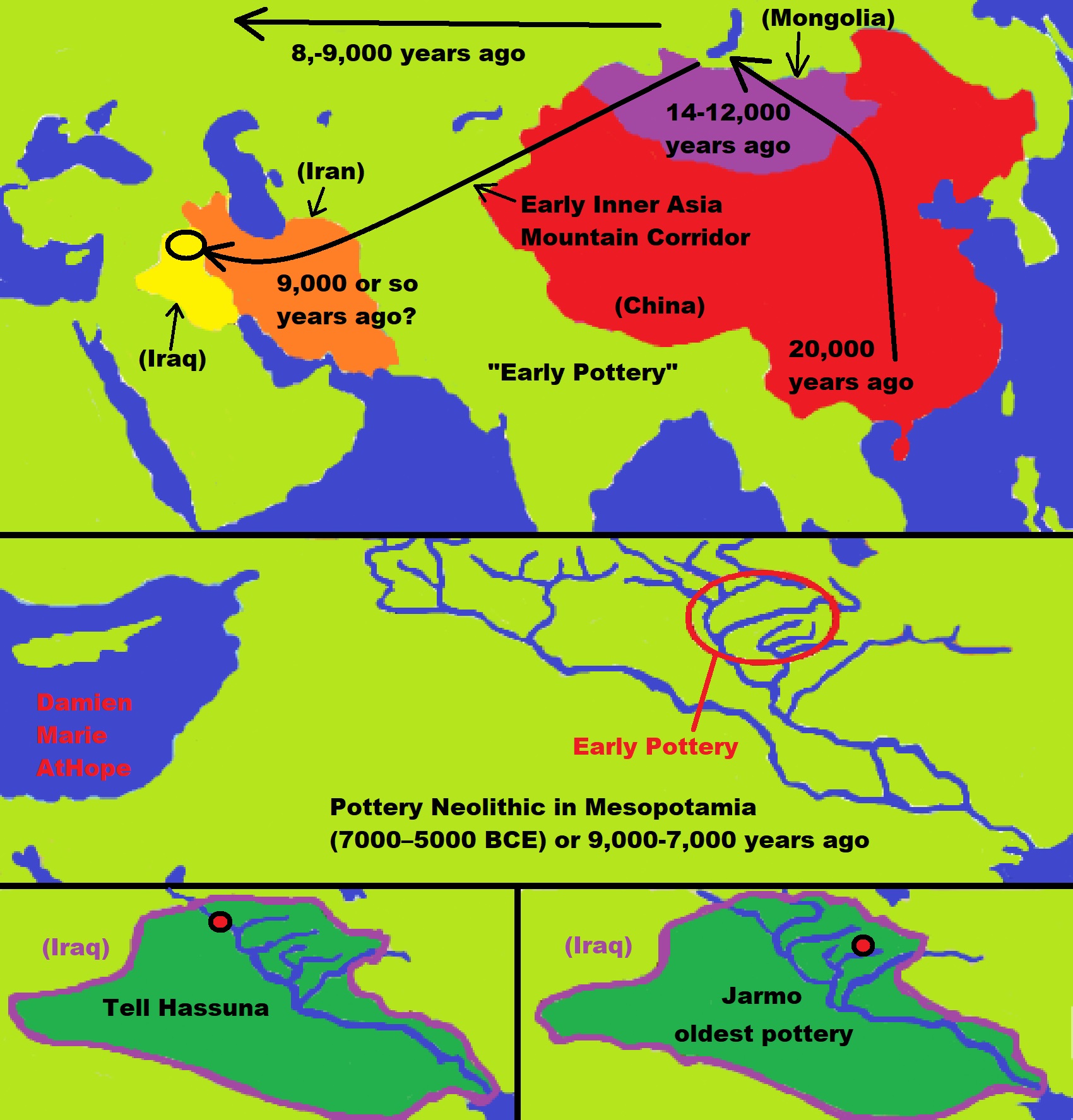
ref, ref, ref, ref, ref, ref, ref, ref, ref
Pre-Pottery Neolithic (10000 – 6500 BCE) and Pottery Neolithic (7000–5000 BCE)
PPNA /PPNB /PPNC: “Beyond the Pre-pottery Neolithic B interaction sphere” by Eleni Asouti
PPNA /PPNB /PPNC: “Our Place: Our Place in the World. Newsletter. January 2014” by Lee Clare
Animal domestication: “Subsistence and beyond: Animals in Neolithic Anatolia” by Benjamin Arbuckle
“EARLY ANIMAL PRODUCTION FOR MARITAL TRADE: A NEOLITHIC BRIDE-PRICE?” by Cedric Bodet
Pre-Pottery Neolithic
(10000 – 6500 BCE or 12,022-8,522 years ago)
“The Pre-Pottery Neolithic (PPN) represents the early Neolithic in the Levantine and upper Mesopotamian region of the Fertile Crescent, dating to c. 12,000 – c. 8,500 years ago, (10000 – 6500 BCE). It succeeds the Natufian culture of the Epipalaeolithic Near East (also called Mesolithic), as the domestication of plants and animals was in its formative stages, having possibly been induced by the Younger Dryas. The Pre-Pottery Neolithic culture came to an end around the time of the 8.2-kiloyear event, a cool spell centered on 6200 BCE that lasted several hundred years. It is succeeded by the Pottery Neolithic, also known as the Late Neolithic, or the Ceramic Neolithic” ref
“The time period is characterized by tiny circular mud-brick dwellings, the cultivation of crops, the hunting of wild game, and unique burial customs in which bodies were buried below the floors of dwellings. The Pre-Pottery Neolithic A and the following Pre-Pottery Neolithic B (PPNB) were originally defined by Kathleen Kenyon in the type site of Jericho (Palestine). During this time, pottery was not yet in use. They precede the ceramic Neolithic (Yarmukian). PPNA succeeds the Natufian culture of the Epipaleolithic (Mesolithic).” ref
“PPNA archaeological sites are much larger than those of the preceding Natufian hunter-gatherer culture, and contain traces of communal structures, such as the famous Tower of Jericho. PPNA settlements are characterized by round, semi-subterranean houses with stone foundations and terrazzo-floors. The upper walls were constructed of unbaked clay mudbricks with plano-convex cross-sections. The hearths were small and covered with cobbles. Heated rocks were used in cooking, which led to an accumulation of fire-cracked rock in the buildings, and almost every settlement contained storage bins made of either stones or mud-brick.” ref
“As of 2013 Gesher, modern Israel, became the earliest known of all known Neolithic sites (PPNA), with a calibrated Carbon 14 date of 10,459 BCE ± 348 years, analysis suggesting that it may have been the starting point of a Neolithic revolution. A contemporary site is Mureybet in modern Syria. One of the most notable PPNA settlements is Jericho, thought to be the world’s first town (c. 9,000 BCE).” ref
“The PPNA town contained a population of up to 2,000–3,000 people and was protected by a massive stone wall and tower. There is much debate over the function of the wall, for there is no evidence of any serious warfare at this time. One possibility is the wall was built to protect the salt resources of Jericho. It has also been proposed that the tower caught the shadow of the largest nearby mountain on summer solstice in order to create a sense of power in support of whatever hierarchy ruled the town’s inhabitants.” ref
“PPNA cultures are unique for their burial practices, and Kenyon (who excavated the PPNA level of Jericho) characterized them as “living with their dead”. Kenyon found no fewer than 279 burials, below floors, under household foundations, and in between walls. In the PPNB period, skulls were often dug up and reburied, or mottled with clay and (presumably) displayed. The lithic industry is based on blades struck from regular cores. Sickle-blades and arrowheads continue traditions from the late Natufian culture, transverse-blow axes, and polished adzes appear for the first time.” ref
“Sedentism of this time allowed for the cultivation of local grains, such as barley and wild oats, and for storage in granaries. Sites such as Dhra′ and Jericho retained a hunting lifestyle until the PPNB period, but granaries allowed for year-round occupation. This period of cultivation is considered “pre-domestication“, but may have begun to develop plant species into the domesticated forms they are today. Deliberate, extended-period storage was made possible by the use of “suspended floors for air circulation and protection from rodents”. This practice “precedes the emergence of domestication and large-scale sedentary communities by at least 1,000 years.” ref
“Granaries are positioned in places between other buildings early on c. 11,522 years ago, however, beginning around 10,522 years ago, they were moved inside houses, and by 9,522 years ago storage occurred in special rooms. This change might reflect changing systems of ownership and property as granaries shifted from communal use and ownership to become under the control of households or individuals.” ref
“It has been observed of these granaries that their “sophisticated storage systems with subfloor ventilation are a precocious development that precedes the emergence of almost all of the other elements of the Near Eastern Neolithic package—domestication, large scale sedentary communities, and the entrenchment of some degree of social differentiation”. Moreover, “[b]uilding granaries may […] have been the most important feature in increasing sedentism that required active community participation in new life-ways.” ref
“With more sites becoming known, archaeologists have defined a number of regional variants of Pre-Pottery Neolithic A:
- (Aswadian) in the Damascus Basin, defined by finds from Tell Aswad IA; typical: bipolar cores, big sickle blades, Aswad points. The ‘Aswadian’ variant recently was abolished by the work of Danielle Stordeur in her initial report from further investigations in 2001–2006. The PPNB horizon was moved back at this site, to around 10,722 years ago.
- Mureybetian in the Northern Levant, defined by the finds from Mureybet IIIA, IIIB, typical: Helwan points, sickle-blades with base amenagée or short stem and terminal retouch. Other sites include Sheyk Hasan and Jerf el Ahmar.
- Sites in “Upper Mesopotamia” include Çayönü and Göbekli Tepe, with the latter possibly being the oldest ritual complex yet discovered.
- Sites in central Anatolia that include the ‘mother city’ Çatalhöyük and the smaller, but older site, rivaling even Jericho in age, Aşıklı Höyük.
- Sultanian in the Jordan River valley and the southern Levant, with the type site of Jericho. Other sites include Netiv HaGdud, El-Khiam, Hatoula, and Nahal Oren.” ref
Pre-Pottery Neolithic A
(8800 – 6500 BCE or 12,022-8,822 years ago)
“The Pre-Pottery Neolithic is divided into Pre-Pottery Neolithic A (PPNA 10000 – 8800 BCE) and the following Pre-Pottery Neolithic B (PPNB 8800 – 6500 BCE). These were originally defined by Kathleen Kenyon in the type site of Jericho (Palestine). The Pre-Pottery Neolithic precedes the ceramic Neolithic (Yarmukian culture, 6400 – 6200 BCE). At ‘Ain Ghazal, in Jordan, the culture continued a few more centuries as the so-called Pre-Pottery Neolithic C culture. Around 11000 years ago (9000 BCE), during the Pre-Pottery Neolithic A (PPNA), the world’s first town, Jericho, appeared in the Levant.” ref
Pre-Pottery Neolithic B
(8800 – 6500 BCE or 10,822-8,522 years ago)
“The Pre-Pottery Neolithic is divided into Pre-Pottery Neolithic A (10000 – 8800 BCE) and the following Pre-Pottery Neolithic B (8800 – 6500 BCE). PPNB differed from PPNA in showing greater use of domesticated animals, a different set of tools, and new architectural styles.” ref
“Like the earlier PPNA people, the PPNB culture developed from the Mesolithic Natufian culture. However, it shows evidence of a northerly origin, possibly indicating an influx from the region of northeastern Anatolia. Cultural tendencies of this period differ from that of the earlier Pre-Pottery Neolithic A (PPNA) period in that people living during this period began to depend more heavily upon domesticated animals to supplement their earlier mixed agrarian and hunter-gatherer diet.” ref
“In addition, the flint tool kit of the period is new and quite disparate from that of the earlier period. One of its major elements is the naviform core. This is the first period in which architectural styles of the southern Levant became primarily rectilinear; earlier typical dwellings were circular, elliptical, and occasionally even octagonal. Pyrotechnology, the expanding capability to control fire, was highly developed in this period. During this period, one of the main features of houses is a thick layer of white clay plaster flooring, highly polished and made of lime produced from limestone.” ref
“It is believed that the use of clay plaster for floor and wall coverings during PPNB led to the discovery of pottery. The earliest proto-pottery was White Ware vessels, made from lime and gray ash, built up around baskets before firing, for several centuries around 7000 BCE at sites such as Tell Neba’a Faour (Beqaa Valley). Sites from this period found in the Levant utilizing rectangular floor plans and plastered floor techniques were found at Ain Ghazal, Yiftahel (western Galilee), and Abu Hureyra (Upper Euphrates). The period is dated between c. 10,722-8,022 years ago.” ref
“Plastered human skulls were reconstructed human skulls that were made in the ancient Levant between 9000 and 6000 BCE in the Pre-Pottery Neolithic B period. They represent some of the oldest forms of art in the Middle East and demonstrate that the prehistoric population took great care in burying their ancestors below their homes. The skulls denote some of the earliest sculptural examples of portraiture in the history of art.” ref
“Danielle Stordeur‘s recent work at Tell Aswad, a large agricultural village between Mount Hermon and Damascus could not validate Henri de Contenson‘s earlier suggestion of a PPNA Aswadian culture. Instead, they found evidence of a fully established PPNB culture at 8700 BCE at Aswad, pushing back the period’s generally accepted start date by 1,200 years. Similar sites to Tell Aswad in the Damascus Basin of the same age were found at Tell Ramad and Tell Ghoraifé. How a PPNB culture could spring up in this location, practicing domesticated farming from 8700 BCE has been the subject of speculation. Whether it created its own culture or imported traditions from the North East or Southern Levant has been considered an important question for a site that poses a problem for the scientific community.” ref
“Work at the site of ‘Ain Ghazal in Jordan has indicated a later Pre-Pottery Neolithic C period, which existed between 8,222-7,922 years ago. Juris Zarins has proposed that a Circum Arabian Nomadic Pastoral Complex developed in the period from the climatic crisis of 6200 BCE, partly as a result of an increasing emphasis in PPNB cultures upon animal domesticates, and a fusion with Harifian hunter-gatherers in Southern Palestine, with affiliate connections with the cultures of Fayyum and the Eastern Desert of Egypt. Cultures practicing this lifestyle spread down the Red Sea shoreline and moved east from Syria into southern Iraq.” ref
The culture disappeared during the 8.2 kiloyear event, a term that climatologists have adopted for a sudden decrease in global temperatures that occurred approximately 8,200 years before the present, or c. 6200 BCE, and which lasted for the next two to four centuries. In the following Munhatta and Yarmukian post-pottery Neolithic cultures that succeeded it, rapid cultural development continues, although PPNB culture continued in the Amuq valley, where it influenced the later development of the Ghassulian culture.” ref
“Around 8000 BCE, before the invention of pottery, several early settlements became experts in crafting beautiful and highly sophisticated containers from stone, using materials such as alabaster or granite, and employing sand to shape and polish. Artisans used the veins in the material to the maximum visual effect. Such objects have been found in abundance on the upper Euphrates river, in what is today eastern Syria, especially at the site of Bouqras. These form the early stages of the development of the Art of Mesopotamia.” ref
“Pre-Pottery Neolithic B fossils that were analysed for ancient DNA were found to carry the Y-DNA (paternal) haplogroups E1b1b (2/7; ~29%), CT (2/7; ~29%), E(xE2,E1a,E1b1a1a1c2c3b1,E1b1b1b1a1,E1b1b1b2b) (1/7; ~14%), T(xT1a1,T1a2a) (1/7; ~14%), and H2 (1/7; ~14%). The CT clade was also observed in a Pre-Pottery Neolithic C specimen (1/1; 100%). Maternally, the rare basal haplogroup N* has been found among skeletal remains belonging to the Pre-Pottery Neolithic B, as have the mtDNA clades L3 and K.” ref
Haplogroup N and its related Uralic Languages and Cultures
DNA analysis has also confirmed ancestral ties between the Pre-Pottery Neolithic culture bearers and the makers of the Epipaleolithic Iberomaurusian culture of North Africa, the Mesolithic Natufian culture of the Levant, the Savanna Pastoral Neolithic culture of East Africa, the Early Neolithic Cardium culture of Morocco, and the Ancient Egyptian culture of the Nile Valley, with fossils associated with these early cultures all sharing a common genomic component.” ref
Pre-Pottery Neolithic C
“Work at the site of ‘Ain Ghazal in Jordan has indicated a later Pre-Pottery Neolithic C period. Juris Zarins has proposed that a Circum Arabian Nomadic Pastoral Complex developed in the period from the climatic crisis of 6200 BCE, partly as a result of an increasing emphasis in PPNB cultures upon domesticated animals, and a fusion with Harifian hunter-gatherers in the Southern Levant, with affiliate connections with the cultures of Fayyum and the Eastern Desert of Egypt. Cultures practicing this lifestyle spread down the Red Sea shoreline and moved east from Syria into southern Iraq.” ref
Pottery Neolithic (7000–5000 BCE)
“In the archaeology of Southwest Asia, the Late Neolithic, also known as the Ceramic Neolithic or Pottery Neolithic, is the final part of the Neolithic period, following on from the Pre-Pottery Neolithic and preceding the Chalcolithic. It is sometimes further divided into Pottery Neolithic A (PNA) and Pottery Neolithic B (PNB) phases. The Late Neolithic began with the first experiments with pottery, around 7000 BCE, and lasted until the discovery of copper metallurgy and the start of the Chalcolithic around 4500 BCE.” ref
“First experiments with pottery (c. 7000 BCE) with a Pottery bowl from Jarmo, Mesopotamia, 7100-5800 BCE. The northern Mesopotamian sites of Tell Hassuna and Jarmo are some of the oldest sites in the Near-East where pottery has been found, appearing in the most recent levels of excavation, which dates it to the 7th millennium BCE. This pottery is handmade, of simple design and with thick sides, and treated with a vegetable solvent. There are clay figures, zoomorphic or anthropomorphic, including figures of pregnant women which are taken to be fertility goddesses, similar to the Mother Goddess of later Neolithic cultures in the same region.” ref
“The Neolithic of the Southern Levant is divided into Pre-Pottery and Pottery or Late Neolithic phases, initially based on the sequence established by Kathleen Kenyon at Jericho. In the Mediterranean zone, the Pottery Neolithic is further subdivided into two subphases and several regional cultures, although the extent to which these represent real cultural phenomena is debated:
- Pottery Neolithic A (PNA) or Late Neolithic 1 (LN1)Yarmukian culture
Lodian (Jericho IX) culture - Pottery Neolithic B (PNB) or Late Neolithic 2 (LN2)Wadi Rabah culture” ref
“In the eastern desert regions of the Southern Levant—the Badia—the whole period is referred to as the Late Neolithic (c. 7000–5000 BCE). It is marked by the appearance of the first pastoralist societies in the desert, who may have migrated there following the abandonment of the large PPNB settlements to the west. In the southern Negev and Sinai Deserts, the Late Neolithic is characterized by the pastoralist Timnian culture, which persisted through to the Bronze Age.” ref
“The Late Neolithic began around 6,400 BCE in the Fertile Crescent, succeeding the period of the Pre-Pottery Neolithic. By then distinctive cultures emerged, with pottery like the Halafian (Turkey, Syria, Northern Mesopotamia) and Ubaid (Southern Mesopotamia).” ref
Tell Hassuna
“Tell Hassuna is a tell, or settlement mound, in the Nineveh Province (Iraq), about 35km south-west of Nineveh. It is the type site for the Hassuna culture (early sixth millennium BCE). Excavations revealed that there was once an advanced village culture that was spread throughout northern Mesopotamia. At Hassuna, six different layers of houses were uncovered, revealing various vessels and pottery that date ~5600-5350 BCE, with each layer becoming more substantial. Similar vessels were found throughout the Middle East, showing that there was an extensive trade network that was present as early as the 6th Millennium BCE.” ref
“Tell Hassuna is located approximately 35 kilometers (22 mi) southwest of modern Mosul, along the west bank of the Tigris River. It is a small site, roughly 200 by 150 meters (660 ft × 490 ft) and about 7 meters (23 ft) high. Hassuna was one of the earliest cultures in Northern Mesopotamia. Before this time, Southern Mesopotamia was considered the cradle of civilization. When settlements began forming in the north, such as Hassuna, Jarmo, Samarra, and Tell Halaf, the north became the important region. The architecture at Hassuna was built of packed mud, with the width varying from 20 to 50 centimeters. The mud-brick technique may perhaps have been developed in Southern Mesopotamia, where mud-bricks were common in the first half of the 6th millennium BCE.” ref
“Around 6,000 BCE, people began moving to the foothills of northern Mesopotamia and practicing methods of dry agriculture. These people were the first known farmers, and Hassuna became one of the most ancient centers for the principal forms of producing economies, such as the cultivation of soil and raising livestock. Evidence of this is shown in the oldest layers of Hassuna. The occupants of Hassuna also led the way in improving agriculture, settling the river valleys, the beginning of irrigation, and progress in all branches of production and culture.” ref
“Around 6,000 BCE, at Tell Hassuna, adobe dwellings were built around open central courts; fine painted pottery was replacing the crude pottery of the earlier levels. Hand axes, sickles, grinding stones, bins, baking ovens, and numerous bones of domesticated animals reflect settled agricultural life. Stone tools found at Tell Hassuna do not seem to be as advanced as tools found at other sites of the Hassuna culture, such as Jarmo, and were typically made of flint and obsidian. Female figurines were also used in relation to worship and jar burials, within which food was placed due to belief in the afterlife.” ref
“Pottery found at Hassuna can be divided into three different categories: Hassuna Archaic, Hassuna Standard, and Samarran. These also include painted, incised, and painted-incised ware. The decoration of the Samarra Painted Fine Ware is always monochrome, but it seems as if three types of paint have been used: an ivory black, a dark violet brown, and a medium chocolate brown. Circumstances of firing and variations in the concentration of the paint have caused color changes, so that for example an oxidizing firing of vessels painted with ivory black has produced an Indian red color.” ref
“In general, the designs of the Samarra Painted Fine Ware are carefully painted. Occasionally, however, parallel lines approach or diverge slightly, and the thickness of some lines varies, apparently due to the use of a soft painting-brush. The outside rim motifs are spaced and limited by groups of horizontal lines.” ref
Jarmo
“Jarmo (Qal’at Jarmo) (Kurdish: Çermo) is a prehistoric archeological site located in modern Iraq on the foothills of the Zagros Mountains. It lies at an altitude of 800 m above sea-level in a belt of oak and pistachio woodlands in the Adhaim River watershed. Excavations revealed that Jarmo was an agricultural community dating back to 7090 BCE. It was broadly contemporary with such other important Neolithic sites such as Jericho in the Southern Levant and Çatal Hüyük in Anatolia.” ref
“The excavations exposed a small village, covering an area of 12,000 to 16,000 m2, and which has been dated (by carbon-14) to 7090 BCE, for the oldest levels, to 4950 BCE for the most recent. The entire site consists of twelve levels. Jarmo appears to be two older, permanent Neolithic settlements and, approximately, contemporary with Jericho or the Neolithic stage of Shanidar. The high point is likely to have been between 6,200 and 5,800 BCE. This small village consisted of some twenty-five houses, with adobe walls and sun-dried mud roofs, which rested on stone foundations, with a simple floor plan dug from the earth.” ref
“These dwellings were frequently repaired or rebuilt. In all, about 150 people lived in the village, which was clearly a permanent settlement. In the earlier phases, there is a preponderance of objects made from stone, silex—using older styles—and obsidian. The use of this latter material, obtained from the area of Lake Van, 200 miles away, suggests that some form of organized trade already existed, as does the presence of ornamental shells from the Persian Gulf. In the oldest level baskets have been found, waterproofed with pitch, which is readily available in the area.” ref
“Agricultural activity is attested by the presence of stone sickles, cutters, bowls and other objects, for harvesting, preparing and storing food, and also by receptacles of engraved marble. In the later phases instruments made of bone, particularly perforating tools, buttons, and spoons, have been found. Further research has shown that the villagers of Jarmo grew wheat of two types, emmer, and einkorn, a type of primitive barley and lentils (it is common to record the domestication of grains, less so of pulses). Their diet, and that of their animals, also included species of wild plants, peas, acorns, carob seeds, pistachios, and wild wheat. Snail shells are also abundant. There is evidence that they had domesticated goats, sheep, and dogs. On the higher levels of the site, pigs have been found, together with the first evidence of pottery.” ref
“Jarmo is one of the oldest sites at which pottery has been found, appearing in the most recent levels of excavation, which dates it to the 7th millennium BCE. This pottery is handmade, of simple design and with thick sides, and treated with a vegetable solvent. There are clay figures, zoomorphic or anthropomorphic, including figures of pregnant women which are taken to be fertility goddesses, similar to the Mother Goddess of later Neolithic cultures in the same region. These constitute the inception of the Art of Mesopotamia.” ref
Prehistory of Iran from Neolithic to Chalcolithic
“The prehistory of the Iranian plateau, and the wider region now known as Greater Iran. Some nearby and more constantly occupied settlements in the Zagros date from a short time after Asiab, from the time between 8,000 and 6,800 BC. Still, the material culture of Tappeh Ganj Dareh and Tappeh Abdul Hosein does not include any pottery. Thus this period is often called “aceramic Neolithic”. This is also true for the oldest levels of Tappeh Guran, located in Luristan, as well as for the sites of Ali Kosh and Chogha Sefid in the plain of Deh Luran, west of the Zagros Mountains. There, flocks of sheep and herds of goats were kept for the first time. Managing animals meant a fundamentally new orientation of the Neolithic inhabitants of Iran and must be understood to be connected with a whole number of other innovations, particularly the architecture of houses. We do not definitely know if in those days there was any cultivation of cereals. Tools for harvesting and for making cereal products are there, but remnants of burned grain are extremely rare.” ref
In the eighth millennium BCE, around 10,022 to 9,022 years ago. In chronological terms, it is the second full millennium of the current Holocene epoch and is entirely within the Pre-Pottery Neolithic B (PPNB) phase of the Early Neolithic. Agricultural communities such as Chogha Bonut (the earliest village in Susiana) started to form in western Iran, either as a result of indigenous development or of outside influences. Around about the same time the earliest known clay vessels and modeled human and animal terracotta figurines were produced at Ganj Dareh and Teppe Sarab, also in western Iran. The south-western part of Iran was part of the Fertile Crescent.” ref
“Early agricultural communities such as Chogha Golan in 10,000 BCE along with settlements such as Chogha Bonut (the earliest village in Elam) in 8000 BCE, began to flourish in and around the Zagros Mountains region in western Iran. Around about the same time, the earliest-known clay vessels and modeled human and animal terracotta figurines were produced at Ganj Dareh, also in western Iran. There are also 10,000-year-old human and animal figurines from Tepe Sarab in Kermanshah Province among many other ancient artifacts.” ref
“Some of the oldest agricultural ground has been discovered in Susa and south-western part of Iran was part of the Fertile Crescent where most of humanity’s first major crops were grown, in villages such as Susa (where a settlement was first founded possibly as early as 4395 cal BCE) and settlements such as Chogha Mish, dating back to 6800 BCE; there are 7,000-year-old jars of wine excavated in the Zagros Mountains and ruins of 7000-year-old settlements such as Tepe Sialk are further testament to that.” ref

“Boncuklu Höyük is a Neolithic site in Central Anatolia, Turkey, around 9 km/5.5 miles from Çatalhöyük.” ref
“12 fired clay samples and an unfired marl sample from the late 9th and early 8th-millennium BCE site of Boncuklu Höyük (8300–7800 cal BCE) in the Konya Plain, Turkey, were analyzed by optical microscopy and SEM-EDX. The plant remains in the pottery fabrics were also examined in the variable pressure scanning electron microscope. Chemical analyses show that the same clays were used for multiple purposes, and more than one type of raw material was used to make the fired clay objects examined. Only one sherd showed signs of having added temper. The presence of scattered organic remains in the fabrics also suggests that the clay was minimally processed. Although the minerals present do not show any optical alteration, the shrinkage of the plant matter and the discoloring of bone inclusions suggested that all but one sample were fired, albeit at a relatively low temperature. These sherds are therefore regarded as among the earliest ceramic vessels known in southwest Asia, although the manufacturing technique was different to that used to make the contemporaneous PPNB ceramics found at Kfar HaHoresh in Israel.” ref
“The clay vessels from Boncuklu Höyük, an early Neolithic site in central Anatolia. The site dates to c. 8300 to 7800 cal BCE, much earlier than the accepted date for the introduction of pottery in Anatolia, c. 7000 cal BCE. Thus the primary question is whether the clay vessels constitute true ceramics, i.e. were fired intentionally. Boncuklu Höyük appears to have been established on a rise within a wetland area. Evidence for the use of crop plants at Boncuklu is clearly present but sparse, and foraging was probably more important than farming. Seasonality proxies suggest that the site was occupied throughout the year, but the community may well have included more mobile groups that were absent at different times.” ref
“Excavation of several areas with a combined exposure of over 400 m2 has revealed houses with painted floors, bucrania, and clay and plaster relief decoration, predating similar practices at the nearby site of Çatalhöyük by about a millennium. A sequence of six buildings, reconstructed one above another, has been excavated in one area (Area K); as at Çatalhöyük, continuous reconstruction in the same place appears to have been important. The buildings at Boncuklu were c. 3 × 5 m and ellipsoidal with the walls made from mudbrick. The buildings showed evidence of ground-level entry, unlike at Çatalhöyük where entry was from the roof. As at Çatalhöyük, however, there is strong evidence for a highly structured use of internal space, and the presence of plaster installations and painting. Extensive midden deposits accumulated in open areas and were associated with hearths and lightweight structures that may have formed shelters for work areas.” ref
“The inhabitants of Boncuklu made a variety of objects from clay, including vessels, storage structures, figurines, and a large number of other geometric and amorphous objects. Seventy-seven fragments of fine and coarse clay vessels which can be assigned to the assemblage related to Neolithic phases of occupation at the site were recovered from the site by 2012. Circa one third of these are from securely stratified Neolithic contexts, from different parts of the sequences dated directly by C14. Around half of the stratified examples were isolated sherds within ashy midden deposits and found in areas outside buildings. Middens were associated with activities involving food preparation and consumption, which occurred both outside and inside buildings. Sherds were also found within buildings, mainly in the ‘dirty’ areas surrounding hearths. One sherd was found in a grave fill in a house, but seems to have been deposited unintentionally when the grave was closed. Given the early date of the site in terms of pottery use in southwest Asia, the main question discussed here is whether these vessels were fired or only sun-dried, and if they were fired, at what temperature?” ref
“Five potential categories of ware-types were identified: fine wares, coarse wares, structural wares, fired marl, and unfired marl. Two examples of fine wares were from open bowls with flat rim profiles, and diameters of 220 mm and 280 mm. Both rim fragments were decorated with lateral incised lines. Each showed breakage in a manner consistent with poorly smoothed and bonded coils. Coarse ware sherds were from open bowls, hole mouth pots, and jars. These were pinched, slab- or coil-built and all had rounded rims (diameters varied from 40 to 220 mm). For some examples, thin layers of clay were used to create the exterior surface. It was not always clear whether the fragments of structural wares were from large vessels, oven walls, or sections of storage bins, perhaps intentionally fired in situ to make them more robust.” ref
“Examples were coil- or slab-built, with well-smoothed outer and inner surfaces. Two sections of rim were found, one from an open bowl (diameter 320 mm) and one from a straight-necked jar (diameter 250 mm). The thickness of the walls suggests they were used for hot stone cooking, a technique that focuses on insulation rather than conduction. Other examples of structural wares may be derived from fire installations and thereby have been baked by default. Sherds incorporated into the base of hearths have been found in the midden area (Area M) at Boncuklu; possibly they increased thermal shock resistance and thereby the hearths’ use-life. It is unclear, however, if they were fired before their incorporation into the hearth or as a result of it.” ref
“Examples within the fired marl category were thought to be broken/detached sections of the basins and channels that have been found in situ on site. They may have helped to drain liquids and a light firing may have increased their durability. Similar ‘water-channels’ have been identified for the Pottery Neolithic phase at Tell Seker al-Aheimar. Many of the exterior surfaces were notably rough and pitted. Others showed plant impressions suggesting they may have been formed around or over basketry. Examples categorized as unfired marl were made in the same way with the same materials as the fired marl but not baked at all. No sections of rim were recovered, which is probably indicative of the friable nature of these objects. Thirteen samples were analyzed: a figurine fragment (BK15), two fragments of fine ware vessels (BK1, 2), two fragments of coarse ware vessels (BK4, 5), four examples of structural wares (BK6, 7, 9 and 10); three fragments of fired marl (BK11, 12 and 13) and a section of unfired marl (BK14).” ref
“Boncuklu Höyük in Central Anatolia, Turkey, situated around 9 km from the more famous Çatalhöyük site, the remains of one of the world’s oldest villages, occupied between around 8300 to 7800 BCE. The buildings are small and oval-shaped with walls constructed of mudbricks. The remains of burials of human bodies were found below the floors of the buildings. The earliest known ceramics of Anatolia have been discovered there.” ref
“Çatalhöyük is a tell of a very large Neolithic and Chalcolithic proto-city settlement in southern Anatolia, which existed from approximately 7500 BC to 6400 BCE, and flourished around 7000 BCE. Çatalhöyük was composed entirely of domestic buildings, with no obvious public buildings. While some of the larger ones have rather ornate murals, the purpose of some rooms remains unclear. The population of the eastern mound has been estimated to be around 10,000 people, but the population likely varied over the community’s history. An average population of between 5,000 and 7,000 is a reasonable estimate.” ref
“Ceramics have always played a prominent role in archaeological material culture studies. Ceramic production represents the earliest chemical and physical transformation process deliberately operated by humans dating to 12,000 years ago in the Sahel and southern part of the Sahara and has since been ubiquitous in archaeological sites. Arguably, no class of artifacts has been as versatile as pottery in understanding human behavior. On the one hand, a pot is an object of daily use, relatively simple in form and very tangible. On the other hand, even an ordinary vessel concentrates human creativity, technological awareness, and social complexity.” ref
“Ceramic objects have been studied and interpreted from several perspectives, for their aesthetic value, as tools having technological and functional meanings, and for their social and cultural significance. Theoretical approaches to the study of pottery are as diverse as geography, local research traditions, and archaeological premises and questions. For example, for several years, pottery studies in central, eastern, and southern Africa used ceramics as proxies for recognizing ethnic groups and linguistic identities—e.g., the spread of the Bantu language speakers. This approach has been criticized, and alternative directions have been offered.” ref
“In Near Eastern archaeology, the standardization and innovations in ceramic forming techniques, such as the potter’s wheel, have been used to understand the paths toward social complexity and urban expansion. Some other theoretical, conceptual, and methodological developments can be recognized worldwide. For example, pottery has been studied as a craft object focusing on the analysis of manufacturing processes. There are also studies emphasizing ceramic functions through use-wear and residue analyses for reconstructing foodway traditions and practices. Moreover, there are ceramic studies that privilege cultural encounters, networks, and dynamics of cultural hybridization. There has also been an increasing application of hard science methods to archaeological material in general and ceramics in particular.” ref
“In Sudan, the earliest ceramics date from the mid-ninth millennium BC and come from Site 2-R-66—Amara West, northern Upper Nubia; Busharia I—Kerma, Upper Nubia; and Sorourab II—central Sudan. The early pottery in the region was produced by sedentary or semi-sedentary hunter-gatherers or pre-pastoral groups, who settled in the mosaic ecological environments of the early Holocene (c. 10,000–6300 BCE) that developed at the onset of the humid period. During this time, in the northernmost parts of the Sudanese Nile Valley (e.g., Sai Island, in northern Upper Nubia), precipitations occurred during the winter months and hunter-gatherers settled in an open savannah type of vegetation with seasonal fresh water.” ref
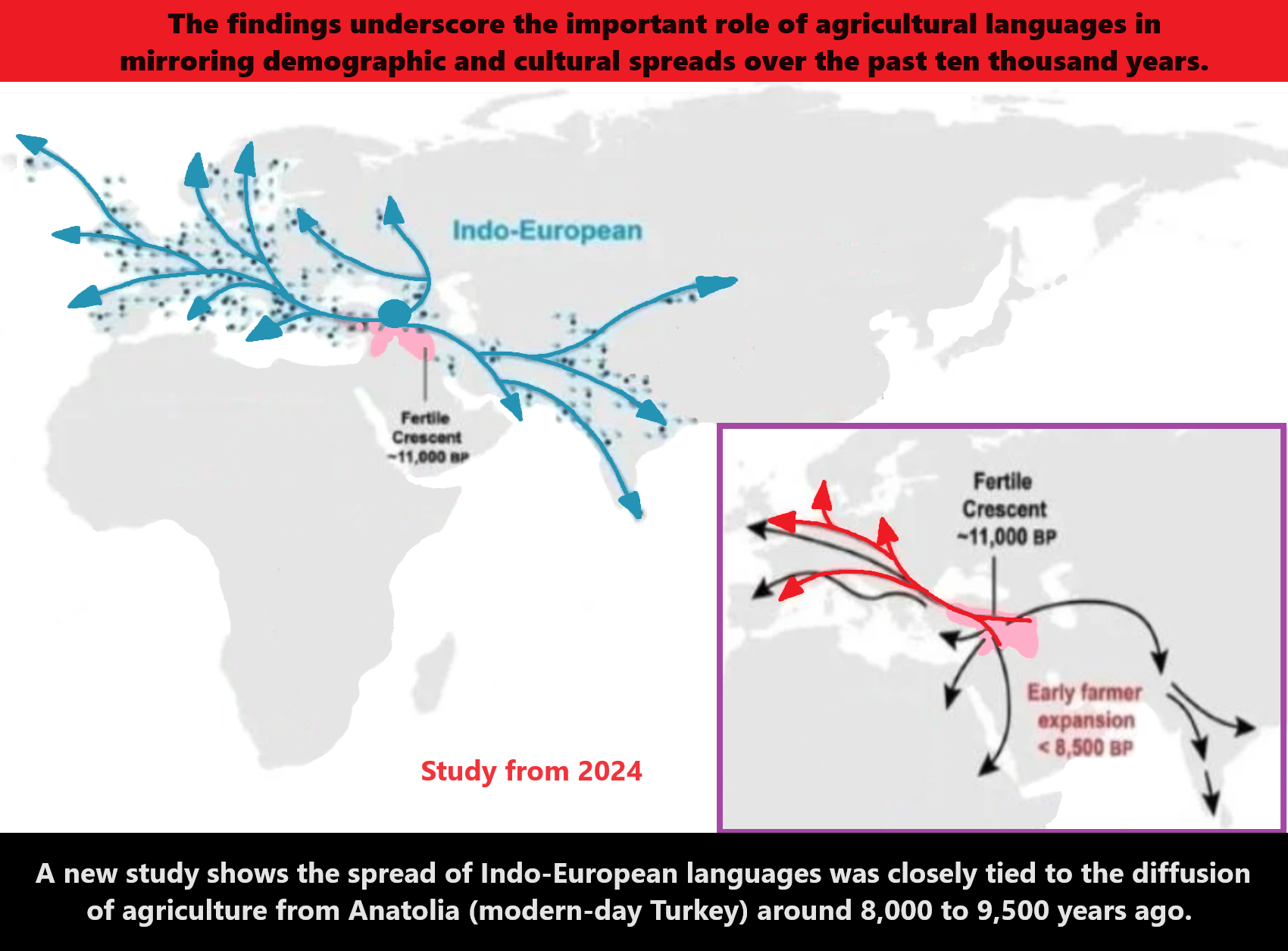
World’s oldest known fort was constructed by hunter-gatherers 8,000 years ago in Siberia
“The fact that this Stone Age fort was built by hunter-gatherers is transforming our understanding of ancient human societies. Hunter-gatherers built the oldest known fort in the world about 8,000 years ago in Siberia, a new study finds. Archaeologists have long associated fortresses with permanent agricultural settlements. However, this cluster of fortified structures reveals that prehistoric groups were constructing protective edifices much earlier than originally thought.” ref
“These hunter-gatherers “defy conventional stereotypes that depict such societies as basic and nomadic, unveiling their capacity to construct intricate structures,” study co-author Tanja Schreiber, an archaeologist at Free University of Berlin, told Live Science in an email. Located along the Amnya River in western Siberia, remains of the Amnya fort include roughly 20 pit-house depressions scattered across the site, which is divided into two sections: Amnya I and Amnya II. Radiocarbon dating confirmed that the settlement was first inhabited during the Mesolithic, or Middle Stone Age, according to the study. When constructed, each pit house would have been protected by earthen walls and wooden palisades — two construction elements that suggest “advanced agricultural and defensive capabilities” by the inhabitants, the archaeologists said in a statement.” ref
“One of the Amnya fort’s most astonishing aspects is the discovery that approximately 8,000 years ago, hunter-gatherers in the Siberian Taiga built intricate defense structures,” Schreiber said. “This challenges traditional assumptions that monumental constructions were solely the work of agricultural communities.” It’s unknown what triggered the need for these fortified structures in the first place, but the strategic location overlooking the river would have not only been an ideal lookout point for potential threats but also allowed hunter-gatherers to keep tabs on their fishing and hunting grounds, the researchers noted.” ref
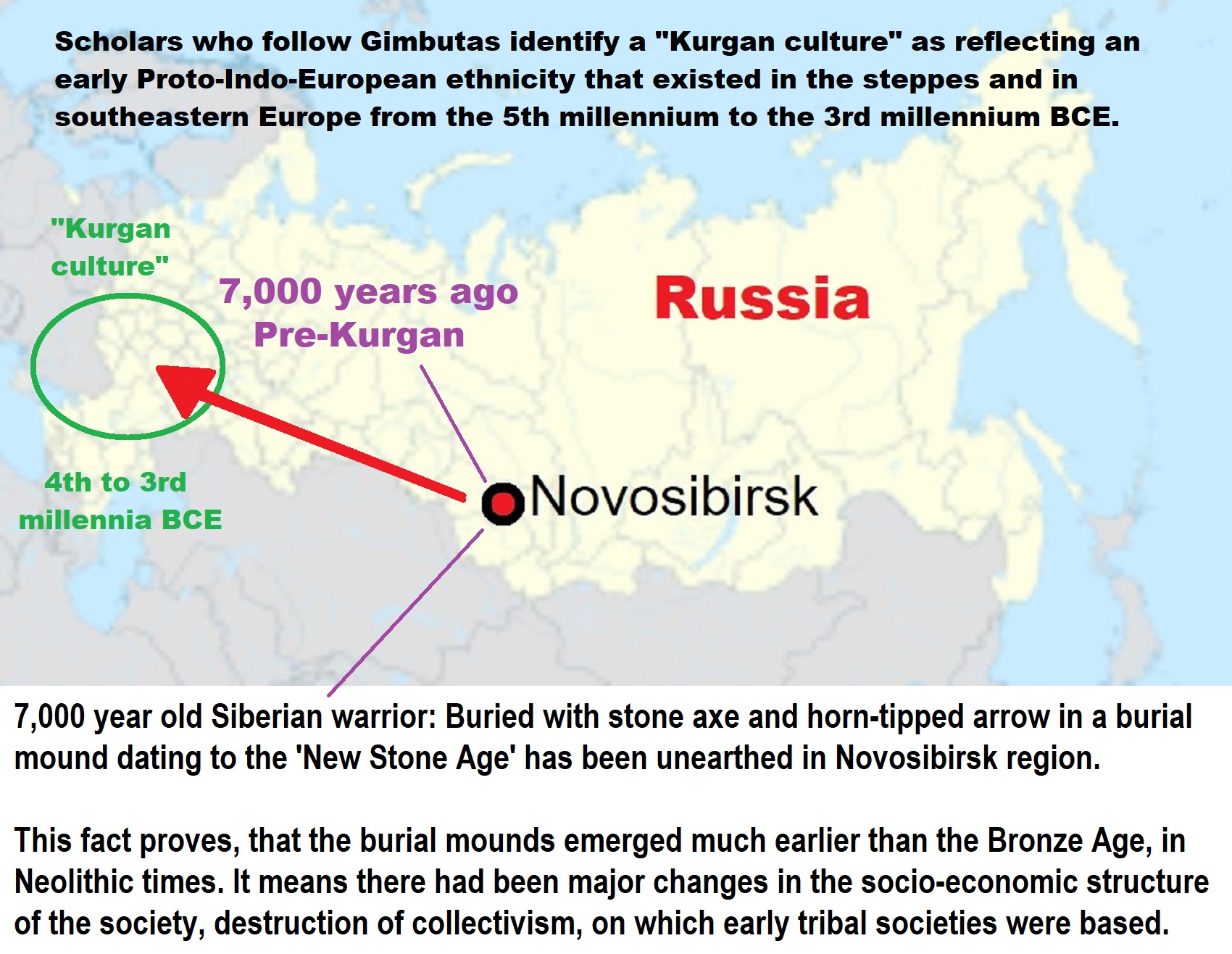
Kurgan Hypothesis
“The Kurgan hypothesis (also known as the Kurgan theory or Kurgan model) or Steppe theory is the most widely accepted proposal to identify the Proto-Indo-European homeland from which the Indo-European languages spread out throughout Europe and parts of Asia. It postulates that the people of a Kurgan culture in the Pontic steppe north of the Black Sea were the most likely speakers of the Proto-Indo-European language (PIE). The term is derived from the Russian kurgan (курга́н), meaning tumulus or burial mound. The Steppe theory was first formulated by Otto Schrader (1883) and V. Gordon Childe (1926), then systematized in the 1950s by Marija Gimbutas, who used the term to group various prehistoric cultures, including the Yamnaya (or Pit Grave) culture and its predecessors. In the 2000s, David Anthony instead used the core Yamnaya culture and its relationship with other cultures as a point of reference.” ref
“Gimbutas defined the Kurgan culture as composed of four successive periods, with the earliest (Kurgan I) including the Samara and Seroglazovo cultures of the Dnieper–Volga region in the Copper Age (early 4th millennium BCE). The people of these cultures were nomadic pastoralists, who, according to the model, by the early 3rd millennium BCE had expanded throughout the Pontic–Caspian steppe and into Eastern Europe. Recent genetics studies have demonstrated that populations bearing specific Y-DNA haplogroups and a distinct genetic signature expanded into Europe and South Asia from the Pontic-Caspian steppe during the third and second millennia BCE. These migrations provide a plausible explanation for the spread of at least some of the Indo-European languages, and suggest that the alternative Anatolian hypothesis, which places the Proto-Indo-European homeland in Neolithic Anatolia, is less likely to be correct.” ref
“Cultures that Gimbutas considered as part of the “Kurgan culture”:
- Bug–Dniester (6th millennium)
- Samara (5th millennium)
- Khvalynsk (5th millennium)
- Dnieper–Donets (5th to 4th millennia)
- Sredny Stog (mid-5th to mid-4th millennia)
- Maikop–Dereivka (mid-4th to mid-3rd millennia)
- Yamnaya (Pit Grave): This is itself a varied cultural horizon, spanning the entire Pontic–Caspian steppe from the mid-4th to the 3rd millennium.
- Usatovo culture (late 4th millennium)” ref
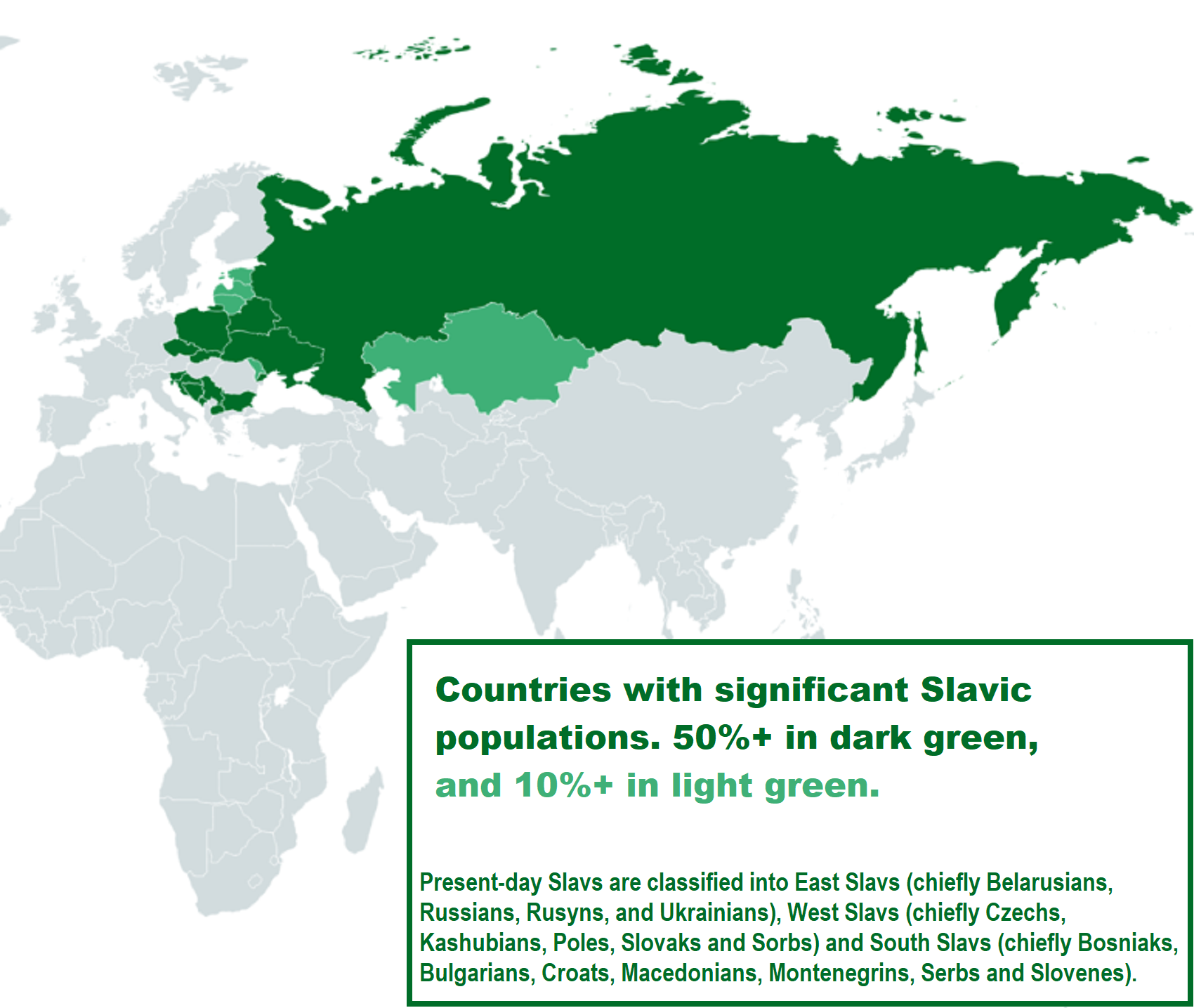
“Countries with significant Slavic populations. 50%+ in dark green, and 10%+ in light green. Present-day Slavs are classified into East Slavs (Belarusians, Russians, Rusyns, and Ukrainians), West Slavs (Czechs, Kashubians, Poles, Slovaks, and Sorbs), and South Slavs (Bosniaks, Bulgarians, Croats, Macedonians, Montenegrins, Serbs, and Slovenes).” en.wikipedia.org/wiki/Slavs
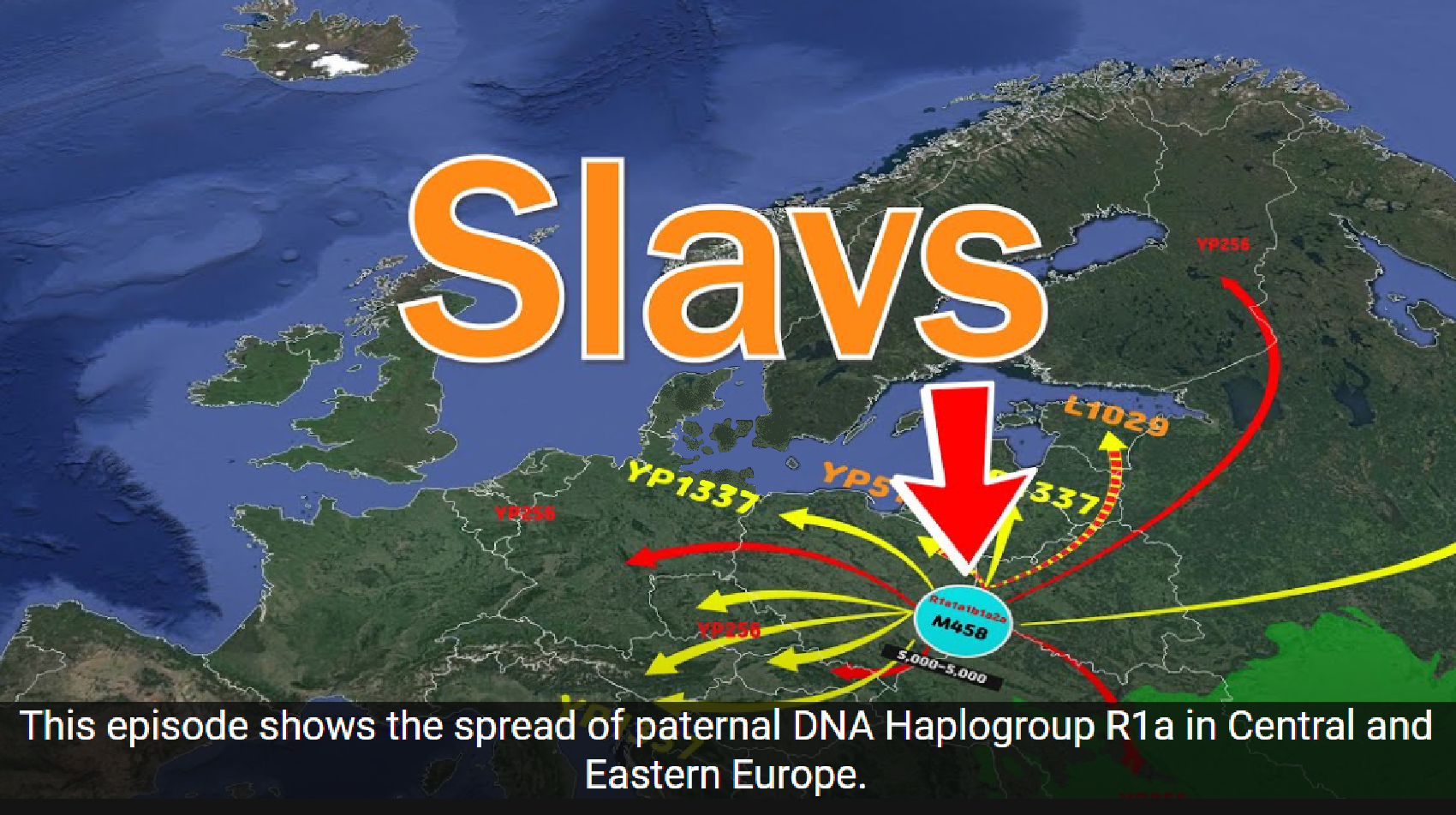
(The spread of R1a associated with the migration of the Slavs and Corded Ware culture) the spread of R1a (M458) was associated with the migration of Early Bronze Age Corded Ware culture and much later Early Middle Age Slavs. *The spread of R1a associated with the migration of the Slavs and Corded Ware culture*
“R1a-M458, primarily a Slavic subclade, with maximum frequencies in Poland, the Czech Republic, Slovakia, but is also fairly common in southeast Ukraine and northwest Russia. Its subclade R1a-L260 is clearly West Slavic, with a peak of frequency in Poland, the Czech Republic, and Slovakia, and radiating at lower frequencies into East Germany, East Austria, Slovenia, and Hungary. And R1a-Z280 is also a Balto-Slavic marker, found all over central and Eastern Europe (except in the Balkans), with a western limit running from East Germany to Switzerland and Northeast Italy. It can be divided in many clusters: East Slavic, Baltic, Pomeranian, Polish, Carpathian, East-Alpine, Czechoslovak, and so on. Likewise, its subclade R1a-L365 is a Pomeranian cluster found also in southern Poland.” ref
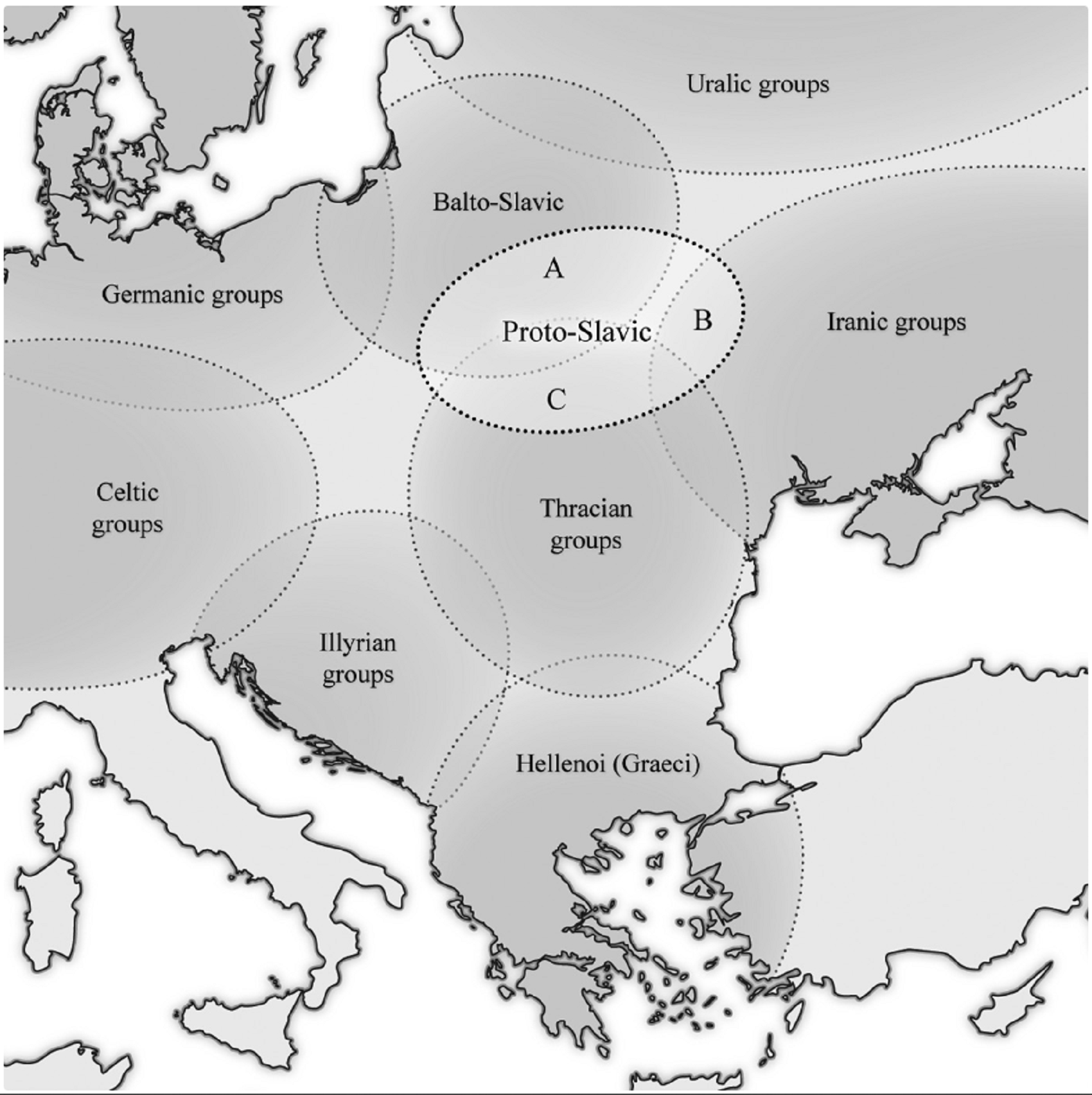
“The formation of Proto-Slavic, according to Sorin Paliga. From Sorin Paliga, “Albanians, Romanians, Slavs: Ethnicity, change, and politics in the second half of the first millennium CE,” in New Perspectives on the Early Slavs and the Rise of Slavic: Contact and Migrations, edited by Tomáš Klír, Vít Boček, and Nicolas Jansens (Heidelberg: Carl Winter, 2020), p. 331, figure 1.” ref
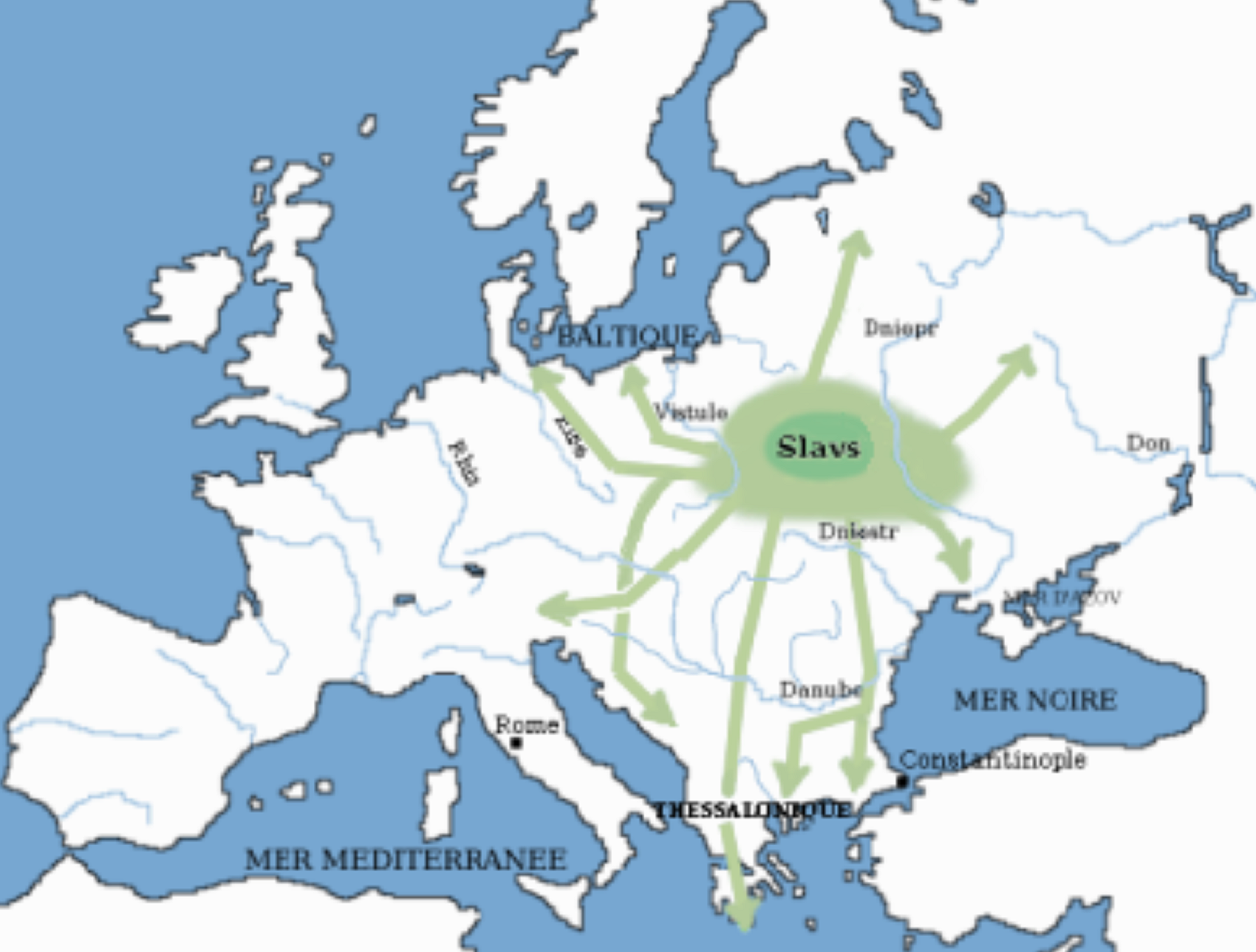

“Kievan Rus’ after the Council of Liubech in 1097.” ref

“Kievan Rus’, also known as Kyivan Rus’ was a state and later an amalgam of principalities in Eastern and Northern Europe from the late 9th to the mid-13th century. Encompassing a variety of polities and peoples, including East Slavic, Norse, and Finnic, it was ruled by the Rurik dynasty, founded by the Varangian prince Rurik. The modern nations of Belarus, Russia, and Ukraine all claim Kievan Rus’ as their cultural ancestor, with Belarus and Russia deriving their names from it. At its greatest extent in the mid-11th century, Kievan Rus’ stretched from the White Sea in the north to the Black Sea in the south and from the headwaters of the Vistula in the west to the Taman Peninsula in the east, uniting the East Slavic tribes.” ref
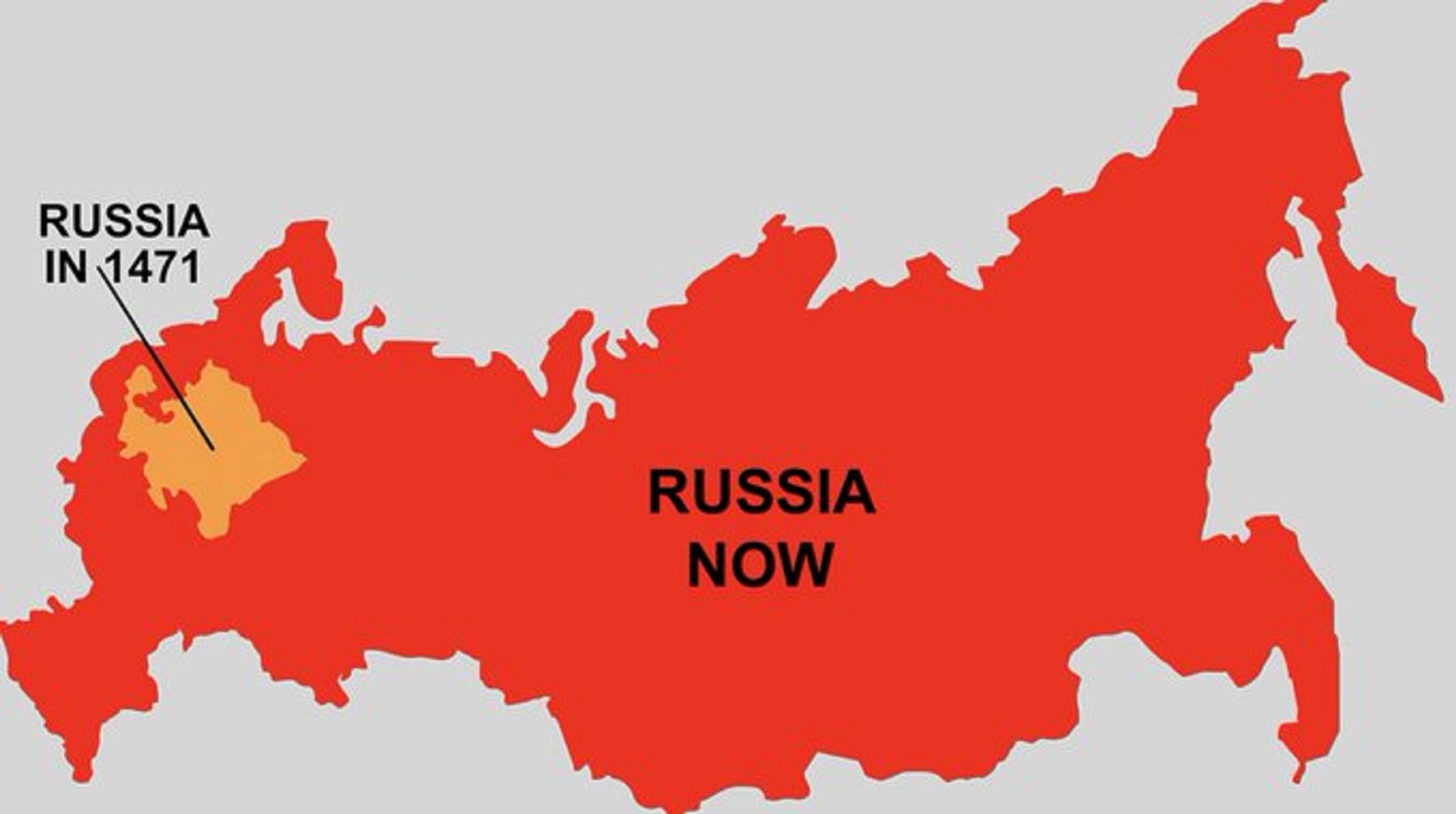
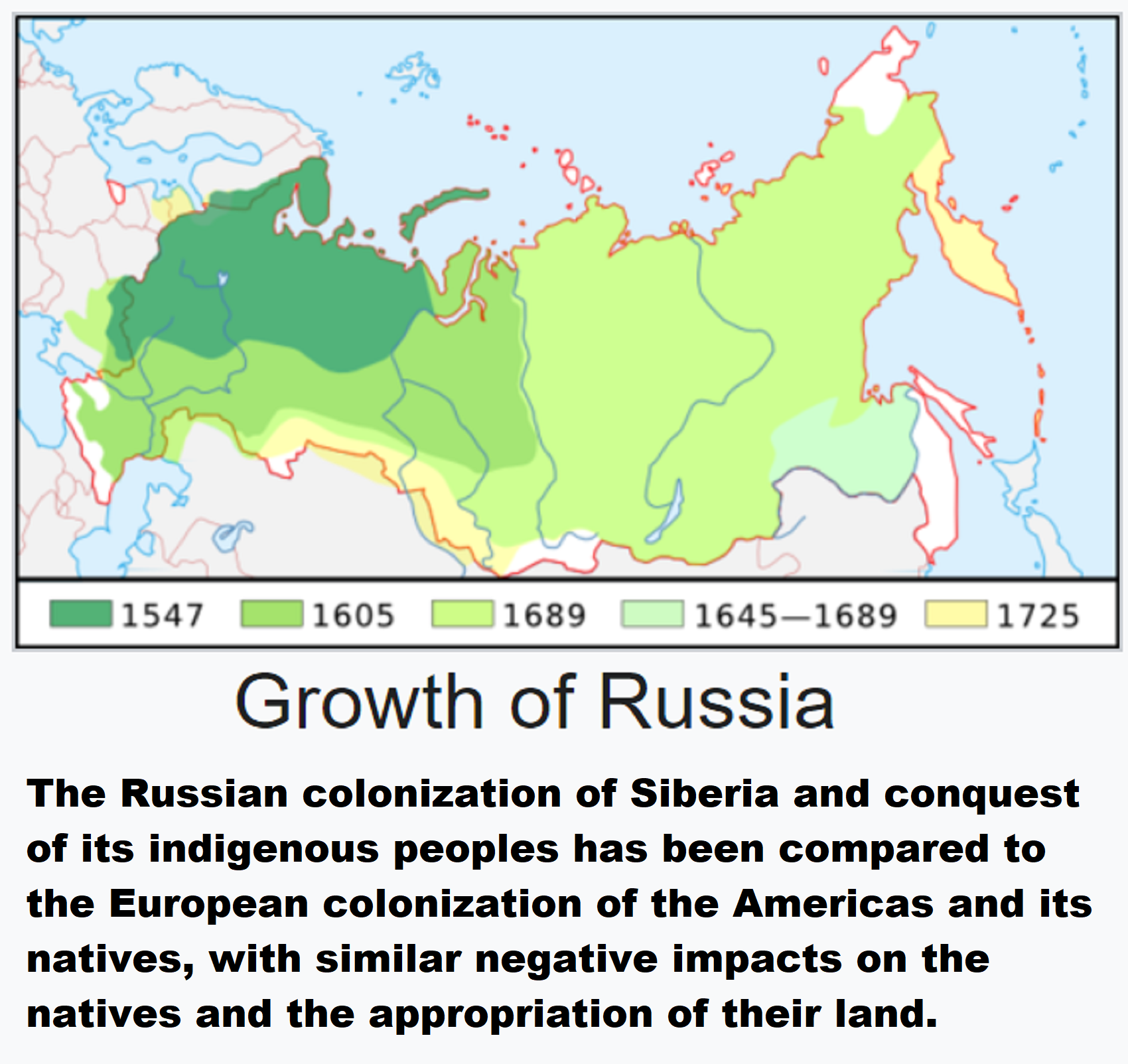
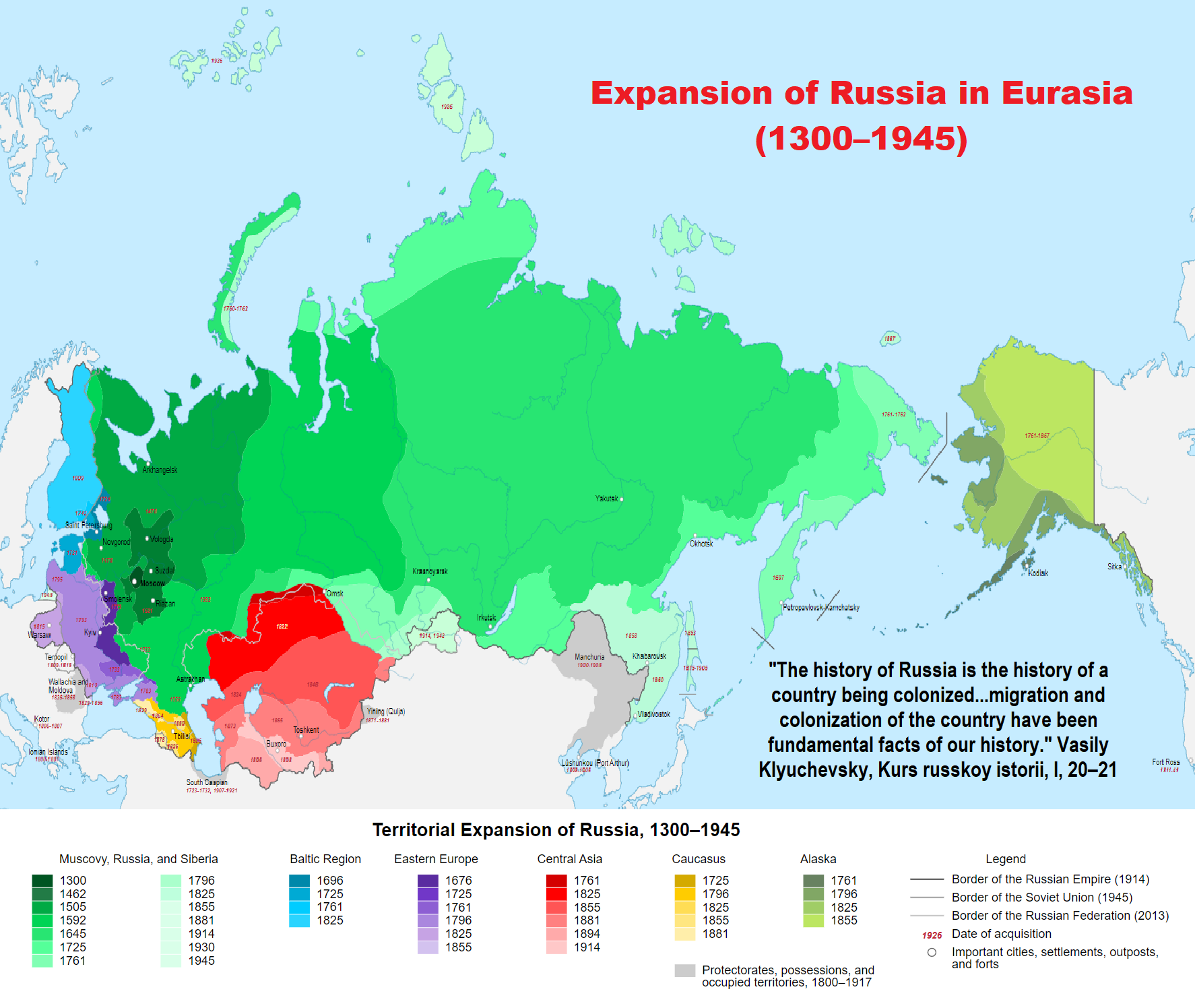
“How Western scholars overlooked Russian imperialism: For far too long, Western academia has ignored the legacies of the Russian Empire and colonisation.” ref
“When Russia launched its full-scale invasion of Ukraine in February, discussions emerged about the imperial nature of the war. Scholars who spoke up about it were quickly dismissed in certain Western academic and political circles. Some, especially the self-professed “anti-imperialists”, claimed Russia was “provoked” and portrayed Ukraine’s resistance as a “Western imperial” plot. Others considered analyses of Russian imperialism as having a pro-war, hawkish agenda or being a reflection of narrow ethno-nationalist sentiments.” ref
“But for scholars from the post-Soviet space – from places that have suffered from Russian aggression and imperialism – these reactions were hardly a surprise. They had been ignored and dismissed before. Discussions of Russian imperialism have long been overlooked while American, British, and French imperialisms have been studied closely and thoroughly. This has much to do with how Western academia and to a certain extent political elites have chosen to approach the Soviet Union and its eventual dissolution.” ref
“Russian imperial ambitions date back to the 16th century when the Grand Principality of Moscow, or Muscovy, proclaimed itself the third Rome, the successor of the Byzantine Empire and protector of all Orthodox Christians. The Russian imperial army fought numerous wars in the east, west, and south, and by the mid-19th century, Russia had become the largest land empire. Along with the British, Austro-Hungarian, and French empires, it understood and presented itself as a European colonial power.” ref
“Following the October Revolution in 1917, the Bolsheviks proclaimed the end of the Russian monarchy and Russian imperialism, but they fought brutally to preserve the Russian imperial borders. They reconquered newly formed independent states, such as Ukraine, Georgia, Armenia, and Azerbaijan, which emerged after the collapse of the Russian Empire. In the early 1930s, Joseph Stalin embraced Russian nationalism based on the old imperial myth of the greatness of the Russian people. Bolshevik Moscow made ethnic Russians the most privileged group in the Soviet Union and sent Russian settlers to populate and control non-Russian regions.” ref
“Purging native leaders, forcefully resettling entire ethnic groups, and creating conditions that led to mass deaths were all part of Soviet colonisation. Non-Russian people’s cultures, languages, and histories were disparaged while Russification was presented as enlightenment. At the same time, the Soviet Union adopted a progressive narrative of enfranchising nations conquered by the Russian Empire and giving them national rights within the Soviet Union. Many in Western academia bought into the anti-colonial narrative Moscow was trying to sell because they took official proclamations at face value and wanted to believe in the story of communist anti-imperialism.” ref
“For many Western scholars, that apparently meant that he was leading a post-colonial state. By focusing on individuals and official proclamations, Western academia too often overlooked the fact that Stalin was obsessed with maintaining Russian imperial borders and had adopted the same toolkit – ethnic cleansing, crushing dissent, destroying national movements, privileging Russian ethnicity and culture – that tsarist Russia used to maintain them. Soviet coloniality was dismissed also because knowledge about the Soviet Union in the West was Russo-centric. The Soviet Union was often referred to simply as Russia. There was little knowledge about non-Russian people. Non-Russian émigrés who fled to the West and wrote about Soviet coloniality with firsthand experience of Soviet imperialism were dismissed as anti-Soviet conservative ideologues.” ref
“Importantly, the Soviet Union also became a space of projections for those who looked for ways to criticize capitalism and Western imperialism. Those who blamed capitalism for oppression believed that eliminating capitalism would end all forms of oppression. For them, the Soviet Union was an internationalist project that brought equality and freedom to formerly subjugated peoples. Violence against various nations and ethnic groups was either ignored or treated as a necessary evil of the transition to communism. Western scholarship also overwhelmingly focused on the Soviet metropoles – Moscow and Leningrad. They knew very little, if at all, about the Soviet peripheries, which meant that nobody really understood the uprisings in Central Asia, the Caucasus, or the Baltics from the late 1980s onwards or the bloodshed in Tajikistan, Nagorno-Karabakh, Transnistria, Abkhazia, South Ossetia, and later Chechnya.” ref
Russian Imperialism/Colonialism
“Russian imperialism includes the policy and ideology of power exerted by Russia, as well as its antecedent states, over other countries and external territories. This includes the conquests of the Russian Empire, the imperial actions of the Soviet Union (as Russia is considered its main successor state), as well as those of the modern Russian Federation. Some postcolonial scholars have noted the lack of attention given to Russian and Soviet imperialism in the discipline.” ref
“Montesquieu wrote that “The Moscovites cannot leave the empire” and they “are all slaves”. Historian Alexander Etkind describes a phenomenon of “reversed gradient”, where people living near the center of the Russian Empire experienced greater oppression than the ones on the edges. Jean-Jacques Rousseau in turn argued that Poland was not free because of Russian imperialism. In 1836, Nikolai Gogol said that Saint Petersburg was “something similar to a European colony in America”, remarking that there were as many foreigners as people of the native ethnicity. According to Aleksey Khomyakov, the Russian elite was “a colony of eclectic Europeans, thrown into a country of savages” with a “colonial relationship” between the two. A similar colonial aspect was identified by Konstantin Kavelin.” ref
“Russian imperialism has been argued to be different from other European colonial empires due to its empire being overland rather than overseas, which meant that rebellions could be more easily put down, with some lands being reconquered soon after they were lost. The terrestrial basis of the empire has also been seen as a factor which made it more divided than sea-based ones due to the difficulties of communication and transport over land at the time. Russian imperialism has been linked to the labor-intensive and low-productivity economic system based on serfdom and despotic rule, which required constant increases in the amount of land under cultivation to legitimize the rule and provide satisfaction to the subjects. The political system in turn depended on land as a resource to reward officeholder. The political elite made territorial expansion an intentional project.” ref
“According to Vasily Klyuchevsky, Russia has the “history of a country that colonizes itself”. Vladimir Lenin saw Russia’s underdeveloped territories as internal colonialism. This concept had first been introduced in the context of Russia by August von Haxthausen in 1843. Sergey Solovyov argued that this was because Russia “was not a colony that was separated from the metropolitan land by oceans”. For Afanasy Shchapov, this process was primarily driven by ecological imperialism, whereby the fur trade and fishing were driving the conquest of Siberia and Alaska. Other followers of Klyuchevsky identified the forms of colonization driven by military or monastic expansion, among others. Pavel Milyukov meanwhile noted the violence of this self-colonizing process. A similarity was later noted between Russian self-colonialism and the American frontier by Mark Bassin.” ref
“The territorial expansion of the empire gave the autocratic rulers of Russia additional legitimacy, while also giving the subjugated population a source of national pride. The legitimation of the empire was later done through different ideologies. After the Fall of Constantinople, Moscow named itself the third Rome, following the Roman and Byzantine Empires. In a panegyric letter to Grand Duke Vasili III composed in 1510, Russian monk Philotheus (Filofey) of Pskov proclaimed, “Two Romes have fallen. The third stands. And there will be no fourth. No one shall replace your Christian Tsardom!”. This led to the concept of a messianic Orthodox Russian nation as the Holy Rus. Russia claimed to be the protector of Orthodox Christians as it expanded into the territories of the Ottoman Empire during wars such as the Crimean War.” ref
“After the victory of monarchist Coalition in 1815, Russia promulgated the Holy Alliance with Prussia and Austria to reinstate the divine right of kings and Christian values in European political life, as pursued by Alexander I under the influence of his spiritual adviser Baroness Barbara von Krüdener. It was written by the Tsar and edited by Ioannis Kapodistrias and Alexandru Sturdza. In the first draft Tsar Alexander I made appeals to mysticism through a proposed unified Christian empire, with a unified imperial army, that was seen as disconcerting by the other monarchies. Following revision, a more pragmatic version of the alliance was adopted by Russia, Prussia, and Austria. The document was called “an apocalypse of diplomacy” by French diplomat Dominique-Georges-Frédéric Dufour de Pradt. The Holy Alliance was largely used to suppress internal dissent, censoring the press and shutting down parliaments as part of “The Reaction.” ref
“Under Nicholas I of Russia, Orthodoxy, Autocracy, and Nationality became the official state ideology. It required the Orthodox Church to take an essential role in politics and life, required the central rule of a single autocrat or absolute ruler, and proclaimed that the Russian people were uniquely capable of unifying a large empire due to special characteristics. Similar to the broader “divine right of kings”, the emperor’s power would be seen as resolving any contradictions in the world and creating an ideal “celestial” order. Hosking argued that the trio of “Orthodoxy, Autocracy, Nationality” had key flaws in two of its main pillars, as the church was entirely dependent and submissive to the state, and the concept of nationality was underdeveloped because many officials were Baltic German and the revolutionary ideas of nation states were a “muffled echo” in a system that relied on serfdom. In practice, this left autocracy as the only viable pillar.” ref
“In the 19th century, pan-Slavism became a new legitimation theory for the empire. The idea of the Russian world became a key concept and the imperial nation-building of “All-Russian” nationality was embraced by many imperial subjects (including Jews and Germans) and served as the foundation of the Empire. It had first gained in political importance near the end of the 18th century as a means of legitimizing Russian imperial claims to the eastern territories of the partitioned Polish–Lithuanian Commonwealth. Following the January Uprising in 1863 the Russian government became extremely determined to eliminate all manifestations of separatism. By the second half of the 19th century, Russian publicists adopted, and transformed, the ideology of Pan-Slavism; “convinced of their own political superiority [they] argued that all Slavs might as well merge with the Great Russians.” ref
“The “Russian geography” poem by a notable 19th century Russian poet Fyodor Tyutchev was considered by philologist Roman Leibov to express ideology of the worldwide Slavic empire:
Moscow and Peter’s grad, the city of Constantine,
these are the capitals of Russian kingdom.
But where is their limit? And where are their frontiers
to the north, the east, the south and the setting sun?
The Fate will reveal this to future generations.
Seven inland seas and seven great rivers
from the Nile to the Neva, from the Elbe to China,
from the Volga to the Euphrates, from Ganges to the Danube.
That’s the Russian Kingdom, and let it be forever,
just as the Spirit foretold and Daniel prophesied.” ref
“Russian expansionism has largely benefited from the proximity of the mostly uninhabited Siberia, which has been incrementally conquered by Russia since the reign of Ivan the Terrible (1530–1584). The Russian colonization of Siberia and conquest of its indigenous peoples has been compared to European colonization of the Americas and its natives, with similar negative impacts on the natives and the appropriation of their land. Other researchers, however, consider that settlement of Siberia differed from European colonization in not resulting in native depopulation, as well as providing gainful employment and integrating indigenous population into settlers’ society. The North Pacific also became the target of similar expansion establishing the Russian Far East.” ref
“In 1858, during the Second Opium War, Russia strengthened and eventually annexed the north bank of the Amur River and the coast down to the Korean border from China in the “Unequal Treaties” of Treaty of Aigun (1858) and the Convention of Peking (1860). During the Boxer Rebellion, the Russian Empire invaded Manchuria in 1900, and the Blagoveshchensk massacre occurred against Chinese residents on the Russian side of the border. Furthermore, the empire at times controlled concession territories in China, notably the Chinese Eastern Railway and concessions in Tianjin and Russian Dalian.” ref
“The Russian conquest of Central Asia took place over several decades. In 1847–64 they crossed the eastern Kazakh Steppe and built a line of forts along the northern border of Kyrgyzstan. In 1864–68 they moved south from Kyrgyzstan, captured Tashkent and Samarkand and dominated the Khanates of Kokand and Bokhara. The next step was to turn this triangle into a rectangle by crossing the Caspian Sea. In 1873 the Russians conquered Khiva, and in 1881 they took western Turkmenistan. In 1884 they took the Merv oasis and eastern Turkmenistan. In 1885 further expansion south toward Afghanistan was blocked by the British. In 1893–95 the Russians occupied the high Pamir Mountains in the southeast. According to historian Alexander Morrison, “Russia’s expansion southwards across the Kazakh steppe into the riverine oases of Turkestan was one of the nineteenth century’s most rapid and dramatic examples of imperial conquest.” ref
“In the south, the Great Game was a political and diplomatic confrontation that existed for most of the 19th century and beginning of the 20th century between the British Empire and the Russian Empire over Central and South Asia. Britain feared that Russia planned to invade India and that this was the goal of Russia’s expansion in Central Asia, while Russia continued its conquest of Central Asia. Indeed, multiple 19th-century Russian invasion plans of India are attested, including the Duhamel and Khrulev plans of the Crimean War (1853–1856), among later plans that never materialized.” ref
“Historian A. I. Andreyev stated that, “in the days of the Great Game, Mongolia was an object of imperialist encroachment by Russia, as Tibet was for the British.” In the Anglo-Russian Convention of 1907, the Russian Empire and British Empire officially ended their Great Game rivalry to focus on opposing the German Empire, dividing Iran into British and Russian portions. In 1908, the Persian Constitutional Revolution sought to establish a democratic civil society in Iran, with an elected Majilis, a relatively free press and other reforms. The Russian Empire intervened in the Persian Constitutional Revolution to support the Shah and reactionary factions. The Cossacks bombarded the Majilis, Russia had earlier established the Persian Cossack Brigade in 1879, a force which was led by Russian officers and served as a vehicle for Russian influence in Iran.” ref
“Eastwards expansion was followed by the Russian colonization of North America across the Pacific Ocean. Russian promyshlenniki (trappers and hunters) quickly developed the maritime fur trade, which instigated several conflicts between the Aleuts and Russians in the 1760s. By the late 1780s, trade relations had opened with the Tlingits, and in 1799 the Russian-American Company (RAC) was formed in order to monopolize the fur trade, also serving as an imperialist vehicle for the Russification of Alaska Natives.” ref
“The Russian Empire also acquired the island of Sakhalin which was turned into one of history’s largest prison colonies. Initially, Russian maritime incursions into the waters surrounding Hokkaido began in the late eighteenth century, spurring Japan to map and explore its northern island surroundings. Sakhalin had been inhabited by indigenous peoples including Ainu, Uilta, and Nivkh, despite the island nominally paying tribute to the Qing Dynasty. After Russia acquired Manchuria from the Qing in the 1858 Treaty of Aigun, they also acquired from the Qing, a nominal claim to Sakhalin across the strait. With the earlier 1855 Treaty of Shimoda, a joint settler colony of both Russian and Japanese was temporarily created, despite conflicts. However, with the 1875 Treaty of Saint Petersburg the Russian Empire was granted Sakhalin in exchange for Japan gaining the Kuril Islands.” ref
“The furthest Russian colonies were in Fort Elizavety and Fort Alexander, Russian forts on the Hawaiian islands, built in the early 19th century by the Russian-American Company as the result of an alliance with High Chief Kaumualiʻi, as well as in Sagallo, a short-lived Russian settlement established in 1889 on the Gulf of Tadjoura in French Somaliland (modern-day Djibouti). The southernmost settlement established in North America was at Fort Ross, California.” ref
North America/Alaska Russian Colonization
“The Russian colonization of Alaska lasted less than a century but in that time produced a rich history of enduring importance. As in the American West, Russian Alaska attracted the full range of humanity: adventurers and explorers, merchants and plunderers, enlightened and not-so-enlightened administrators, scoundrels, and saints. Although the original impetus for colonizing Alaska was the fur trade, the Russian Orthodox Church had probably the greatest lasting impact on the people of Alaska, helping to create a multicultural Orthodox community that exists to this day.” ref
“Following the early period of Russian exploration of North America, the imperial government was initially content to leave further development of Alaska in the hands of private traders or promyshlenniki. Attracted by the fur-bearing animals of the Aleutian Islands, the promyshlenniki did not settle in the new territory but only hunted seasonally. In 1784, however, Grigorii Shelikhov established the first permanent Russian outpost on Kodiak Island at Three Saints Bay. Eager to eliminate rival Russian companies and gain control of the entire North Pacific fur trade, Shelikhov expanded the sphere of Russian influence along the Alaskan coast and petitioned Empress Catherine the Great to grant him a monopoly. Shelikhov did not live to see his plans implemented, but in December 1799 Catherine’s successor, Paul I, decided to issue a charter creating the Russian-American Company. Although its board of directors met in St. Petersburg, the company’s business was conducted from the capital of Russian America, New Archangel (founded on Sitka Island in 1804). Despite falling revenues and a changing world order in the Pacific, the Russian-American Company provided Alaska and the Aleutians with a commercial and civil administration until 1867.” ref
Russian conquest of Siberia
“The Russian conquest of Siberia took place during 1580–1778, when the Khanate of Sibir became a loose political structure of vassalages that were being undermined by the activities of Russian explorers. Although outnumbered, the Russians pressured the various family-based tribes into changing their loyalties and establishing distant forts from which they conducted raids. It is traditionally considered that Yermak Timofeyevich‘s campaign against the Siberian Khanate began in 1580. The annexation of Siberia and the Far East to Russia was resisted by local residents and took place against the backdrop of fierce battles between the indigenous peoples and the Russian Cossacks, who often committed atrocities against the indigenous peoples.” ref
“The Russian conquest of Siberia began in July 1580 when some 540 Cossacks under Yermak Timofeyevich invaded the territory of the Voguls, subjects to Kuchum Khan, ruler of the Sibir Khanate. They were accompanied by some Lithuanian and German mercenaries and prisoners of war. Throughout 1581, this force traversed the territory known as Yugra and subdued Vogul and Ostyaks towns. At this time, they also captured a tax collector of Kuchum Khan. Following a series of Tatar raids in retaliation against the Russian advance, Yermak’s forces prepared for a campaign to take Qashliq, the Siberian capital. The force embarked in May 1582. After a three-day battle on the banks of the Irtysh River, Yermak was victorious against a combined force of Kuchum Khan and six allied Tatar princes. On 29 June, the Cossack forces were attacked by the Tatars but again repelled them.” ref
“Throughout September 1582, the Khan gathered his forces for a defense of Qashliq. A horde of Siberian Tatars, Voguls, and Ostyaks massed at Mount Chyuvash to defend against invading Cossacks. On 1 October, a Cossack attempt to storm the Tatar fort at Mount Chyuvash was held off. On 23 October, the Cossacks attempted to storm the Tatar fort at Mount Chyuvash for a fourth time when the Tatars counterattacked. More than a hundred Cossacks were killed, but their gunfire forced a Tatar retreat and allowed the capture of two Tatar cannons. The forces of the Khan retreated, and Yermak entered Qashliq on 26 October. Kuchum Khan retreated into the steppes and over the next few years regrouped his forces. He suddenly attacked Yermak on 6 August 1584 in the dead of night and defeated most of his army. The details are disputed with Russian sources claiming Yermak was wounded and tried to escape by swimming across the Wagay River which is a tributary of the Irtysh River, but drowned under the weight of his own chain mail. The remains of Yermak’s forces under the command of Mescheryak retreated from Qashliq, destroying the city as they left.” ref
“In 1586, the Russians returned, and after subduing the Khanty and Mansi people through the use of their artillery they established a fortress at Tyumen close to the ruins of Qashliq. The Tatar tribes that were submissive to Kuchum Khan suffered from several attacks by the Russians between 1584–1595; however, Kuchum Khan would not be caught. Finally, in August 1598, Kuchum Khan was defeated at the Battle of Irmen near the Ob River. In the course of the fight, the Siberian royal family was captured by the Russians. However, Kuchum Khan escaped yet again. The Russians took the family members of Kuchum Khan to Moscow and there they remained as hostages. The descendants of the khan’s family became known as the Princes Sibirsky and the family is known to have survived until at least the late 19th century.” ref
“Despite his personal escape, the capture of his family ended the political and military activities of Kuchum Khan and he retreated to the territories of the Nogai Horde in southern Siberia. He had been in contact with the tsar and had requested that a small region on the banks of the Irtysh River would be granted as his dominion. This was rejected by the tsar who proposed to Küçüm Khan that he come to Moscow and “comfort himself” in the service of the tsar. However, the old khan did not want to suffer from such contempt and preferred staying in his own lands to “comforting himself” in Moscow. Kuchum Khan then went to Bukhara and as an old man became blind, dying in exile with distant relatives sometime around 1605.” ref
“In order to subjugate the natives and collect yasak (fur tribute), a series of winter outposts (zimovie) and forts (ostrogs) were built at the confluences of major rivers and streams and important portages. The first among these were Tyumen and Tobolsk—the former built in 1586 by Vasilii Sukin and Ivan Miasnoi, and the latter the following year by Danilo Chulkov. Tobolsk would become the nerve center of the conquest. To the north Beryozovo (1593) and Mangazeya (1600–01) were built to bring the Nenets under tribute, while to the east Surgut (1594) and Tara (1594) were established to protect Tobolsk and subdue the ruler of the Narym Ostiaks. Of these, Mangazeya was the most prominent, becoming a base for further exploration eastward.” ref
“Advancing up the Ob and its tributaries, the ostrogs of Ketsk (1602) and Tomsk (1604) were built. Ketsk sluzhilye liudi (“servicemen”) reached the Yenisei in 1605, descending it to the Sym; two years later Mangazeyan promyshlenniks and traders descended the Turukhan to its confluence with the Yenisei, where they established the zimovie Turukhansk. By 1610, men from Turukhansk had reached the mouth of the Yenisei and ascended it as far as the Sym, where they met rival tribute collectors from Ketsk. To ensure subjugation of the natives, the ostrogs of Yeniseysk (1619) and Krasnoyarsk (1628) were established.” ref
“Following the khan’s death and the dissolution of any organised Siberian resistance, the Russians advanced first towards Lake Baikal and then the Sea of Okhotsk and the Amur River. However, when they first reached the Chinese border they encountered people that were equipped with artillery pieces and here they halted. The Russians reached the Pacific Ocean in 1639. After the conquest of the Siberian Khanate (1598), the whole of North Asia – an area much larger than the old khanate – became known as Siberia and, by 1640, the eastern borders of Russia had expanded more than several million square kilometres. In a sense, the khanate lived on in the subsidiary title “Tsar of Siberia” which became part of the full imperial style of the Russian autocrats.” ref
“The conquest of Siberia also resulted in the spread of diseases. Historian John F. Richards wrote: “… it is doubtful that the total early modern Siberian population exceeded 300,000 persons. … New diseases weakened and demoralized the indigenous peoples of Siberia. The worst of these was smallpox “because of its swift spread, the high death rates, and the permanent disfigurement of survivors.” … In the 1650s, it moved east of the Yenisey, where it carried away up to 80 percent of the Tungus and Yakut populations. In the 1690s, smallpox epidemics reduced Yukagir numbers by an estimated 44 percent. The disease moved rapidly from group to group across Siberia.” ref
“The core ideological justification for Russian expansion into Siberia stemmed from the interpretation that the legal incorporation of the Khanate of Sibir into the Russian realm gave Russia legal sovereignty over the entirety of the territory stretching from the Ural Mountains to the Pacific Ocean to the east. The actual boundaries of Siberia thus became very vaguely defined and open to interpretation; effectively, Russian dominion over the land ended only whenever Russia’s claims to land conflicted with those of centralised states capable of opposing Russian expansion and consistently asserting their own sovereignty over a given territory, such as China and Mongolia. A second ideological pillar justifying Russian colonialism was the spread of Eastern Orthodox Christianity, although this pretext originated largely from explorers and settlers themselves as an ad hoc justification rather than being put forward by the Russian Orthodox Church itself.” ref
Effects on the indigenous peoples of Siberia?
“When the Cossacks’ entreaties were rejected, they chose to respond with force. Under the leadershp of Vasilii Poyarkov in 1645 and Yerofei Khabarov in 1650 many people, including members of the Daur tribe, were killed by the Cossacks. 8,000 out of a previous population of 20,000 in Kamchatka remained after the first half century of the Russian conquest. The Daurs initially deserted their villages fearing the reported cruelty of the Russians the first time Khabarov came. The second time he came, the Daurs fought back against the Russians, but were slaughtered. In the 17th century, indigenous peoples of the Amur region were attacked by Russians who came to be known as “red-beards.” ref
“In the 1640s, the Yakuts were subjected to violent expeditions during the Russian advance into the land near the Lena River, and on Kamchatka in the 1690s the Koryaks, Kamchadals, and Chukchi were also subjected to this by the Russians according to Western historian Stephen Shenfield. When the Russians did not obtain the demanded amount of yasak from the natives, the governor of Yakutsk, Piotr Golovin, who was a Cossack, used meat hooks to hang the native men. In the Lena basin, 70% of the Yakut population declined within 40 years, native women were raped and, along with children, were often enslaved in order to force the natives to pay the Yasak.” ref
“According to John F. Richards:
Smallpox first reached western Siberia in 1630. In the 1650s, it moved east of the Yenisey, where it carried away up to 80 percent of the Tungus and Yakut populations. In the 1690s, smallpox epidemics reduced Yukagir numbers by an estimated 44 percent. The disease moved rapidly from group to group across Siberia. Death rates in epidemics reached 50 percent of the population. The scourge returned at twenty- to thirty-year intervals, with dreadful results among the young.” ref
“In Kamchatka, the Russians crushed the Itelmen uprisings against their rule in 1706, 1731, and 1741. The first time, the Itelmens were armed with stone weapons and were badly unprepared and equipped but they used gunpowder weapons the second time. The Russians faced tougher resistance when from 1745–1756 they tried to subjugate the gun and bow equipped Koryaks until their victory. The Russian Cossacks also faced fierce resistance and were forced to give up when trying unsuccessfully to wipe out the Chukchi in 1729, 1730–1731, and 1744–1747. After the Russian defeat in 1729 at Chukchi hands, the Russian commander Major Pavlutskiy was responsible for the Russian war against the Chukchi and the mass slaughters and enslavement of Chukchi women and children in 1730–1731, but his cruelty only made the Chukchis fight more fiercely.” ref
“Cleansing of the Chukchis and Koryaks was ordered by Empress Elizabeth in 1742 to totally expel them from their native lands and erase their culture through war. The command was that the natives be “totally extirpated” with Pavlutskiy leading again in this war from 1744–1747 in which he led to the Cossacks “with the help of Almighty God and to the good fortune of Her Imperial Highness”, to slaughter the Chukchi men and enslave their women and children as booty. However, the Chukchi ended this campaign and forced them to give up by decapitating and killing Pavlutskiy.” ref
“The Russians were also launching wars and slaughters against the Koryaks in 1744 and 1753–1754. After the Russians tried to force the natives to convert to Christianity, the different native peoples like the Koryaks, Chukchis, Itelmens, and Yukaghirs all united to drive the Russians out of their land in the 1740s, culminating in the assault on Nizhnekamchatsk fort in 1746. Kamchatka today is European in demographics and culture with only 5% of it being native, around 10,000 from a previous number of 150,000, due to the mass slaughters by the Cossacks after its annexation in 1697 of the Itelmens and Koryaks throughout the first decades of Russian rule. The killings by the Russian Cossacks devastated the native peoples of Kamchatka.” ref
“In addition to committing massacres, the Cossacks also devastated the wildlife by slaughtering massive numbers of animals for fur. 90% of the Kamchadals and half of the Vogules were killed from the eighteenth to nineteenth centuries and the rapid slaughter of the indigenous population led to entire ethnic groups being entirely wiped out, with around 12 exterminated groups which could be named by Nikolai Yadrintsev as of 1882. Much of the slaughter was brought on by the Siberian fur trade.” ref
“The oblastniki in the 19th century among the Russians in Siberia acknowledged that the natives were subjected to immense violent exploitation, and claimed that they would rectify the situation with their proposed regionalist policies. The Aleuts in the Aleutians were subjected to genocide and slavery by the Russians for the first 20 years of Russian rule, with the Aleut women and children captured by the Russians and Aleut men slaughtered.” ref
“The Russian colonization of Siberia and conquest of its indigenous peoples has been compared to the European colonization of the Americas and its natives, with similar negative impacts on the natives and the appropriation of their land. The Slavic Russians outnumber all of the native peoples in Siberia and its cities except in the Republics of Tuva and Sakha, with the Slavic Russians making up the majority in the Buryat and Altai Republics, outnumbering the Buriat, and Altai natives.” ref
“The Buryats make up only 33.5% of their own Republic, the Altai 37%, and the Chukchi only 28%; the Evenk, Khanty, Mansi, and Nenets are outnumbered by non-natives by 90% of the population. The natives were targeted by the tsars and Soviet policies to change their way of life, and ethnic Russians were given the natives’ reindeer herds and wild game which were confiscated by the tsars and Soviets. The reindeer herds have been mismanaged to the point of extinction. The Ainu have emphasized that they were the natives of the Kuril Islands and that the Japanese and Russians were both invaders.” ref
Russian Oppression of Shamanism, Common Throughout Siberia
“Russian ethnologists Waldemar and Dina Brodsky Jochelson were in the Siberian village of Kamenskoye during the winter of 1900–1901 when a native Koryak trader and his assistant came to the village. The assistant was “a bashful youth. His features . . . were flexible and pleasant, and his eyes were bright.” Jochelson had heard that the young assistant was a practicing shaman—a ritual adept who could divine the future and heal sick people. “I asked him to show me proof of his shamanistic art,” Jochelson tells us.” ref
“What is a shaman? The word comes from the Tungus language of Central Siberia, where it designates religious leaders, men and women who serve their communities by using hand-held drums to call spirit allies. Saman in Tungus incorporates the root word sa, “to know,” hence an especially knowledgable person. The techniques Jochelson observed in Kamenskoye were, and to a lesser degree still are, practiced throughout the far north of Eurasia and America, particularly by peoples who depend upon the reindeer for food and clothing.” ref
“From the Saami (Lapps) in Scandinavia, all across northern Russia and Siberia and across the northern half of North America into Greenland, communities relying on hunting reindeer (or caribou in America) expected certain individuals to
be approached by spirits who promised to assist the practitioner if he or she studied how to invoke them. Usually, these adepts had been born into families of such practitioners. To be a shaman is a priestly calling. The young Koryak man met by the Jochelsons performed the ritual typical of these northern shamans.” ref
“Waldemar and Dina Jochelson went on to record the culture of the Yukaghir, neighbors to the Koryak. They stayed in the earth-lodge of an elderly man named Nelbosh. Questioned about who served the local people as shaman, Nelbosh told the Jochelsons that no one still alive had that function; several years later, the Jochelsons learned that Nelbosh
himself was the shaman: “he had kept that fact from me, fearing that I might tell about it to the [Russian Orthodox] priest at Verchne-Kolymsk, of whom he stood in mortal fear.” ref
“Russian authorities demanded that the Siberians become Christian, and after the 1917 Revolution, the Soviets forbade shamans to practice their religion. Many were executed as “enemies of the state.” Nelbosh volunteered to demonstrate to the Jochelsons how shamans practiced. His performance, more real than the Jochelsons realized at the time, illustrates another mode of Siberian shamanism, the belief that instead of calling spirits into the house, the shaman’s soul may go
out of the house in company with his or her spirits.” ref
“Nelbosh’s son-in-law, a Tungus1 named Mashka, also was a shaman. Jochelson described Mashka as large and physically very strong, unafraid of his spirits or anyone else, and so “furious and stormy” as he performed his ritual that his jumps, yells, and wild drumming left Jochelson, observing, too exhausted to write up his notes (Jochelson 1926:200)!
Siberian shamans performed rituals for success in hunting as well as to heal the sick, divine the future, and conduct offerings to local, family, and higher spirits.” ref
“Waldemar and Dina Jochelson and their friends and colleagues Waldemar and Sofya Bogoras, spent years in the field in Siberia, living with the indigenous communities and learning their languages. This was tough work, in the summer beset with millions of biting flies and mosquitoes, in winter holed up in dark, smoky, sooty, sod-roofed pit-houses along with lice and smelly blubber (Freed, Freed and Williamson 1988:20).” ref
“The couples traveled by dog sled in winter, by raft, rowboat, horseback, or on foot in summer, carrying the bulky cameras of the time and buying, and somehow shipping, thousands of items of everyday life for the collections of the great museums of New York and St. Petersburg. These scientifically trained ethnographers scrupulously recorded their
direct observations, identified what was recounted to them but not directly observed, and took down the exact words of utterances, obtaining translations from local people who could speak Russian. Nelbosh, living on the Korkodon River, was a real man serving a real 1890s Yukaghir community; his son-in-law was real, so was the “bashful youth” who
worked for the Koryak trader.” ref
“Shamans were described by several seventeenth-century scientific travelers in Siberia and Lapland. Nicolas Witsen, a Dutch explorer whose knowledge of Russia’s remote provinces impressed Czar Peter the Great, published observations of Tungus shamans that sound much like those by the Jochelsons two centuries later. The English geographer Samuel Purchas included a vivid account of a shaman reported from 1557: “He singeth, as wee use here in England to hollow [halloo], whoope, or shout at Hounds, and the rest of the Company answered him with this Outes Igha, Igha, Igha, to which the Priest with his voice replieth” (quoted in Flaherty 1992:35).” ref
“Anthropology as a field of study developed in the late nineteenth century. Some anthropologists aimed to discover laws of human behavior comparable to the laws of physics and chemistry, using observations of “primitive” (i.e., non-European) communities as if they were basic elements and arranging them in a kind of periodic table not unlike that for chemistry. In these Law of Progress schemes, the fur-clad shaman was listed as the most ancient and primitive religious element, “hollowing and whooping” as civilized people do to spur on hunting dogs. Lacking formal schooling and written texts, shamans were supposed to act spontaneously and their beliefs assumed to be irrational and deluded.” ref
“Because it was presumed that all nations that did not raise crops through plow agriculture were simple and not evolved much from animal ancestors, the religious practitioners of Siberia, Lapland, the Himalayas, Australia, and most of the Americas were lumped together as “shamans” or “medicine men.” Animism (belief that there are many invisible spirits in the world) was equated with “shamanism” and labeled the earliest, most primitive religion, superseded among civilized people by the true faith in monothesm. Some nineteenth-century anthropologists suggested that scientific knowledge would supersede monotheism, freeing the most “advanced” nations from all “superstition.” ref
Soviet Imperialism?
“The Soviet Union declared itself anti-imperialist and contributed significantly to various efforts to liberate countries from colonialism in the 20th century. Some historians argue that aspects of Soviet foreign policy exhibited tendencies common to historic empires, a view which is not universally shared and has mainly been articulated by analysts from the West as well as from China during the Sino-Soviet split. This argument is traditionally held to have originated in Richard Pipes‘s book The Formation of the Soviet Union (1954). Several scholars, such as Seweryn Bialer hold that the Soviet Union was a hybrid entity containing elements common to both multinational empires and nation states. It has also been argued that the Soviet Union practiced colonialism similar to conventional imperial powers. Maoists argued that the Soviet Union had itself become an imperialist power while maintaining a socialist façade, or social imperialism.” ref
“The Soviet ideology continued the messianism of Pan-Slavism which placed Russia as a special nation. While proletarian internationalism was originally embraced by the Bolshevik Party during its seizure of power in the Russian Revolution, after the formation of the Soviet Union, Marxist proponents of internationalism suggested that the country could be used as a “homeland of communism” from which revolution could be spread around the globe. Joseph Stalin and Nikolai Bukharin encouraged this turn towards national communism in 1924, away from the classical Marxism position of global socialism. According to Alexander Wendt, this “evolved into an ideology of control rather than revolution under the rubric of socialist internationalism” within the Soviet Union.” ref
“Under Leonid Brezhnev, the policy of “Developed Socialism” declared the Soviet Union to be the most complete socialist country—other countries were “socialist”, but the USSR was “developed socialist”—explaining its dominant role and hegemony over the other socialist countries. Brezhnev also formulated and implemented the interventionist Brezhnev doctrine, permitting the invasion of other socialist countries, which was characterized as imperial. Alongside this Brezhnev also implemented a policy of cultural Russification as part of Developed Socialism, which sought to assert more central control. This was a dimension of Soviet cultural imperialism, which involved the Sovietization of culture and education at the expense of local traditions.” ref
“The Soviets pursued internal colonialism in Central Asia. From the 1930s through the 1950s, Joseph Stalin ordered population transfers in the Soviet Union, deporting people (often entire nationalities) to underpopulated remote areas. Transfers from the Caucasus to Central Asia included the Deportation of the Balkars, Deportation of the Chechens and Ingush, Deportation of the Crimean Tatars, the Deportation of the Karachays, and the Deportation of the Meskhetian Turks. Many European Soviet citizens and much of Russia’s industry were relocated to Kazakhstan during World War II, when Nazi armies threatened to capture all the European industrial centers of the Soviet Union.” ref
“These migrants founded mining towns which quickly grew to become major industrial centers such as Karaganda (1934), Zhezkazgan (1938), Temirtau (1945), and Ekibastuz (1948). In 1955, the town of Baikonur was built to support the Baikonur Cosmodrome. Many more Russians arrived in the years 1953–1965, during the so-called Virgin Lands Campaign of Soviet general secretary Nikita Khrushchev. Still, more settlers came in the late 1960s and 70s, when the government paid bonuses to workers participating in a program to relocate Soviet industry close to the extensive coal, gas, and oil deposits of Central Asia. By 1979 ethnic Russians in Kazakhstan numbered about 5,500,000, almost 40% of the total population.” ref
“Despite early support for self-determination, the Bolsheviks reconquered most of the Russian Empire during the Russian Civil War. The early Russian Soviet Federative Socialist Republic annexed by force the following states:
- Crimean People’s Republic, 1918
- Republic of Aras, 1919
- Alash Autonomy, 1920
- Ukrainian People’s Republic, Ukrainian State, 1921
- First Republic of Armenia, 1920
- Azerbaijan Democratic Republic, 1920
- Belarusian Democratic Republic, 1919
- North Caucasian Emirate, 1920
- Centrocaspian Dictatorship, 1918
- Democratic Republic of Georgia, 1921
- Mountainous Republic of the Northern Caucasus, 1920
- North Ingria, 1920
- Transcaucasian Democratic Federative Republic, 1918” ref
“From the 1919 Karakhan Manifesto to 1927, diplomats of the Soviet Union would promise to revoke concessions in China, but the Soviets kept tsarist concessions such as the Chinese Eastern Railway as part of secret negotiations 1924-1925. This played a role in leading to the 1929 Sino-Soviet conflict, which the Soviets won and reaffirmed their control over the railway, the railway was returned in 1952.” ref
In 1939, the USSR entered into the Molotov–Ribbentrop Pact with Nazi Germany that contained a secret protocol that divided Romania, Poland, Latvia, Lithuania, Estonia, and Finland into German and Soviet spheres of influence. Eastern Poland, Latvia, Estonia, Finland, and Bessarabia in northern Romania were recognized as parts of the Soviet sphere of influence. Lithuania was added in a second secret protocol in September 1939.” ref
“The Soviet Union had invaded the portions of eastern Poland assigned to it by the Molotov–Ribbentrop Pact two weeks after the German invasion of western Poland, followed by co-ordination with German forces in Poland. During the Occupation of East Poland by the Soviet Union, the Soviets liquidated the Polish state, and a German-Soviet meeting addressed the future structure of the “Polish region”. Soviet authorities immediately started a campaign of sovietization of the newly Soviet-annexed areas.” ref
“In 1939, the Soviet Union unsuccessfully attempted an invasion of Finland, subsequent to which the parties entered into an interim peace treaty granting the Soviet Union the eastern region of Karelia (10% of Finnish territory), and the Karelo-Finnish Soviet Socialist Republic was established by merging the ceded territories with the KASSR. After a June 1940 Soviet Ultimatum demanding Bessarabia, Northern Bukovina, and the Hertsa region from Romania, the Soviets entered these areas, Romania caved to Soviet demands and the Soviets occupied the territories.” ref
“In September and October 1939 the Soviet government compelled the much smaller Baltic states to conclude mutual assistance pacts which gave the Soviets the right to establish military bases there. Following invasion by the Red Army in the summer of 1940, Soviet authorities compelled the Baltic governments to resign. Under Soviet supervision, new puppet communist governments and fellow travelers arranged rigged elections with falsified results. Shortly thereafter, the newly elected “people’s assemblies” passed resolutions requesting admission into the Soviet Union. After the invasion in 1940 the repressions followed with the mass deportations carried out by the Soviets.” ref
“By the end of World War II the Soviet Union had also annexed:
- Carpathian Ruthenia, formerly in Czechoslovakia and occupied in 1944
- Tuva (independent 1921–1944; previously governed by Mongolia and by the Manchu Empire (Tannu Uriankhai))
- East Prussia (now Kaliningrad Oblast) from Germany, in 1945
- The Klaipėda Region, annexed to Lithuania in 1945
- The Kuril Islands and southern Sakhalin from Japan, occupied in 1945
- Snake Island in the Black Sea and several Danubian islands from Romania, occupied in 1944 and annexed in 1948” ref
“At the end of World War II, most eastern and central European countries were occupied by the Soviet Union, known as “European colonies”, while remaining independent though their politics, military, foreign and domestic policies were dominated by the Soviet Union.” ref
Contemporary Russian Imperialism?
“The Russian Federation is the primary recognized successor state to the Soviet Union and it has been accused of trying to bring back post-Soviet states under its rule. Almost all the states initially formed the Commonwealth of Independent States (CIS) and most later also joined the Collective Security Treaty Organization (CSTO). The Union State with Belarus was an even stronger form of integration with Russia. Other forms of integration included the economic initiatives of the Eurasian Economic Union and Eurasian Customs Union.” ref
“In the political language of Russia and some other post-Soviet states, the term near abroad refers to the independent republics that emerged after the dissolution of the Soviet Union. Increasing usage of the term in English is connected to assertions of Russia’s right to maintain significant influence in the region. Russian President Vladimir Putin has declared the region to be a component of Russia’s “sphere of influence“, and strategically vital to Russian interests. The concept has been compared to the Monroe Doctrine.” ref
“The annexation of Crimea led to a new wave of Russian nationalism, with large parts of the Russian far right movement aspiring to annex even more land from Ukraine, including the unrecognized Novorossiya. Analyst Vladimir Socor proposed that Russian president Vladimir Putin‘s speech after the annexation of Crimea was a de facto “manifesto of Greater-Russia Irredentism“. After the event in Crimea, the Transnistrian authorities requested Russia to annex Transnistria, a breakaway region of Moldova.” ref
“The contemporary Eurasianist ideology was influenced by political theorist Aleksandr Dugin’s 1997 Foundations of Geopolitics and the Eurasia Party he later founded on the Russian political scene. Political scientist Anton Shekhovtsov defines Dugin’s version of Neo-Eurasianism as “a form of a fascist ideology centered on the idea of revolutionizing the Russian society and building a totalitarian, Russia-dominated Eurasian Empire that would challenge and eventually defeat its eternal adversary represented by the United States and its Atlanticist allies, thus bringing about a new ‘golden age’ of global political and cultural illiberalism“. This ideology was used to justify Russian imperialist aggression against Ukraine.” ref
“Contemporary Russian-occupied territories include Transnistria (taken from Moldova); Abkhazia and South Ossetia (taken from Georgia); and some part of the territory of Ukraine. Additionally, the four southernmost Kuril Islands are considered by Japan and several other countries to be occupied by Russia. These occupations are treated as colonies by Russia according to experts.” ref
“On 24 February 2022, Russia invaded Ukraine on a much greater scale than in 2014, which is seen as a continuation of Russia’s irredentism at the expense of Ukraine. On 27 March 2022, Leonid Pasechnik leader of the LPR said that the Luhansk People’s Republic might hold a referendum to join Russia. On 29 March, Denis Pushilin leader of the self-proclaimed Donetsk People’s Republic talked about a similar possibility. On 30 March 2022, South Ossetian President Anatoly Bibilov announced his intention to begin legal proceedings for the territory to accede to the Russian Federation. South Ossetia is a self-proclaimed republic that is recognized by the majority of United Nations member countries as part of Georgia.” ref
Russian Imperialism/Colonialism of Indigenous Groups Continues but NO one Seems to Care?
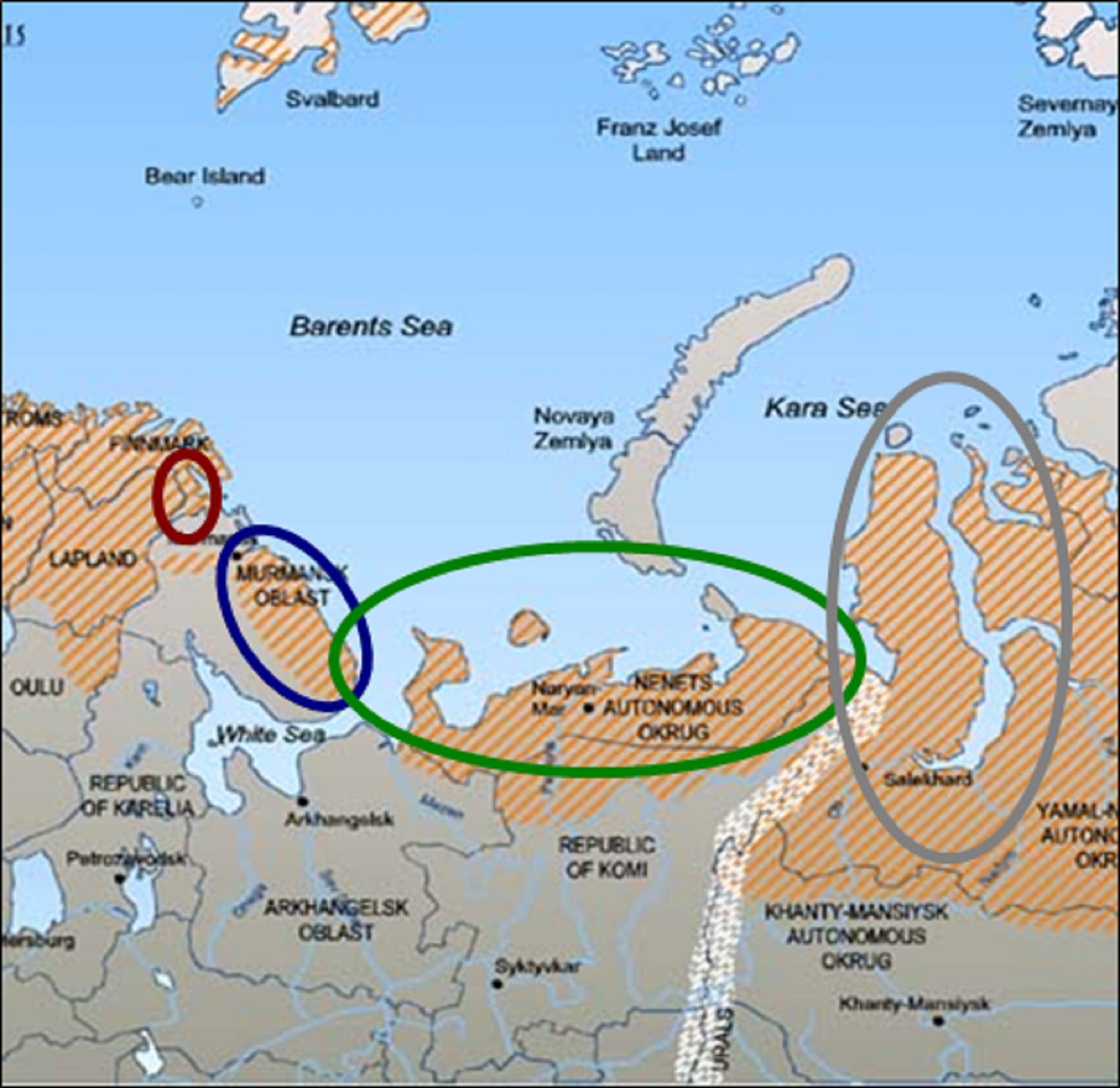
Arctic Indigenous Groups
Skolt Sami (red ), Kola Sami (blue), European Nenets (green), Yamal Nenets (gray)
“Nenets Autnomous Okrug, North West Russia, 6 400 Nenets people, of which around 1 500 live in the tundra. A nomadic and semi-nomadic life herding reindeer, fishing, and hunting. Language: Nenets, spoken mostly by elders. They manage around 180 000 reindeer, the majority in collective farms, but increasingly in family-based communities (obshina). Herding is done with close herd supervision for most of the year, including work 24 hours a day. Other than among full-time nomads, the rest of herding is done by village based men, for whom the tundra is a working place. Northern Finnish Lapland, Inari municipality, 700 Skolt Sami, villages of Sevettijärvi, Nellim, and Keväjärvi, a few in Neiden (Norway), and Tuloma, Verkhnetulomsk, Jona villages in Northwesternmost Russia. Original territories were in the Petsämö region until WW II. When their territory had to be ceded back to the Soviet Union, most were resettled to Finland where they live now. Skolt Sámi language is spoken by approximately 350 speakers. Their earlier livelihood was based on reindeer herding, hunting, fishing, and gathering. Nowadays only reindeer herding and fishing have retained some economic relevance. They are practiced in an extensive form in the two Skolt herding districts of Näätämö and Vätsäri in which they manage about 6500 reindeer.” ref
“Yamal-Nenets Autonomous Okrug, east of Ural Mountains, 28 000 Nenets people, of which roughly 10 000 lead a nomadic way of live on the tundra herding reindeer, fishing and hunting. Language: Tundra Nenets, widely spoken among herders. They manage around 500 000 reindeer, the world’s largest number in one region, mostly in private ownership. Herding is done in close herd supervision for most of the year, including work 24 hours a day. Yamal-Nenets herding is considered the best-preserved reindeer nomadism on our planet. Murmansk Oblast, North West Russia. 2000 Sami, a third of whom live in Lovozero village. Language: mostly Kildin Saami, 67 000 reindeer, of which 7 000 are in private ownership. Most reindeer herding is done in the successors of state farms. Herding is done in work shifts of men out on the tundra, in loose herding. Reindeer are released for the summer after the closely monitored calving campaign, and rounded up in the fall before slaughtering. Fishing and hunting in spring and autumn are of equal importance. Sami on the Kola Peninsula live together with the Komi and Nenets, and their material culture, clothing, and religion are incorporated into this mixture.” ref
Russia Gives Away Free Arctic Land to Citizens
“Russian citizens can now claim one free hectare of land in its Arctic zone as the government seeks to expand its development of the fast-warming region, the Rossiyskaya Gazeta newspaper reported Feb. 2022. The Arctic Hectare program will extend to Russians nationwide from Tuesday after a six-month period in which only residents of the Arctic were eligible. Citizens can apply through an official portal for a plot of land in the Murmansk region, the Nenets autonomous district, the Arctic Indigenous Groups’ Yamal-Nenets autonomous district, the republic of Karelia, the republic of Komi, or the Arkhangelsk region.” ref
“The largest number of available plots can be found in the Murmansk region (more than 700,000 hectares) and the republic of Karelia (337,000 hectares). Initially, land plots are issued for a five-year period. Afterwards, citizens can choose to rent, sell or give away the land if they no longer wish to own it. Land plots are also available to participants in the state program for repatriating ethnic Russians living abroad. Russia has offered citizens a free hectare of land from “Indigenous Group Areas” in its sparsely populated Far East regions since 2017.” ref
“The Far East and Arctic Hectare programs’ online portal boasts of success stories including an eco-glamping resort in Chukotka, a strawberry plantation in the Khabarovsk region, and an Arctic poultry farm. The Arctic Hectare program comes as Russia races to take advantage of the region’s economic and strategic potential as it warms at a record pace. Moscow has been heavily investing in the development of the Northern Sea Route, which it touts as a cheaper, faster alternative to the Suez Canal for shipping between Europe and Asia. But scientists say that Russia is losing growing amounts of Arctic coast due to climate change, and the region is heating more than twice as fast as the planet as a whole — risking a feedback loop of accelerated warming.” ref
Read More on Indigenous peoples of Siberia
“The Russian Far East (Russian: Дальний Восток России) is a region in Northeast Asia. It is the easternmost part of Russia and the Asian continent; and is administered as part of the Far Eastern Federal District, which is located between Lake Baikal in eastern Siberia and the Pacific Ocean. The area’s largest city is Khabarovsk, followed by Vladivostok. The region shares land borders with the countries of Mongolia, China, and North Korea to its south, as well as maritime boundaries with Japan to its southeast, and with the United States along the Bering Strait to its northeast. Although the Russian Far East is often considered as a part of Siberia abroad, it has been historically categorized separately from Siberia in Russian regional schemes (and previously during the Soviet era when it was called the Soviet Far East).” ref
“Russians reached the Pacific coast in 1647 with the establishment of Okhotsk, and the Russian Empire consolidated its control over the Russian Far East in the 19th century, after the annexation of part of Chinese Manchuria (1858-1860). Primorskaya Oblast was established as a separate administrative division of the Russian Empire in 1856, with its administrative center at Khabarovsk. Until 2000 the Russian Far East lacked officially-defined boundaries. A single term “Siberia and the Far East” (Сибирь и Дальний Восток) often referred to Russia’s regions east of the Urals without drawing a clear distinction between “Siberia” and “the Far East.” ref
“In 2000 Russia’s federal subjects were grouped into larger federal districts, one of which, the Far Eastern Federal District, comprised Amur Oblast, the Chukotka Autonomous Okrug, the Jewish Autonomous Oblast, Kamchatka Oblast with the Koryak Autonomous Okrug, Khabarovsk Krai, Magadan Oblast, Primorsky Krai, the Sakha (Yakutia) Republic, and Sakhalin Oblast. In November 2018 Zabaykalsky Krai and the Republic of Buryatia were added they had previously formed part of the Siberian Federal District.[16] Since 2000, Russians have increasingly used the term “Far East” to refer to the federal district, though the term is often also used more loosely. Defined by the boundaries of the federal district, the Far East has an area of 6.2 million square kilometres (2,400,000 sq mi)—over one-third of Russia’s total area.” ref
“Between 1937 and 1939, the Soviet Union under Joseph Stalin deported over 200,000 Koreans to Uzbekistan and Kazakhstan, fearing that the Koreans might act as spies for Japan. Many Koreans died on the way in cattle trains due to starvation, illness, or freezing conditions. Soviet authorities purged and executed many community leaders; Koryo-saram were not allowed to travel outside of Central Asia for the next 15 years. Koreans were also not allowed to use the Korean language and its use began to become lost with the involvement of the Koryo-mar dialect and the use of Russian.” ref
“Development of numerous remote locations in the Soviet Far East relied on Gulag labor camps during Stalin’s rule, especially in the region’s northern half. After the death of Stalin in 1953 the large-scale use of forced labor waned and was superseded by volunteer employees attracted by relatively high wages. During the Japanese invasion of Manchuria in 1931, the Soviets occupied Bolshoy Ussuriysky Island, Yinlong Island, and several adjacent islets to separate the city of Khabarovsk from the territory controlled by a possibly hostile power.” ref
“Indeed, Japan turned its military attention to Soviet territories. Conflicts between the Japanese and the Soviets frequently happened on the border of Manchuria between 1938 and 1945. The first confrontation occurred in Primorsky Krai, the Battle of Lake Khasan (July–August 1938) involved an attempted military incursion of Japanese-controlled Manchukuo into territory claimed by the Soviet Union. This incursion was founded in the beliefs of the Japanese side that the Soviet Union had misinterpreted the demarcation of the boundary based on the 1860 Treaty of Peking between Imperial Russia and Manchu China. Primorsky Krai was always threatened by a Japanese invasion despite the fact that most of the remaining clashes occurred in Manchukuo.” ref
“The clashes ended shortly before and after the conclusion of World War II (see Soviet–Japanese War) when a war-weakened Japan found its territories of Manchukuo, Mengjiang, Korea, and South Sakhalin invaded by Soviet and Mongolian troops (August 1945). Both the Soviet Union and Japan regarded the Primorsky Krai as a strategic location in World War II, and clashes over the territory were common. The Soviets and the other Allies considered it a key location for the planned invasion of Japan through Korea; Japan viewed it as a key location to begin a mass invasion of Eastern Russia. The Primorsky Krai served as the Soviet Union’s Pacific headquarters in the war to plan an invasion for allied troops of Korea in order to reach Japan.” ref
“After the Soviet invasion, the USSR returned Manchukuo and Mengjiang to China; Korea became liberated. The Soviet Union also occupied and annexed Japan’s Kuril Islands and southern Sakhalin. The planned Soviet invasion of Japan proper never happened. During the Korean War, Primorsky Krai became the site of extreme security concern for the Soviet Union. Vladivostok became the site of the Strategic Arms Limitation Talks in 1974. At the time, the Soviet Union and the United States decided quantitative limits on various nuclear weapons systems and banned the construction of new land-based ICBM launchers. Vladivostok and other cities in Primorsky Krai soon became closed cities because of the bases of the Soviet Pacific Fleet.” ref
“Incursions of American reconnaissance aircraft from Alaska sometimes happened. Concerns of the Soviet military caused the infamous Korean Air Lines Flight 007 incident in 1983. In 2016, President Vladimir Putin proposed the Russian Homestead Act to populate the Russian Far East.” ref

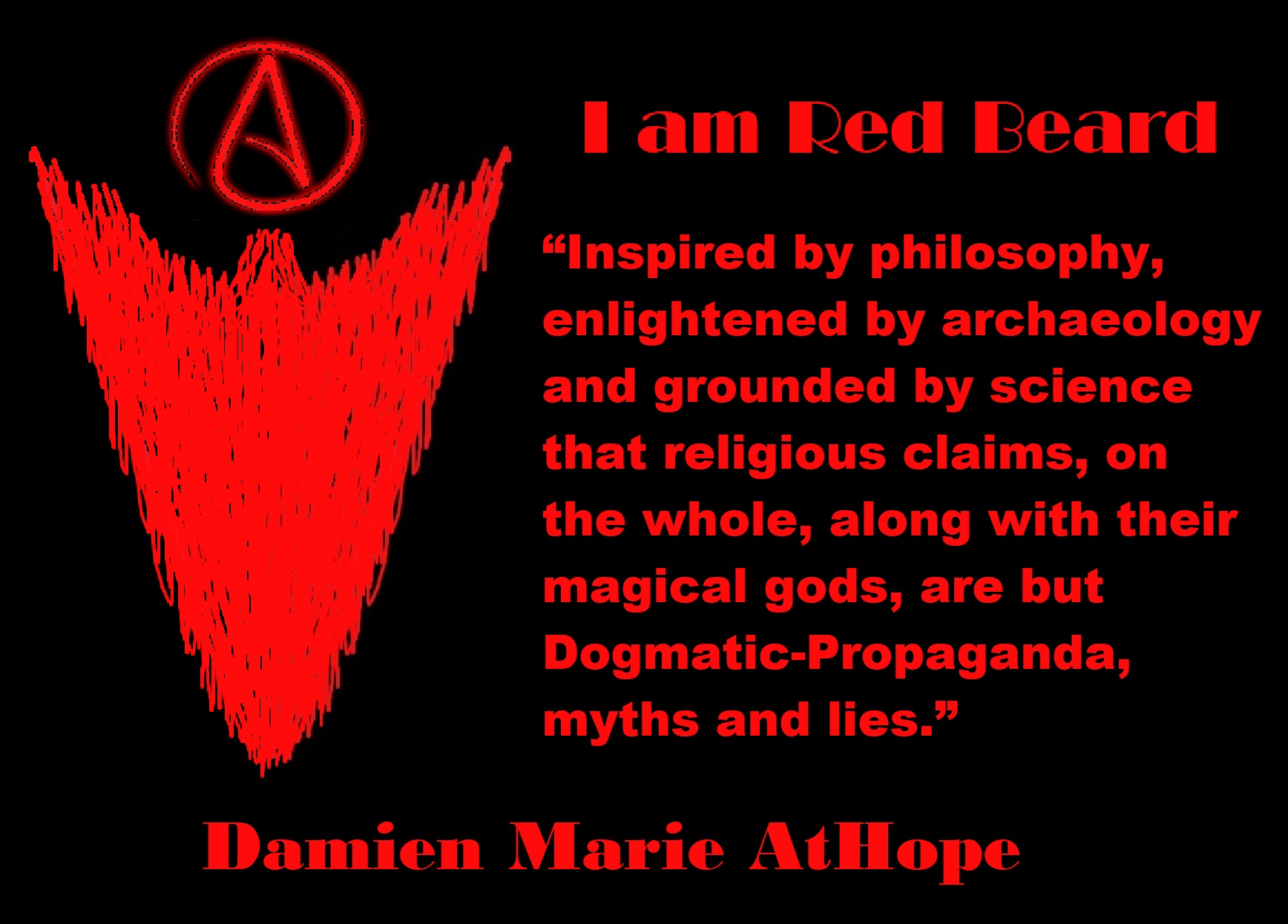
People don’t commonly teach religious history, even that of their own claimed religion. No, rather they teach a limited “pro their religion” history of their religion from a religious perspective favorable to the religion of choice.
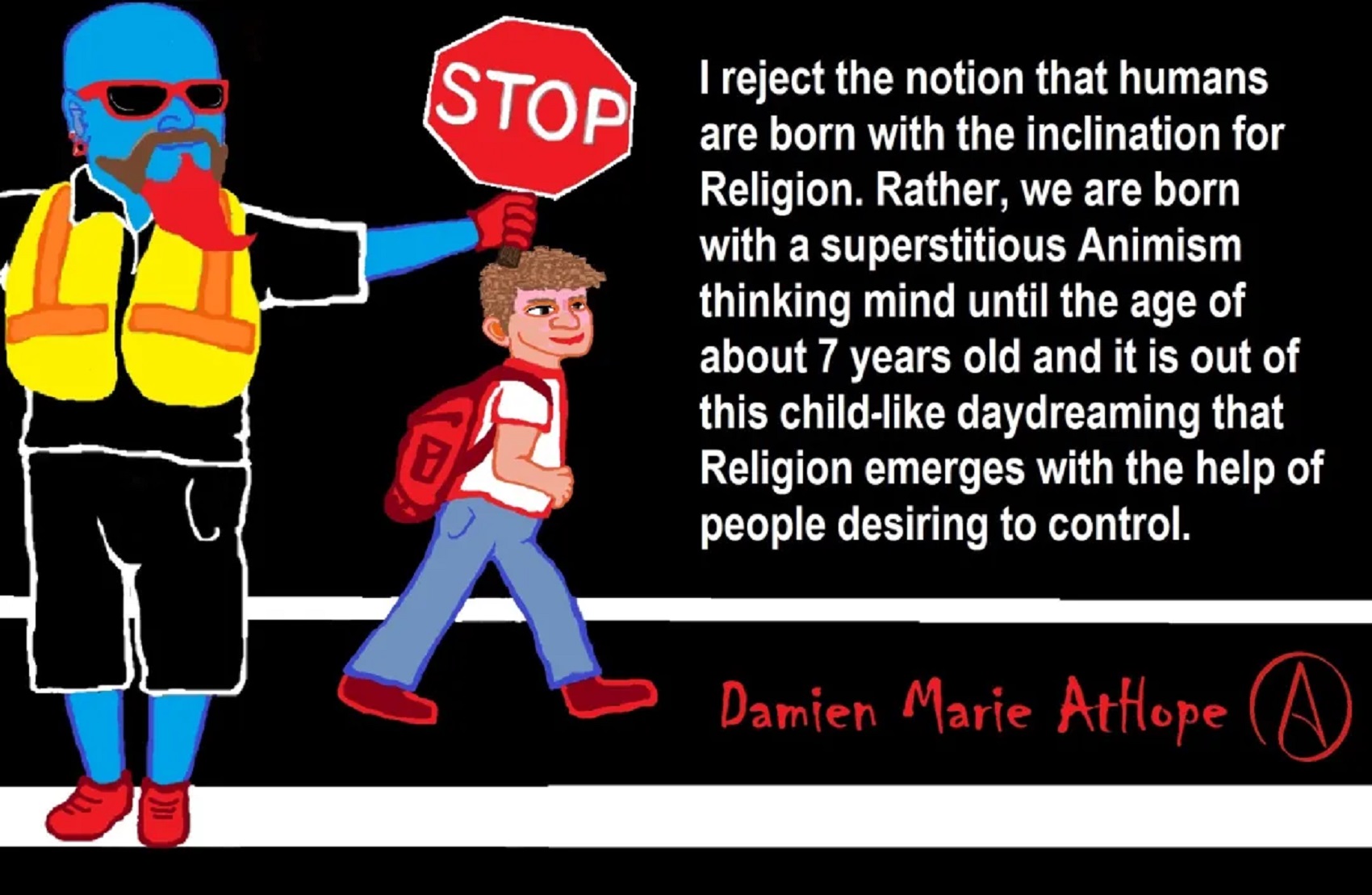
Do you truly think “Religious Belief” is only a matter of some personal choice?
Do you not see how coercive one’s world of choice is limited to the obvious hereditary belief, in most religious choices available to the child of religious parents or caregivers? Religion is more commonly like a family, culture, society, etc. available belief that limits the belief choices of the child and that is when “Religious Belief” is not only a matter of some personal choice and when it becomes hereditary faith, not because of the quality of its alleged facts or proposed truths but because everyone else important to the child believes similarly so they do as well simply mimicking authority beliefs handed to them. Because children are raised in religion rather than being presented all possible choices but rather one limited dogmatic brand of “Religious Belief” where children only have a choice of following the belief as instructed, and then personally claim the faith hereditary belief seen in the confirming to the belief they have held themselves all their lives. This is obvious in statements asked and answered by children claiming a faith they barely understand but they do understand that their family believes “this or that” faith, so they feel obligated to believe it too. While I do agree that “Religious Belief” should only be a matter of some personal choice, it rarely is… End Hereditary Religion!
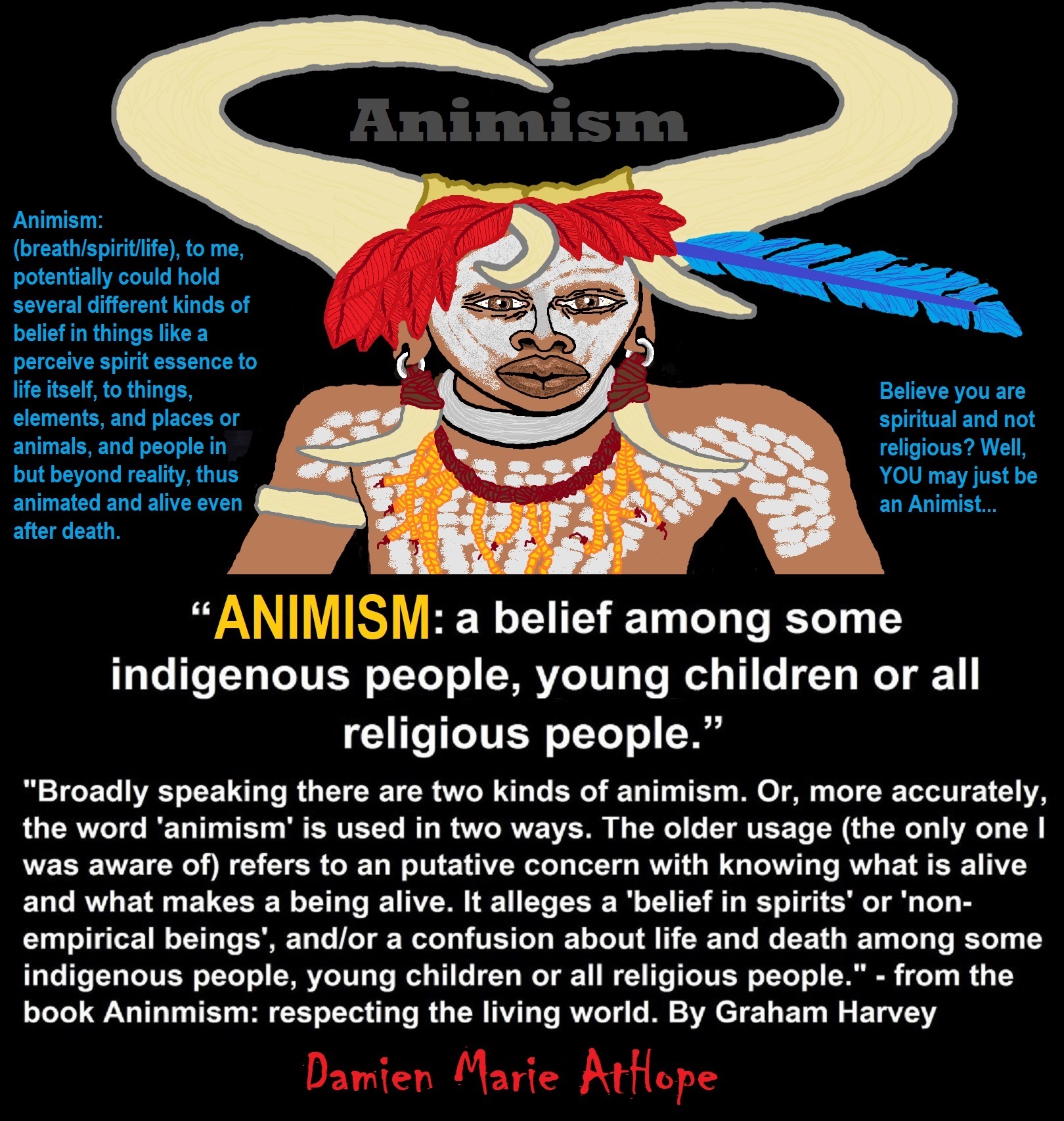
Animism: Respecting the Living World by Graham Harvey
“How have human cultures engaged with and thought about animals, plants, rocks, clouds, and other elements in their natural surroundings? Do animals and other natural objects have a spirit or soul? What is their relationship to humans? In this new study, Graham Harvey explores current and past animistic beliefs and practices of Native Americans, Maori, Aboriginal Australians, and eco-pagans. He considers the varieties of animism found in these cultures as well as their shared desire to live respectfully within larger natural communities. Drawing on his extensive casework, Harvey also considers the linguistic, performative, ecological, and activist implications of these different animisms.” ref

We are like believing machines we vacuum up ideas, like Velcro sticks to almost everything. We accumulate beliefs that we allow to negatively influence our lives, often without realizing it. Our willingness must be to alter skewed beliefs that impend our balance or reason, which allows us to achieve new positive thinking and accurate outcomes.
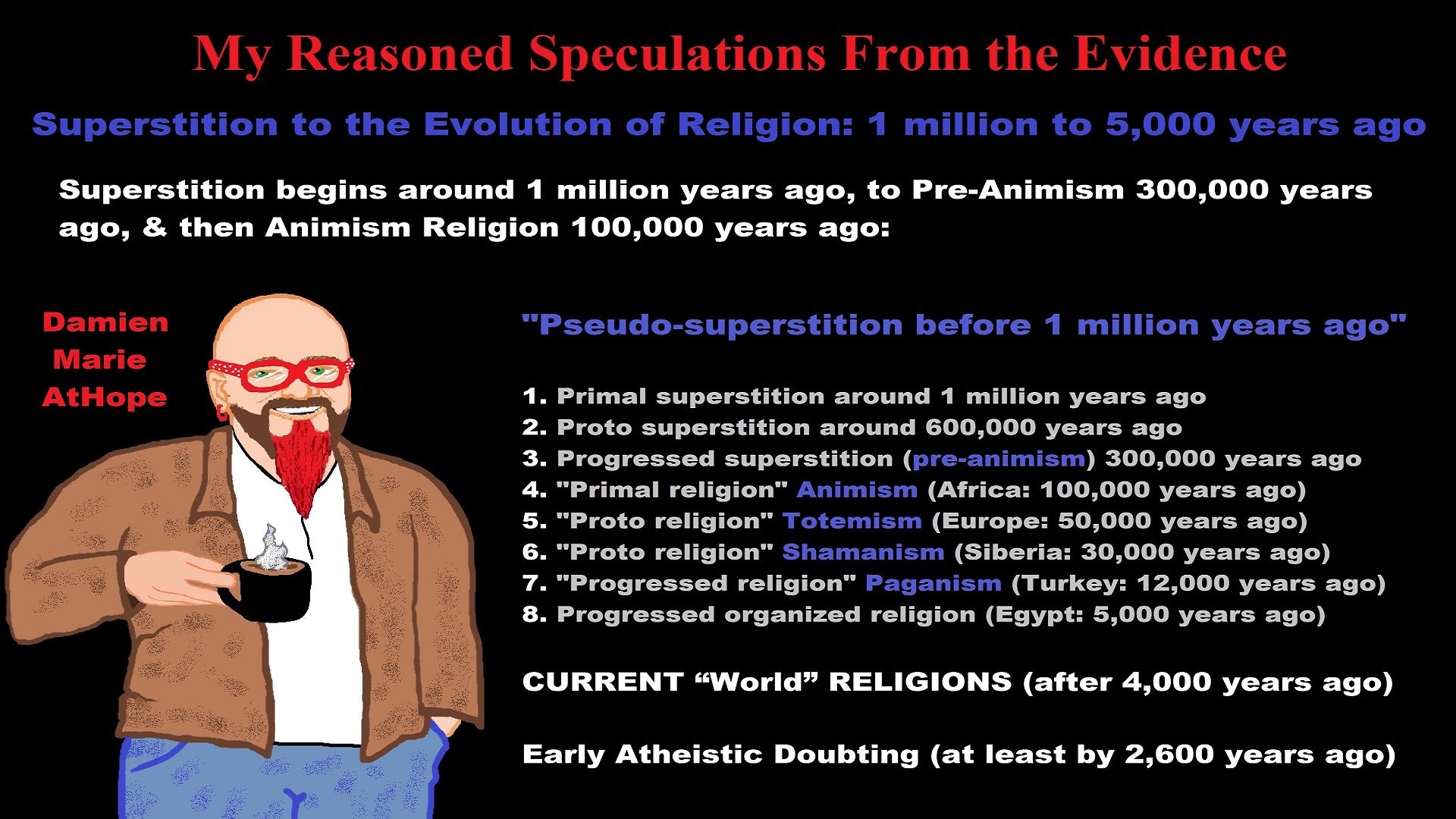
My thoughts on Religion Evolution with external links for more info:
- (Pre-Animism Africa mainly, but also Europe, and Asia at least 300,000 years ago), (Pre-Animism – Oxford Dictionaries)
- (Animism Africa around 100,000 years ago), (Animism – Britannica.com)
- (Totemism Europe around 50,000 years ago), (Totemism – Anthropology)
- (Shamanism Siberia around 30,000 years ago), (Shamanism – Britannica.com)
- (Paganism Turkey around 12,000 years ago), (Paganism – BBC Religion)
- (Progressed Organized Religion “Institutional Religion” Egypt around 5,000 years ago), (Ancient Egyptian Religion – Britannica.com)
- (CURRENT “World” RELIGIONS after 4,000 years ago) (Origin of Major Religions – Sacred Texts)
- (Early Atheistic Doubting at least by 2,600 years ago) (History of Atheism – Wikipedia)
“Religion is an Evolved Product” and Yes, Religion is Like Fear Given Wings…
Atheists talk about gods and religions for the same reason doctors talk about cancer, they are looking for a cure, or a firefighter talks about fires because they burn people and they care to stop them. We atheists too often feel a need to help the victims of mental slavery, held in the bondage that is the false beliefs of gods and the conspiracy theories of reality found in religions.
Understanding Religion Evolution:
- Pre-Animism (at least 300,000 years ago)
- Animism (Africa: 100,000 years ago)
- Totemism (Europe: 50,000 years ago)
- Shamanism (Siberia: 30,000 years ago)
- Paganism (Turkey: 12,000 years ago)
- Progressed organized religion (Egypt: 5,000 years ago), (Egypt, the First Dynasty 5,150 years ago)
- CURRENT “World” RELIGIONS (after 4,000 years ago)
- Early Atheistic Doubting (at least by 2,600 years ago)
“An Archaeological/Anthropological Understanding of Religion Evolution”
It seems ancient peoples had to survived amazing threats in a “dangerous universe (by superstition perceived as good and evil),” and human “immorality or imperfection of the soul” which was thought to affect the still living, leading to ancestor worship. This ancestor worship presumably led to the belief in supernatural beings, and then some of these were turned into the belief in gods. This feeble myth called gods were just a human conceived “made from nothing into something over and over, changing, again and again, taking on more as they evolve, all the while they are thought to be special,” but it is just supernatural animistic spirit-belief perceived as sacred.
Quick Evolution of Religion?
Pre-Animism (at least 300,000 years ago) pre-religion is a beginning that evolves into later Animism. So, Religion as we think of it, to me, all starts in a general way with Animism (Africa: 100,000 years ago) (theoretical belief in supernatural powers/spirits), then this is physically expressed in or with Totemism (Europe: 50,000 years ago) (theoretical belief in mythical relationship with powers/spirits through a totem item), which then enlists a full-time specific person to do this worship and believed interacting Shamanism (Siberia/Russia: 30,000 years ago) (theoretical belief in access and influence with spirits through ritual), and then there is the further employment of myths and gods added to all the above giving you Paganism (Turkey: 12,000 years ago) (often a lot more nature-based than most current top world religions, thus hinting to their close link to more ancient religious thinking it stems from). My hypothesis is expressed with an explanation of the building of a theatrical house (modern religions development). Progressed organized religion (Egypt: 5,000 years ago) with CURRENT “World” RELIGIONS (after 4,000 years ago).
Historically, in large city-state societies (such as Egypt or Iraq) starting around 5,000 years ago culminated to make religion something kind of new, a sociocultural-governmental-religious monarchy, where all or at least many of the people of such large city-state societies seem familiar with and committed to the existence of “religion” as the integrated life identity package of control dynamics with a fixed closed magical doctrine, but this juggernaut integrated religion identity package of Dogmatic-Propaganda certainly did not exist or if developed to an extent it was highly limited in most smaller prehistoric societies as they seem to lack most of the strong control dynamics with a fixed closed magical doctrine (magical beliefs could be at times be added or removed). Many people just want to see developed religious dynamics everywhere even if it is not. Instead, all that is found is largely fragments until the domestication of religion.
Religions, as we think of them today, are a new fad, even if they go back to around 6,000 years in the timeline of human existence, this amounts to almost nothing when seen in the long slow evolution of religion at least around 70,000 years ago with one of the oldest ritual worship. Stone Snake of South Africa: “first human worship” 70,000 years ago. This message of how religion and gods among them are clearly a man-made thing that was developed slowly as it was invented and then implemented peace by peace discrediting them all. Which seems to be a simple point some are just not grasping how devastating to any claims of truth when we can see the lie clearly in the archeological sites.
I wish people fought as hard for the actual values as they fight for the group/clan names political or otherwise they think support values. Every amount spent on war is theft to children in need of food or the homeless kept from shelter.
Here are several of my blog posts on history:
- To Find Truth You Must First Look
- (Magdalenian/Iberomaurusian) Connections to the First Paganists of the early Neolithic Near East Dating from around 17,000 to 12,000 Years Ago
- Natufians: an Ancient People at the Origins of Agriculture and Sedentary Life
- Possible Clan Leader/Special “MALE” Ancestor Totem Poles At Least 13,500 years ago?
- Jewish People with DNA at least 13,200 years old, Judaism, and the Origins of Some of its Ideas
- Baltic Reindeer Hunters: Swiderian, Lyngby, Ahrensburgian, and Krasnosillya cultures 12,020 to 11,020 years ago are evidence of powerful migratory waves during the last 13,000 years and a genetic link to Saami and the Finno-Ugric peoples.
- The Rise of Inequality: patriarchy and state hierarchy inequality
- Fertile Crescent 12,500 – 9,500 Years Ago: fertility and death cult belief system?
- 12,400 – 11,700 Years Ago – Kortik Tepe (Turkey) Pre/early-Agriculture Cultic Ritualism
- Ritualistic Bird Symbolism at Gobekli Tepe and its “Ancestor Cult”
- Male-Homosexual (female-like) / Trans-woman (female) Seated Figurine from Gobekli Tepe
- Could a 12,000-year-old Bull Geoglyph at Göbekli Tepe relate to older Bull and Female Art 25,000 years ago and Later Goddess and the Bull cults like Catal Huyuk?
- Sedentism and the Creation of goddesses around 12,000 years ago as well as male gods after 7,000 years ago.
- Alcohol, where Agriculture and Religion Become one? Such as Gobekli Tepe’s Ritualistic use of Grain as Food and Ritual Drink
- Neolithic Ritual Sites with T-Pillars and other Cultic Pillars
- Paganism: Goddesses around 12,000 years ago then Male Gods after 7,000 years ago
- First Patriarchy: Split of Women’s Status around 12,000 years ago & First Hierarchy: fall of Women’s Status around 5,000 years ago.
- Natufians: an Ancient People at the Origins of Agriculture and Sedentary Life
- J DNA and the Spread of Agricultural Religion (paganism)
- Paganism: an approximately 12,000-year-old belief system
- Paganism 12,000 years old: related to “Anarchism and Socialism” (Pre-Capitalism)
- Shaman burial in Israel 12,000 years ago and the Shamanism Phenomena
- Need to Mythicized: gods and goddesses
- 12,000 – 7,000 Years Ago – Paleo-Indian Culture (The Americas)
- 12,000 – 2,000 Years Ago – Indigenous-Scandinavians (Nordic)
- Norse did not wear helmets with horns?
- Pre-Pottery Neolithic Skull Cult around 11,500 to 8,400 Years Ago?
- 10,400 – 10,100 Years Ago, in Turkey the Nevail Cori Religious Settlement
- 9,000-6,500 Years Old Submerged Pre-Pottery/Pottery Neolithic Ritual Settlements off Israel’s Coast
- Catal Huyuk “first religious designed city” around 9,500 to 7,700 years ago (Turkey)
- Cultic Hunting at Catal Huyuk “first religious designed city”
- Special Items and Art as well as Special Elite Burials at Catal Huyuk
- New Rituals and Violence with the appearance of Pottery and People?
- Haplogroup N and its related Uralic Languages and Cultures
- Ainu people, Sámi people, Native Americans, the Ancient North Eurasians, and Paganistic-Shamanism with Totemism
- Ideas, Technology and People from Turkey, Europe, to China and Back again 9,000 to 5,000 years ago?
- First Pottery of Europe and the Related Cultures
- 9,000 years old Neolithic Artifacts Judean Desert and Hills Israel
- 9,000-7,000 years-old Sex and Death Rituals: Cult Sites in Israel, Jordan, and the Sinai
- 9,000-8500 year old Horned Female shaman Bad Dürrenberg Germany
- Neolithic Jewelry and the Spread of Farming in Europe Emerging out of West Turkey
- 8,600-year-old Tortoise Shells in Neolithic graves in central China have Early Writing and Shamanism
- Swing of the Mace: the rise of Elite, Forced Authority, and Inequality begin to Emerge 8,500 years ago?
- Migrations and Changing Europeans Beginning around 8,000 Years Ago
- My “Steppe-Anatolian-Kurgan hypothesis” 8,000/7,000 years ago
- Around 8,000-year-old Shared Idea of the Mistress of Animals, “Ritual” Motif
- Pre-Columbian Red-Paint (red ochre) Maritime Archaic Culture 8,000-3,000 years ago
- 7,522-6,522 years ago Linear Pottery culture which I think relates to Arcane Capitalism’s origins
- Arcane Capitalism: Primitive socialism, Primitive capital, Private ownership, Means of production, Market capitalism, Class discrimination, and Petite bourgeoisie (smaller capitalists)
- 7,500-4,750 years old Ritualistic Cucuteni-Trypillian culture of Moldova, Romania, and Ukraine
- Roots of a changing early society 7,200-6,700 years ago Jordan and Israel
- Agriculture religion (Paganism) with farming reached Britain between about 7,000 to 6,500 or so years ago and seemingly expressed in things like Western Europe’s Long Barrows
- My Thoughts on Possible Migrations of “R” DNA and Proto-Indo-European?
- “Millet” Spreading from China 7,022 years ago to Europe and related Language may have Spread with it leading to Proto-Indo-European
- Proto-Indo-European (PIE), ancestor of Indo-European languages: DNA, Society, Language, and Mythology
- The Dnieper–Donets culture and Asian varieties of Millet from China to the Black Sea region of Europe by 7,022 years ago
- Kurgan 6,000 years ago/dolmens 7,000 years ago: funeral, ritual, and other?
- 7,020 to 6,020-year-old Proto-Indo-European Homeland of Urheimat or proposed home of their Language and Religion
- Ancient Megaliths: Kurgan, Ziggurat, Pyramid, Menhir, Trilithon, Dolman, Kromlech, and Kromlech of Trilithons
- The Mytheme of Ancient North Eurasian Sacred-Dog belief and similar motifs are found in Indo-European, Native American, and Siberian comparative mythology
- Elite Power Accumulation: Ancient Trade, Tokens, Writing, Wealth, Merchants, and Priest-Kings
- Sacred Mounds, Mountains, Kurgans, and Pyramids may hold deep connections?
- Between 7,000-5,000 Years ago, rise of unequal hierarchy elite, leading to a “birth of the State” or worship of power, strong new sexism, oppression of non-elites, and the fall of Women’s equal status
- Paganism 7,000-5,000 years old: related to “Anarchism and Socialism” (Capitalism) (World War 0) Elite & their slaves
- Hell and Underworld mythologies starting maybe as far back as 7,000 to 5,000 years ago with the Proto-Indo-Europeans?
- The First Expression of the Male God around 7,000 years ago?
- White (light complexion skin) Bigotry and Sexism started 7,000 years ago?
- Around 7,000-year-old Shared Idea of the Divine Bird (Tutelary and/or Trickster spirit/deity), “Ritual” Motif
- Nekhbet an Ancient Egyptian Vulture Goddess and Tutelary Deity
- 6,720 to 4,920 years old Ritualistic Hongshan Culture of Inner Mongolia with 5,000-year-old Pyramid Mounds and Temples
- First proto-king in the Balkans, Varna culture around 6,500 years ago?
- 6,500–5,800 years ago in Israel Late Chalcolithic (Copper Age) Period in the Southern Levant Seems to Express Northern Levant Migrations, Cultural and Religious Transfer
- KING OF BEASTS: Master of Animals “Ritual” Motif, around 6,000 years old or older…
- Around 6000-year-old Shared Idea of the Solid Wheel & the Spoked Wheel-Shaped Ritual Motif
- “The Ghassulian Star,” a mysterious 6,000-year-old mural from Jordan; a Proto-Star of Ishtar, Star of Inanna or Star of Venus?
- Religious/Ritual Ideas, including goddesses and gods as well as ritual mounds or pyramids from Northeastern Asia at least 6,000 years old, seemingly filtering to Iran, Iraq, the Mediterranean, Europe, Egypt, and the Americas?
- Maykop (5,720–5,020 years ago) Caucasus region Bronze Age culture-related to Copper Age farmers from the south, influenced by the Ubaid period and Leyla-Tepe culture, as well as influencing the Kura-Araxes culture
- 5-600-year-old Tomb, Mummy, and First Bearded Male Figurine in a Grave
- Kura-Araxes Cultural 5,520 to 4,470 years old DNA traces to the Canaanites, Arabs, and Jews
- Minoan/Cretan (Keftiu) Civilization and Religion around 5,520 to 3,120 years ago
- Evolution Of Science at least by 5,500 years ago
- 5,500 Years old birth of the State, the rise of Hierarchy, and the fall of Women’s status
- “Jiroft culture” 5,100 – 4,200 years ago and the History of Iran
- Stonehenge: Paganistic Burial and Astrological Ritual Complex, England (5,100-3,600 years ago)
- Around 5,000-year-old Shared Idea of the “Tree of Life” Ritual Motif
- Complex rituals for elite, seen from China to Egypt, at least by 5,000 years ago
- Around 5,000 years ago: “Birth of the State” where Religion gets Military Power and Influence
- The Center of the World “Axis Mundi” and/or “Sacred Mountains” Mythology Could Relate to the Altai Mountains, Heart of the Steppe
- Progressed organized religion starts, an approximately 5,000-year-old belief system
- China’s Civilization between 5,000-3,000 years ago, was a time of war and class struggle, violent transition from free clans to a Slave or Elite society
- Origin of Logics is Naturalistic Observation at least by around 5,000 years ago.
- Paganism 5,000 years old: progressed organized religion and the state: related to “Anarchism and Socialism” (Kings and the Rise of the State)
- Ziggurats (multi-platform temples: 4,900 years old) to Pyramids (multi-platform tombs: 4,700 years old)
- Did a 4,520–4,420-year-old Volcano In Turkey Inspire the Bible God?
- Finland’s Horned Shaman and Pre-Horned-God at least 4,500 years ago?
- 4,000-year-Old Dolmens in Israel: A Connected Dolmen Religious Phenomenon?
- Creation myths: From chaos, Ex nihilo, Earth-diver, Emergence, World egg, and World parent
- Bronze Age “Ritual” connections of the Bell Beaker culture with the Corded Ware/Single Grave culture, which were related to the Yamnaya culture and Proto-Indo-European Languages/Religions
- Low Gods (Earth/ Tutelary deity), High Gods (Sky/Supreme deity), and Moralistic Gods (Deity enforcement/divine order)
- The exchange of people, ideas, and material-culture including, to me, the new god (Sky Father) and goddess (Earth Mother) religion between the Cucuteni-Trypillians and others which is then spread far and wide
- Koryaks: Indigenous People of the Russian Far East and Big Raven myths also found in Tlingit, Haida, Tsimshian, and other Indigenous People of North America
- 42 Principles Of Maat (Egyptian Goddess of the justice) around 4,400 years ago, 2000 Years Before Ten Commandments
- “Happy Easter” Well Happy Eostre/Ishter
- 4,320-3,820 years old “Shimao” (North China) site with Totemistic-Shamanistic Paganism and a Stepped Pyramid
- 4,250 to 3,400 Year old Stonehenge from Russia: Arkaim?
- 4,100-year-old beaker with medicinal & flowering plants in a grave of a woman in Scotland
- Early European Farmer ancestry, Kelif el Boroud people with the Cardial Ware culture, and the Bell Beaker culture Paganists too, spread into North Africa, then to the Canary Islands off West Africa
- Flood Accounts: Gilgamesh epic (4,100 years ago) Noah in Genesis (2,600 years ago)
- Paganism 4,000 years old: related to “Anarchism and Socialism” (First Moralistic gods, then the Origin time of Monotheism)
- When was the beginning: TIMELINE OF CURRENT RELIGIONS, which start around 4,000 years ago.
- Early Religions Thought to Express Proto-Monotheistic Systems around 4,000 years ago
- Kultepe? An archaeological site with a 4,000 years old women’s rights document.
- Single God Religions (Monotheism) = “Man-o-theism” started around 4,000 years ago with the Great Sky Spirit/God Tiān (天)?
- Confucianism’s Tiān (Shangdi god 4,000 years old): Supernaturalism, Pantheism or Theism?
- Yes, Your Male God is Ridiculous
- Mythology, a Lunar Deity is a Goddess or God of the Moon
- Sacred Land, Hills, and Mountains: Sami Mythology (Paganistic Shamanism)
- Horse Worship/Sacrifice: mythical union of Ruling Elite/Kingship and the Horse
- The Amorite/Amurru people’s God Amurru “Lord of the Steppe”, relates to the Origins of the Bible God?
- Bronze Age Exotic Trade Routes Spread Quite Far as well as Spread Religious Ideas with Them
- Sami and the Northern Indigenous Peoples Landscape, Language, and its Connection to Religion
- Prototype of Ancient Analemmatic Sundials around 3,900-3,150 years ago and a Possible Solar Connection to gods?
- Judaism is around 3,450 or 3,250 years old. (“Paleo-Hebrew” 3,000 years ago and Torah 2,500 years ago)
- The Weakening of Ancient Trade and the Strengthening of Religions around 3000 years ago?
- Are you aware that there are religions that worship women gods, explain now religion tears women down?
- Animistic, Totemistic, and Paganistic Superstition Origins of bible god and the bible’s Religion.
- Myths and Folklore: “Trickster gods and goddesses”
- Jews, Judaism, and the Origins of Some of its Ideas
- An Old Branch of Religion Still Giving Fruit: Sacred Trees
- Dating the BIBLE: naming names and telling times (written less than 3,000 years ago, provable to 2,200 years ago)
- Did a Volcano Inspire the bible god?
- Dené–Yeniseian language, Old Copper Complex, and Pre-Columbian Mound Builders?
- No “dinosaurs and humans didn’t exist together just because some think they are in the bible itself”
- Sacred Shit and Sacred Animals?
- Everyone Killed in the Bible Flood? “Nephilim” (giants)?
- Hey, Damien dude, I have a question for you regarding “the bible” Exodus.
- Archaeology Disproves the Bible
- Bible Battle, Just More, Bible Babble
- The Jericho Conquest lie?
- Canaanites and Israelites?
- Accurate Account on how did Christianity Began?
- Let’s talk about Christianity.
- So the 10 commandments isn’t anything to go by either right?
- Misinformed christian
- Debunking Jesus?
- Paulism vs Jesus
- Ok, you seem confused so let’s talk about Buddhism.
- Unacknowledged Buddhism: Gods, Savior, Demons, Rebirth, Heavens, Hells, and Terrorism
- His Foolishness The Dalai Lama
- Yin and Yang is sexist with an ORIGIN around 2,300 years ago?
- I Believe Archaeology, not Myths & Why Not, as the Religious Myths Already Violate Reason!
- Archaeological, Scientific, & Philosophic evidence shows the god myth is man-made nonsense.
- Aquatic Ape Theory/Hypothesis? As Always, Just Pseudoscience.
- Ancient Aliens Conspiracy Theorists are Pseudohistorians
- The Pseudohistoric and Pseudoscientific claims about “Bakoni Ruins” of South Africa
- Why do people think Religion is much more than supernaturalism and superstitionism?
- Religion is an Evolved Product
- Was the Value of Ancient Women Different?
- 1000 to 1100 CE, human sacrifice Cahokia Mounds a pre-Columbian Native American site
- Feminist atheists as far back as the 1800s?
- Promoting Religion as Real is Mentally Harmful to a Flourishing Humanity
- Screw All Religions and Their Toxic lies, they are all fraud
- Forget Religions’ Unfounded Myths, I Have Substantiated “Archaeology Facts.”
- Religion Dispersal throughout the World
- I Hate Religion Just as I Hate all Pseudoscience
- Exposing Scientology, Eckankar, Wicca and Other Nonsense?
- Main deity or religious belief systems
- Quit Trying to Invent Your God From the Scraps of Science.
- Archaeological, Scientific, & Philosophic evidence shows the god myth is man-made nonsense.
- Ancient Alien Conspiracy Theorists: Misunderstanding, Rhetoric, Misinformation, Fabrications, and Lies
- Misinformation, Distortion, and Pseudoscience in Talking with a Christian Creationist
- Judging the Lack of Goodness in Gods, Even the Norse God Odin
- Challenging the Belief in God-like Aliens and Gods in General
- A Challenge to Christian use of Torture Devices?
- Yes, Hinduism is a Religion
- Trump is One of the Most Reactionary Forces of Far-right Christian Extremism
- Was the Bull Head a Symbol of God? Yes!
- Primate Death Rituals
- Christian – “God and Christianity are objectively true”
- Australopithecus afarensis Death Ritual?
- You Claim Global Warming is a Hoax?
- Doubter of Science and Defamer of Atheists?
- I think that sounds like the Bible?
- History of the Antifa (“anti-fascist”) Movements
- Indianapolis Anti-Blasphemy Laws #Free Soheil Rally
- Damien, you repeat the golden rule in so many forms then you say religion is dogmatic?
- Science is a Trustable Methodology whereas Faith is not Trustable at all!
- Was I ever a believer, before I was an atheist?
- Atheists rise in reason
- Mistrust of science?
- Open to Talking About the Definition of ‘God’? But first, we address Faith.
- ‘United Monarchy’ full of splendor and power – Saul, David, and Solomon? Most likely not.
- Is there EXODUS ARCHAEOLOGY? The short answer is “no.”
- Lacking Proof of Bigfoots, Unicorns, and Gods is Just a Lack of Research?
- Religion and Politics: Faith Beliefs vs. Rational Thinking
- Hammer of Truth that lying pig RELIGION: challenged by an archaeologist
- “The Hammer of Truth” -ontology question- What do You Mean by That?
- Navigation of a bad argument: Ad Hominem vs. Attack
- Why is it Often Claimed that Gods have a Gender?
- Why are basically all monotheistic religions ones that have a male god?
- Shifting through the Claims in support of Faith
- Dear Mr. AtHope, The 20th Century is an Indictment of Secularism and a Failed Atheist Century
- An Understanding of the Worldwide Statistics and Dynamics of Terrorist Incidents and Suicide Attacks
- Intoxication and Evolution? Addressing and Assessing the “Stoned Ape” or “Drunken Monkey” Theories as Catalysts in Human Evolution
- Sacred Menstrual cloth? Inanna’s knot, Isis knot, and maybe Ma’at’s feather?
- Damien, why don’t the Hebrews accept the bible stories?
- Dealing with a Troll and Arguing Over Word Meaning
- Knowledge without Belief? Justified beliefs or disbeliefs worthy of Knowledge?
- Afrocentrism and African Religions
- Crecganford @crecganford offers history & stories of the people, places, gods, & culture
- Empiricism-Denier?
I am not an academic. I am a revolutionary that teaches in public, in places like social media, and in the streets. I am not a leader by some title given but from my commanding leadership style of simply to start teaching everywhere to everyone, all manner of positive education.
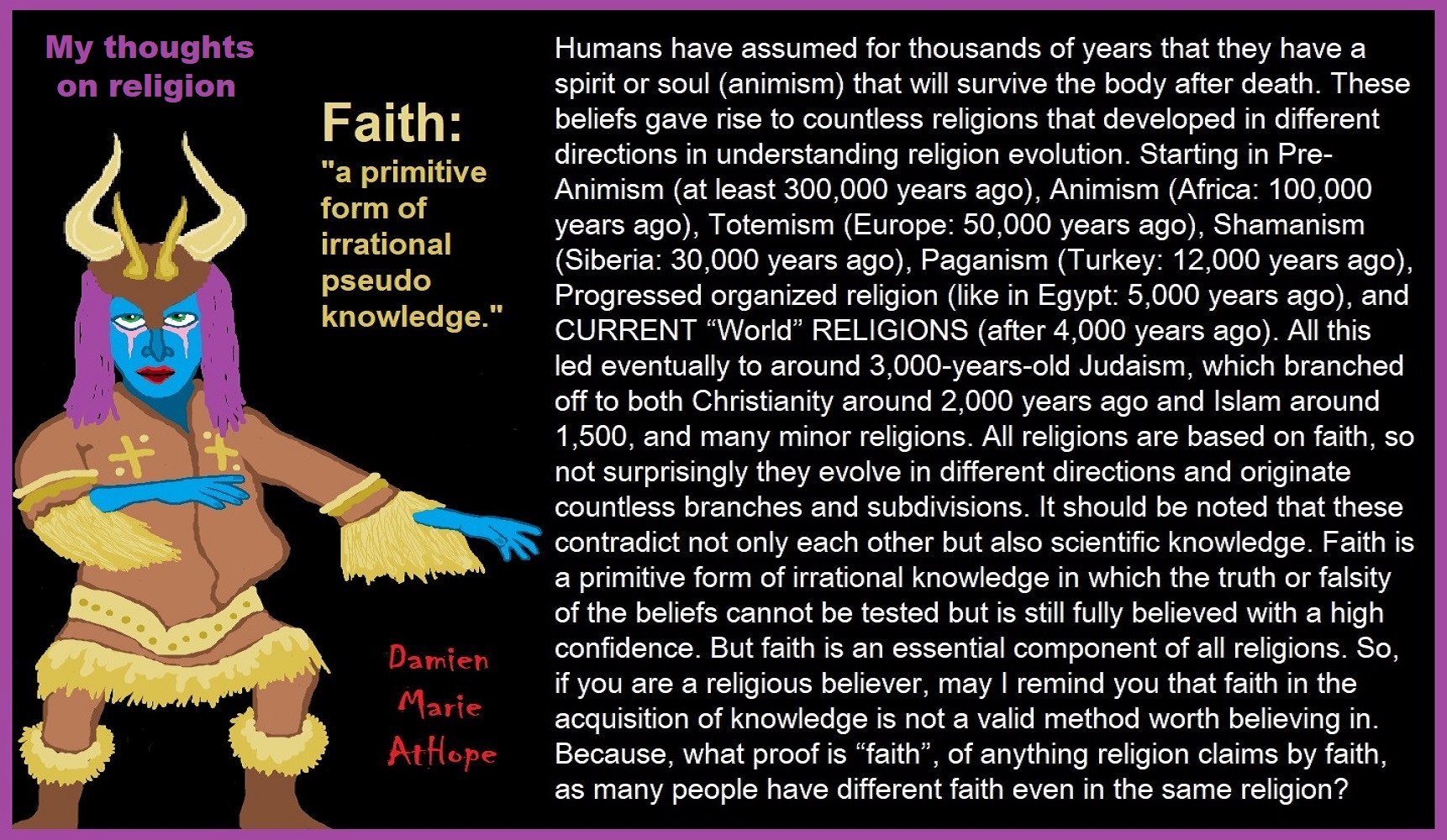
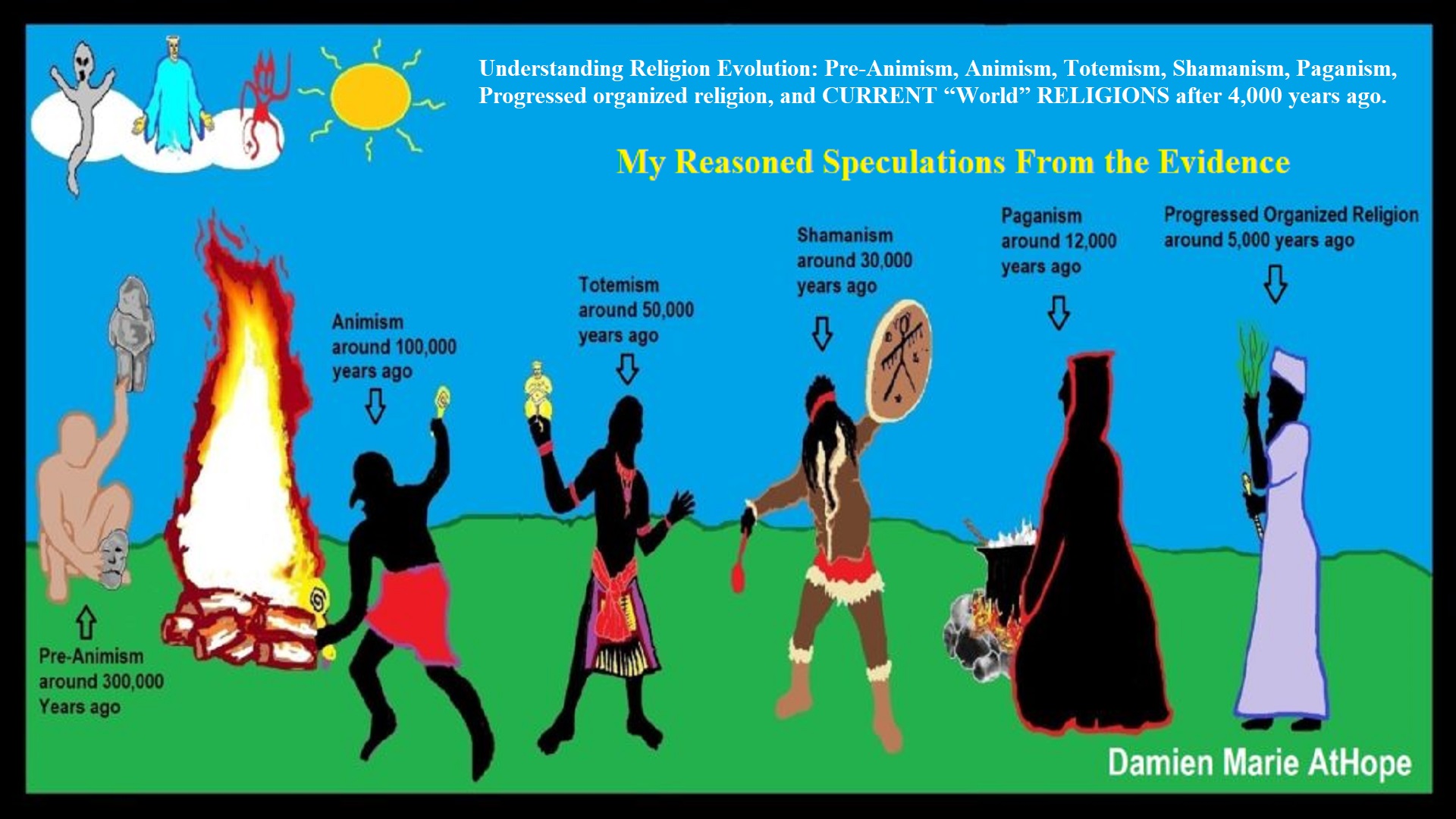
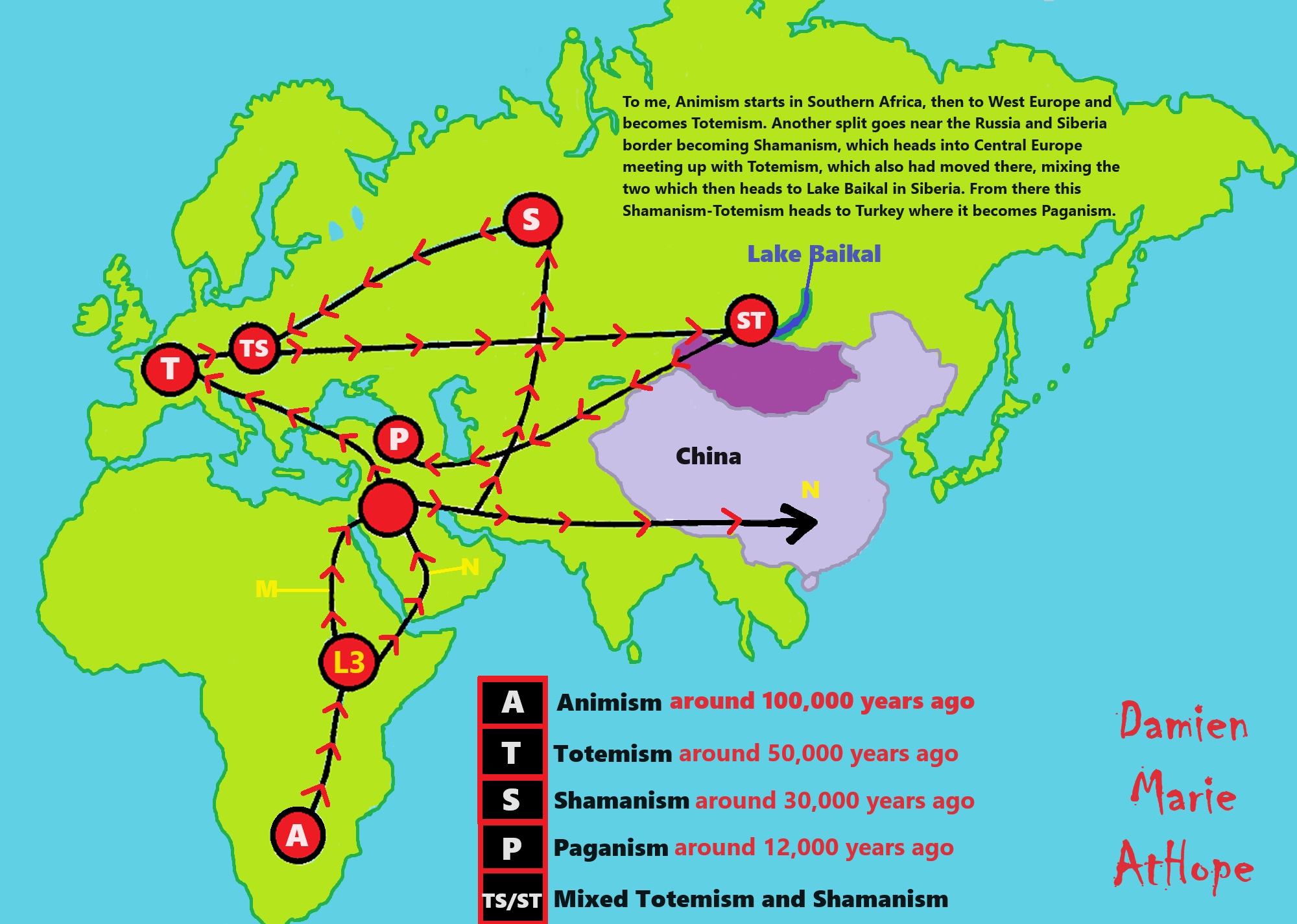
To me, Animism starts in Southern Africa, then to West Europe, and becomes Totemism. Another split goes near the Russia and Siberia border becoming Shamanism, which heads into Central Europe meeting up with Totemism, which also had moved there, mixing the two which then heads to Lake Baikal in Siberia. From there this Shamanism-Totemism heads to Turkey where it becomes Paganism.

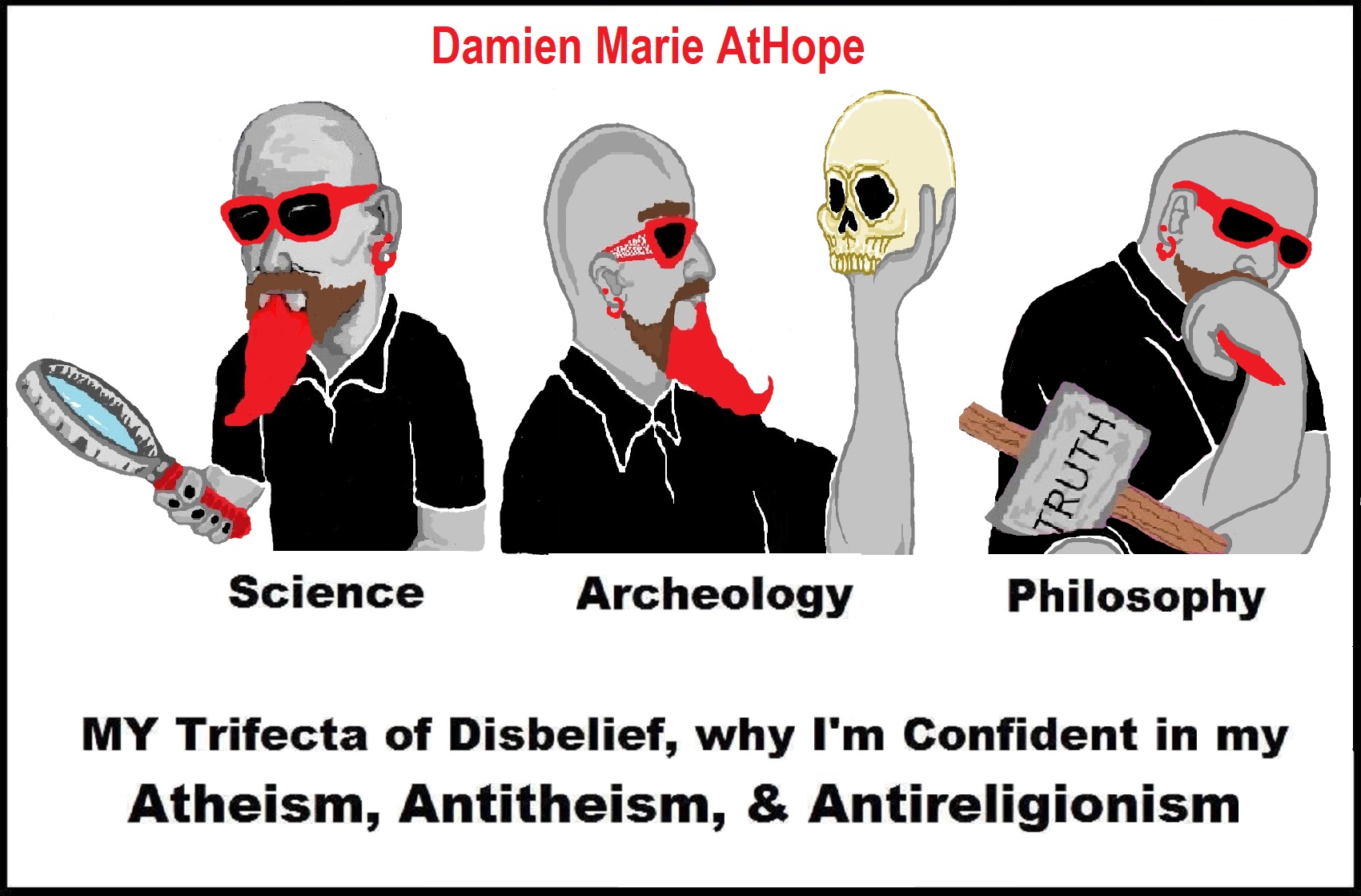
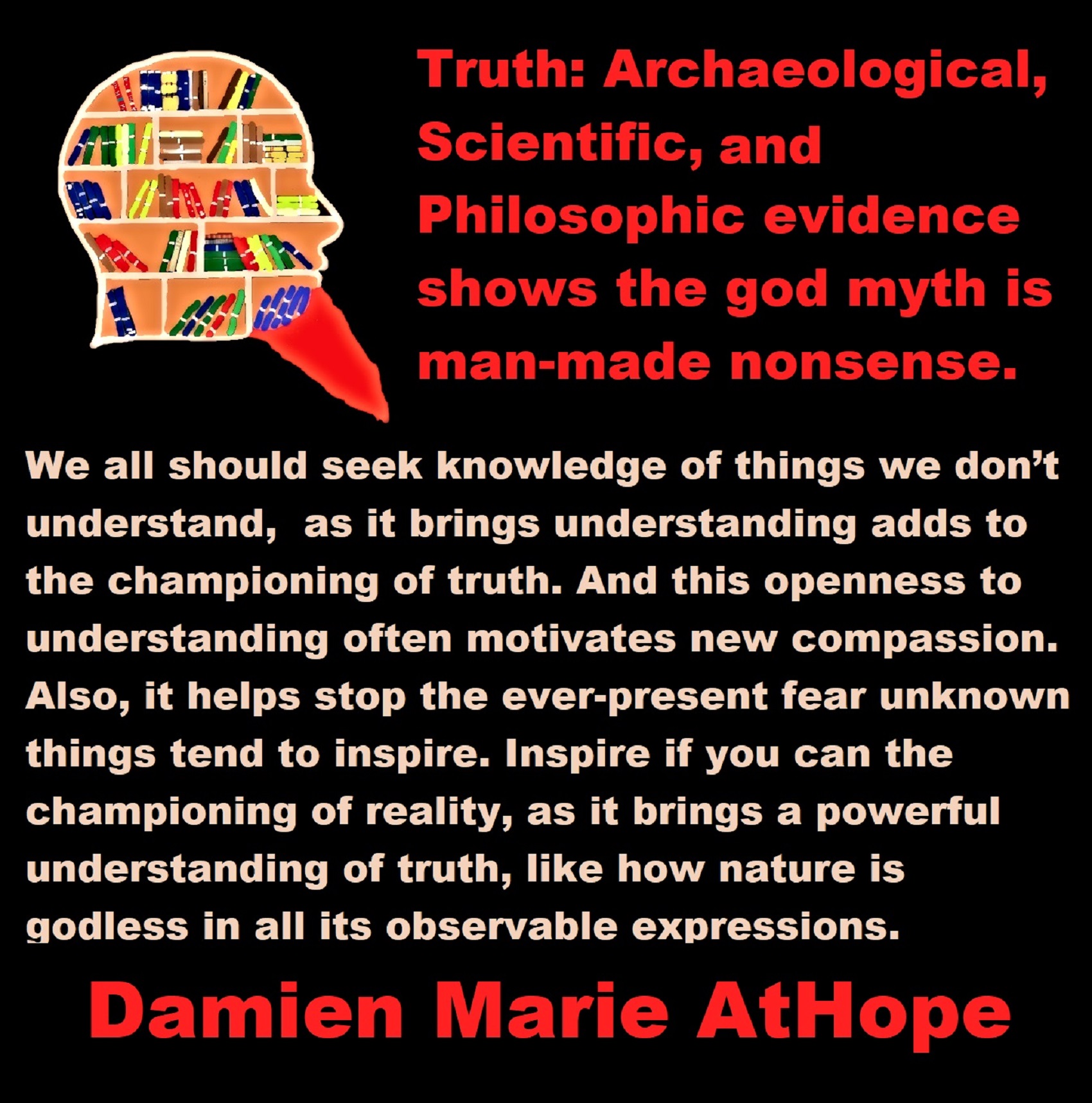


Not all “Religions” or “Religious Persuasions” have a god(s) but
All can be said to believe in some imaginary beings or imaginary things like spirits, afterlives, etc.
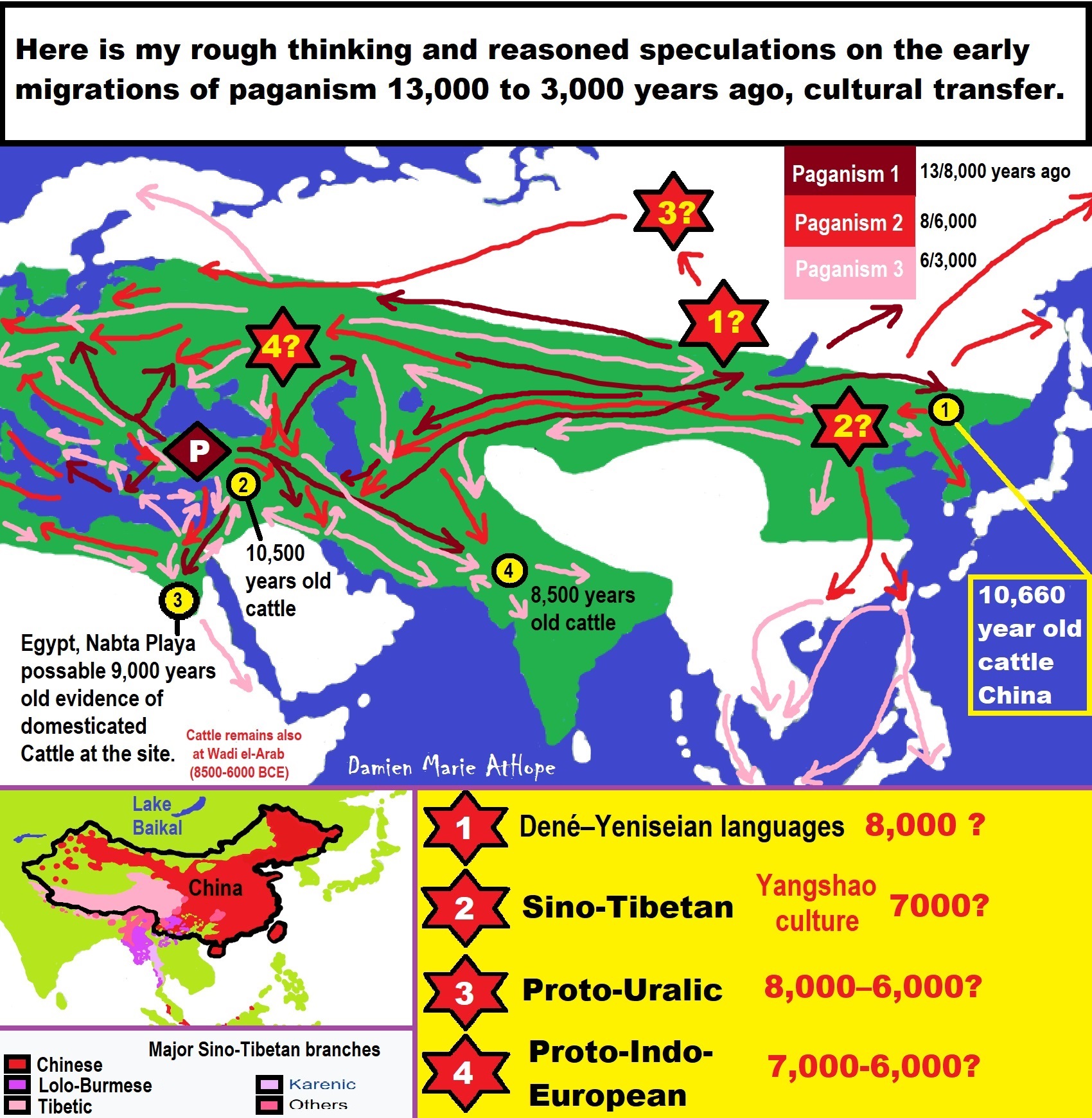
Paganism 12,000-4,000 years old
12,000-7,000 years old: related to (Pre-Capitalism)
7,000-5,000 years old: related to (Capitalism) (World War 0) Elite and their slaves!
5,000 years old: related to (Kings and the Rise of the State)
4,000 years old: related to (First Moralistic gods, then the Origin time of Monotheism)
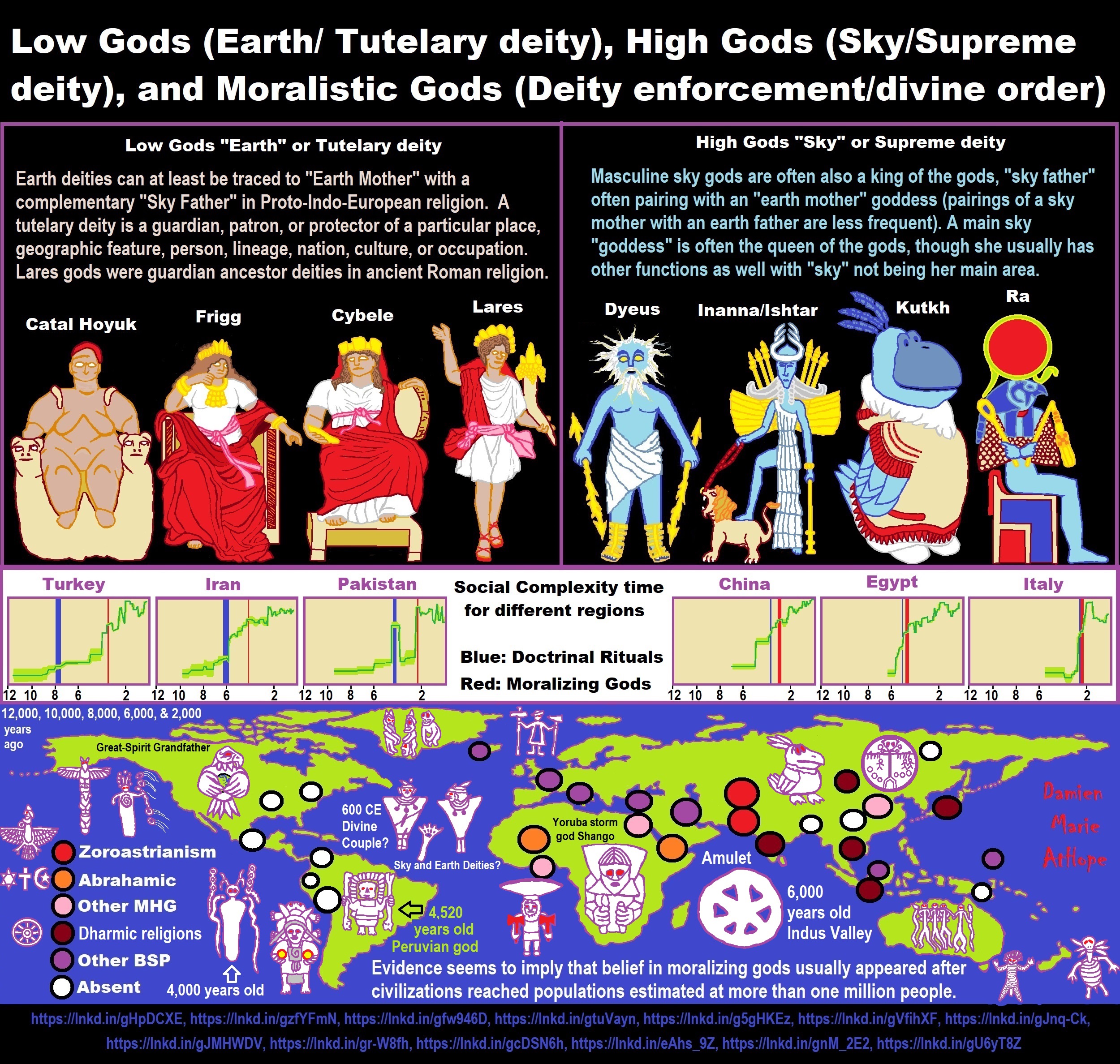
ref, ref, ref, ref, ref, ref, ref, ref, ref, ref, ref, ref, ref, ref, ref, ref, ref, ref, ref, ref, ref
Low Gods “Earth” or Tutelary deity and High Gods “Sky” or Supreme deity
“An Earth goddess is a deification of the Earth. Earth goddesses are often associated with the “chthonic” deities of the underworld. Ki and Ninhursag are Mesopotamian earth goddesses. In Greek mythology, the Earth is personified as Gaia, corresponding to Roman Terra, Indic Prithvi/Bhūmi, etc. traced to an “Earth Mother” complementary to the “Sky Father” in Proto-Indo-European religion. Egyptian mythology exceptionally has a sky goddess and an Earth god.” ref
“A mother goddess is a goddess who represents or is a personification of nature, motherhood, fertility, creation, destruction or who embodies the bounty of the Earth. When equated with the Earth or the natural world, such goddesses are sometimes referred to as Mother Earth or as the Earth Mother. In some religious traditions or movements, Heavenly Mother (also referred to as Mother in Heaven or Sky Mother) is the wife or feminine counterpart of the Sky father or God the Father.” ref
“Any masculine sky god is often also king of the gods, taking the position of patriarch within a pantheon. Such king gods are collectively categorized as “sky father” deities, with a polarity between sky and earth often being expressed by pairing a “sky father” god with an “earth mother” goddess (pairings of a sky mother with an earth father are less frequent). A main sky goddess is often the queen of the gods and may be an air/sky goddess in her own right, though she usually has other functions as well with “sky” not being her main. In antiquity, several sky goddesses in ancient Egypt, Mesopotamia, and the Near East were called Queen of Heaven. Neopagans often apply it with impunity to sky goddesses from other regions who were never associated with the term historically. The sky often has important religious significance. Many religions, both polytheistic and monotheistic, have deities associated with the sky.” ref
“In comparative mythology, sky father is a term for a recurring concept in polytheistic religions of a sky god who is addressed as a “father”, often the father of a pantheon and is often either a reigning or former King of the Gods. The concept of “sky father” may also be taken to include Sun gods with similar characteristics, such as Ra. The concept is complementary to an “earth mother“. “Sky Father” is a direct translation of the Vedic Dyaus Pita, etymologically descended from the same Proto-Indo-European deity name as the Greek Zeûs Pater and Roman Jupiter and Germanic Týr, Tir or Tiwaz, all of which are reflexes of the same Proto-Indo-European deity’s name, *Dyēus Ph₂tḗr. While there are numerous parallels adduced from outside of Indo-European mythology, there are exceptions (e.g. In Egyptian mythology, Nut is the sky mother and Geb is the earth father).” ref
Tutelary deity
“A tutelary (also tutelar) is a deity or spirit who is a guardian, patron, or protector of a particular place, geographic feature, person, lineage, nation, culture, or occupation. The etymology of “tutelary” expresses the concept of safety and thus of guardianship. In late Greek and Roman religion, one type of tutelary deity, the genius, functions as the personal deity or daimon of an individual from birth to death. Another form of personal tutelary spirit is the familiar spirit of European folklore.” ref
“A tutelary (also tutelar) in Korean shamanism, jangseung and sotdae were placed at the edge of villages to frighten off demons. They were also worshiped as deities. Seonangshin is the patron deity of the village in Korean tradition and was believed to embody the Seonangdang. In Philippine animism, Diwata or Lambana are deities or spirits that inhabit sacred places like mountains and mounds and serve as guardians. Such as: Maria Makiling is the deity who guards Mt. Makiling and Maria Cacao and Maria Sinukuan. In Shinto, the spirits, or kami, which give life to human bodies come from nature and return to it after death. Ancestors are therefore themselves tutelaries to be worshiped. And similarly, Native American beliefs such as Tonás, tutelary animal spirit among the Zapotec and Totems, familial or clan spirits among the Ojibwe, can be animals.” ref
“A tutelary (also tutelar) in Austronesian beliefs such as: Atua (gods and spirits of the Polynesian peoples such as the Māori or the Hawaiians), Hanitu (Bunun of Taiwan‘s term for spirit), Hyang (Kawi, Sundanese, Javanese, and Balinese Supreme Being, in ancient Java and Bali mythology and this spiritual entity, can be either divine or ancestral), Kaitiaki (New Zealand Māori term used for the concept of guardianship, for the sky, the sea, and the land), Kawas (mythology) (divided into 6 groups: gods, ancestors, souls of the living, spirits of living things, spirits of lifeless objects, and ghosts), Tiki (Māori mythology, Tiki is the first man created by either Tūmatauenga or Tāne and represents deified ancestors found in most Polynesian cultures). ” ref, ref, ref, ref, ref, ref, ref
Mesopotamian Tutelary Deities can be seen as ones related to City-States
“Historical city-states included Sumerian cities such as Uruk and Ur; Ancient Egyptian city-states, such as Thebes and Memphis; the Phoenician cities (such as Tyre and Sidon); the five Philistine city-states; the Berber city-states of the Garamantes; the city-states of ancient Greece (the poleis such as Athens, Sparta, Thebes, and Corinth); the Roman Republic (which grew from a city-state into a vast empire); the Italian city-states from the Middle Ages to the early modern period, such as Florence, Siena, Ferrara, Milan (which as they grew in power began to dominate neighboring cities) and Genoa and Venice, which became powerful thalassocracies; the Mayan and other cultures of pre-Columbian Mesoamerica (including cities such as Chichen Itza, Tikal, Copán and Monte Albán); the central Asian cities along the Silk Road; the city-states of the Swahili coast; Ragusa; states of the medieval Russian lands such as Novgorod and Pskov; and many others.” ref
“The Uruk period (ca. 4000 to 3100 BCE; also known as Protoliterate period) of Mesopotamia, named after the Sumerian city of Uruk, this period saw the emergence of urban life in Mesopotamia and the Sumerian civilization. City-States like Uruk and others had a patron tutelary City Deity along with a Priest-King.” ref
“Chinese folk religion, both past, and present, includes myriad tutelary deities. Exceptional individuals, highly cultivated sages, and prominent ancestors can be deified and honored after death. Lord Guan is the patron of military personnel and police, while Mazu is the patron of fishermen and sailors. Such as Tu Di Gong (Earth Deity) is the tutelary deity of a locality, and each individual locality has its own Earth Deity and Cheng Huang Gong (City God) is the guardian deity of an individual city, worshipped by local officials and locals since imperial times.” ref
“A tutelary (also tutelar) in Hinduism, personal tutelary deities are known as ishta-devata, while family tutelary deities are known as Kuladevata. Gramadevata are guardian deities of villages. Devas can also be seen as tutelary. Shiva is the patron of yogis and renunciants. City goddesses include: Mumbadevi (Mumbai), Sachchika (Osian); Kuladevis include: Ambika (Porwad), and Mahalakshmi. In NorthEast India Meitei mythology and religion (Sanamahism) of Manipur, there are various types of tutelary deities, among which Lam Lais are the most predominant ones. Tibetan Buddhism has Yidam as a tutelary deity. Dakini is the patron of those who seek knowledge.” ref
“A tutelary (also tutelar) The Greeks also thought deities guarded specific places: for instance, Athena was the patron goddess of the city of Athens. Socrates spoke of hearing the voice of his personal spirit or daimonion:
You have often heard me speak of an oracle or sign which comes to me … . This sign I have had ever since I was a child. The sign is a voice which comes to me and always forbids me to do something which I am going to do, but never commands me to do anything, and this is what stands in the way of my being a politician.” ref
“Tutelary deities who guard and preserve a place or a person are fundamental to ancient Roman religion. The tutelary deity of a man was his Genius, that of a woman her Juno. In the Imperial era, the Genius of the Emperor was a focus of Imperial cult. An emperor might also adopt a major deity as his personal patron or tutelary, as Augustus did Apollo. Precedents for claiming the personal protection of a deity were established in the Republican era, when for instance the Roman dictator Sulla advertised the goddess Victory as his tutelary by holding public games (ludi) in her honor.” ref
“Each town or city had one or more tutelary deities, whose protection was considered particularly vital in time of war and siege. Rome itself was protected by a goddess whose name was to be kept ritually secret on pain of death (for a supposed case, see Quintus Valerius Soranus). The Capitoline Triad of Juno, Jupiter, and Minerva were also tutelaries of Rome. The Italic towns had their own tutelary deities. Juno often had this function, as at the Latin town of Lanuvium and the Etruscan city of Veii, and was often housed in an especially grand temple on the arx (citadel) or other prominent or central location. The tutelary deity of Praeneste was Fortuna, whose oracle was renowned.” ref
“The Roman ritual of evocatio was premised on the belief that a town could be made vulnerable to military defeat if the power of its tutelary deity were diverted outside the city, perhaps by the offer of superior cult at Rome. The depiction of some goddesses such as the Magna Mater (Great Mother, or Cybele) as “tower-crowned” represents their capacity to preserve the city. A town in the provinces might adopt a deity from within the Roman religious sphere to serve as its guardian, or syncretize its own tutelary with such; for instance, a community within the civitas of the Remi in Gaul adopted Apollo as its tutelary, and at the capital of the Remi (present-day Rheims), the tutelary was Mars Camulus.” ref
Household deity (a kind of or related to a Tutelary deity)
“A household deity is a deity or spirit that protects the home, looking after the entire household or certain key members. It has been a common belief in paganism as well as in folklore across many parts of the world. Household deities fit into two types; firstly, a specific deity – typically a goddess – often referred to as a hearth goddess or domestic goddess who is associated with the home and hearth, such as the ancient Greek Hestia.” ref
“The second type of household deities are those that are not one singular deity, but a type, or species of animistic deity, who usually have lesser powers than major deities. This type was common in the religions of antiquity, such as the Lares of ancient Roman religion, the Gashin of Korean shamanism, and Cofgodas of Anglo-Saxon paganism. These survived Christianisation as fairy-like creatures existing in folklore, such as the Anglo-Scottish Brownie and Slavic Domovoy.” ref
“Household deities were usually worshipped not in temples but in the home, where they would be represented by small idols (such as the teraphim of the Bible, often translated as “household gods” in Genesis 31:19 for example), amulets, paintings, or reliefs. They could also be found on domestic objects, such as cosmetic articles in the case of Tawaret. The more prosperous houses might have a small shrine to the household god(s); the lararium served this purpose in the case of the Romans. The gods would be treated as members of the family and invited to join in meals, or be given offerings of food and drink.” ref
“In many religions, both ancient and modern, a god would preside over the home. Certain species, or types, of household deities, existed. An example of this was the Roman Lares. Many European cultures retained house spirits into the modern period. Some examples of these include:
- Brownie (Scotland and England) or Hob (England) / Kobold (Germany) / Goblin / Hobgoblin
- Domovoy (Slavic)
- Nisse (Norwegian or Danish) / Tomte (Swedish) / Tonttu (Finnish)
- Húsvættir (Norse)” ref
“Although the cosmic status of household deities was not as lofty as that of the Twelve Olympians or the Aesir, they were also jealous of their dignity and also had to be appeased with shrines and offerings, however humble. Because of their immediacy they had arguably more influence on the day-to-day affairs of men than the remote gods did. Vestiges of their worship persisted long after Christianity and other major religions extirpated nearly every trace of the major pagan pantheons. Elements of the practice can be seen even today, with Christian accretions, where statues to various saints (such as St. Francis) protect gardens and grottos. Even the gargoyles found on older churches, could be viewed as guardians partitioning a sacred space.” ref
“For centuries, Christianity fought a mop-up war against these lingering minor pagan deities, but they proved tenacious. For example, Martin Luther‘s Tischreden have numerous – quite serious – references to dealing with kobolds. Eventually, rationalism and the Industrial Revolution threatened to erase most of these minor deities, until the advent of romantic nationalism rehabilitated them and embellished them into objects of literary curiosity in the 19th century. Since the 20th century this literature has been mined for characters for role-playing games, video games, and other fantasy personae, not infrequently invested with invented traits and hierarchies somewhat different from their mythological and folkloric roots.” ref
“In contradistinction to both Herbert Spencer and Edward Burnett Tylor, who defended theories of animistic origins of ancestor worship, Émile Durkheim saw its origin in totemism. In reality, this distinction is somewhat academic, since totemism may be regarded as a particularized manifestation of animism, and something of a synthesis of the two positions was attempted by Sigmund Freud. In Freud’s Totem and Taboo, both totem and taboo are outward expressions or manifestations of the same psychological tendency, a concept which is complementary to, or which rather reconciles, the apparent conflict. Freud preferred to emphasize the psychoanalytic implications of the reification of metaphysical forces, but with particular emphasis on its familial nature. This emphasis underscores, rather than weakens, the ancestral component.” ref
“William Edward Hearn, a noted classicist, and jurist, traced the origin of domestic deities from the earliest stages as an expression of animism, a belief system thought to have existed also in the neolithic, and the forerunner of Indo-European religion. In his analysis of the Indo-European household, in Chapter II “The House Spirit”, Section 1, he states:
The belief which guided the conduct of our forefathers was … the spirit rule of dead ancestors.” ref
“In Section 2 he proceeds to elaborate:
It is thus certain that the worship of deceased ancestors is a vera causa, and not a mere hypothesis. …
In the other European nations, the Slavs, the Teutons, and the Kelts, the House Spirit appears with no less distinctness. … [T]he existence of that worship does not admit of doubt. … The House Spirits had a multitude of other names which it is needless here to enumerate, but all of which are more or less expressive of their friendly relations with man. … In [England] … [h]e is the Brownie. … In Scotland this same Brownie is well known. He is usually described as attached to particular families, with whom he has been known to reside for centuries, threshing the corn, cleaning the house, and performing similar household tasks. His favorite gratification was milk and honey.” ref

ref, ref, ref, ref, ref, ref, ref, ref, ref, ref, ref, ref, ref, ref, ref, ref, ref
“These ideas are my speculations from the evidence.”
I am still researching the “god‘s origins” all over the world. So you know, it is very complicated but I am smart and willing to look, DEEP, if necessary, which going very deep does seem to be needed here, when trying to actually understand the evolution of gods and goddesses. I am sure of a few things and less sure of others, but even in stuff I am not fully grasping I still am slowly figuring it out, to explain it to others. But as I research more I am understanding things a little better, though I am still working on understanding it all or something close and thus always figuring out more.
Sky Father/Sky God?
“Egyptian: (Nut) Sky Mother and (Geb) Earth Father” (Egypt is different but similar)
Turkic/Mongolic: (Tengri/Tenger Etseg) Sky Father and (Eje/Gazar Eej) Earth Mother *Transeurasian*
Hawaiian: (Wākea) Sky Father and (Papahānaumoku) Earth Mother *Austronesian*
New Zealand/ Māori: (Ranginui) Sky Father and (Papatūānuku) Earth Mother *Austronesian*
Proto-Indo-European: (Dyḗus/Dyḗus ph₂tḗr) Sky Father and (Dʰéǵʰōm/Pleth₂wih₁) Earth Mother
Indo-Aryan: (Dyaus Pita) Sky Father and (Prithvi Mata) Earth Mother *Indo-European*
Italic: (Jupiter) Sky Father and (Juno) Sky Mother *Indo-European*
Etruscan: (Tinia) Sky Father and (Uni) Sky Mother *Tyrsenian/Italy Pre–Indo-European*
Hellenic/Greek: (Zeus) Sky Father and (Hera) Sky Mother who started as an “Earth Goddess” *Indo-European*
Nordic: (Dagr) Sky Father and (Nótt) Sky Mother *Indo-European*
Slavic: (Perun) Sky Father and (Mokosh) Earth Mother *Indo-European*
Illyrian: (Deipaturos) Sky Father and (Messapic Damatura’s “earth-mother” maybe) Earth Mother *Indo-European*
Albanian: (Zojz) Sky Father and (?) *Indo-European*
Baltic: (Perkūnas) Sky Father and (Saulė) Sky Mother *Indo-European*
Germanic: (Týr) Sky Father and (?) *Indo-European*
Colombian-Muisca: (Bochica) Sky Father and (Huythaca) Sky Mother *Chibchan*
Aztec: (Quetzalcoatl) Sky Father and (Xochiquetzal) Sky Mother *Uto-Aztecan*
Incan: (Viracocha) Sky Father and (Mama Runtucaya) Sky Mother *Quechuan*
China: (Tian/Shangdi) Sky Father and (Dì) Earth Mother *Sino-Tibetan*
Sumerian, Assyrian and Babylonian: (An/Anu) Sky Father and (Ki) Earth Mother
Finnish: (Ukko) Sky Father and (Akka) Earth Mother *Finno-Ugric*
Sami: (Horagalles) Sky Father and (Ravdna) Earth Mother *Finno-Ugric*
Puebloan-Zuni: (Ápoyan Ta’chu) Sky Father and (Áwitelin Tsíta) Earth Mother
Puebloan-Hopi: (Tawa) Sky Father and (Kokyangwuti/Spider Woman/Grandmother) Earth Mother *Uto-Aztecan*
Puebloan-Navajo: (Tsohanoai) Sky Father and (Estsanatlehi) Earth Mother *Na-Dene*
ref, ref, ref, ref, ref, ref, ref, ref, ref, ref, ref, ref, ref, ref, ref, ref, ref, ref, ref, ref, ref, ref, ref, ref, ref, ref, ref
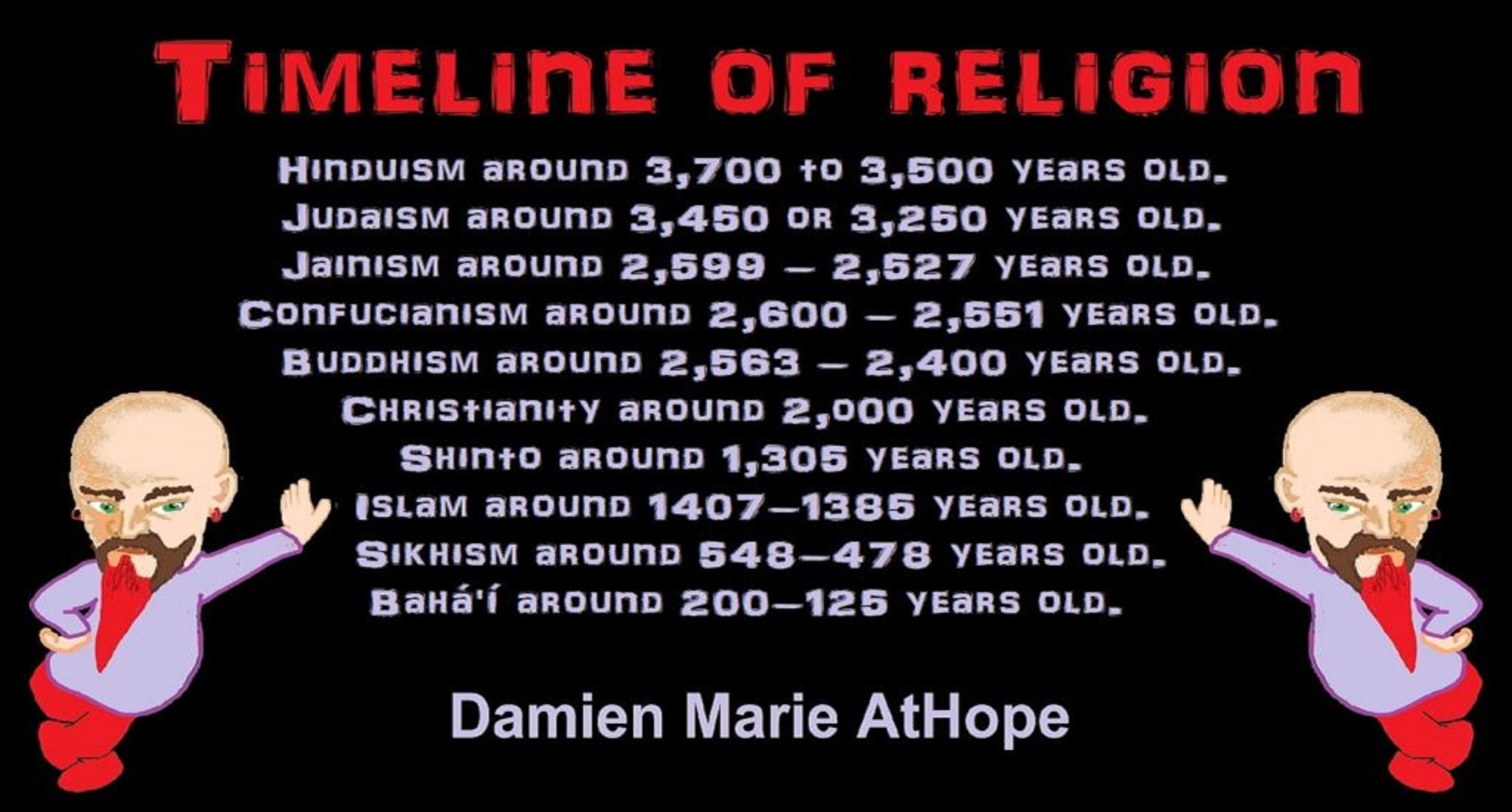
Hinduism around 3,700 to 3,500 years old. ref
Judaism around 3,450 or 3,250 years old. (The first writing in the bible was “Paleo-Hebrew” dated to around 3,000 years ago Khirbet Qeiyafa is the site of an ancient fortress city overlooking the Elah Valley. And many believe the religious Jewish texts were completed around 2,500) ref, ref
Judaism is around 3,450 or 3,250 years old. (“Paleo-Hebrew” 3,000 years ago and Torah 2,500 years ago)
“Judaism is an Abrahamic, its roots as an organized religion in the Middle East during the Bronze Age. Some scholars argue that modern Judaism evolved from Yahwism, the religion of ancient Israel and Judah, by the late 6th century BCE, and is thus considered to be one of the oldest monotheistic religions.” ref
“Yahwism is the name given by modern scholars to the religion of ancient Israel, essentially polytheistic, with a plethora of gods and goddesses. Heading the pantheon was Yahweh, the national god of the Israelite kingdoms of Israel and Judah, with his consort, the goddess Asherah; below them were second-tier gods and goddesses such as Baal, Shamash, Yarikh, Mot, and Astarte, all of whom had their own priests and prophets and numbered royalty among their devotees, and a third and fourth tier of minor divine beings, including the mal’ak, the messengers of the higher gods, who in later times became the angels of Judaism, Christianity and Islam. Yahweh, however, was not the ‘original’ god of Israel “Isra-El”; it is El, the head of the Canaanite pantheon, whose name forms the basis of the name “Israel”, and none of the Old Testament patriarchs, the tribes of Israel, the Judges, or the earliest monarchs, have a Yahwistic theophoric name (i.e., one incorporating the name of Yahweh).” ref
“El is a Northwest Semitic word meaning “god” or “deity“, or referring (as a proper name) to any one of multiple major ancient Near Eastern deities. A rarer form, ‘ila, represents the predicate form in Old Akkadian and in Amorite. The word is derived from the Proto-Semitic *ʔil-, meaning “god”. Specific deities known as ‘El or ‘Il include the supreme god of the ancient Canaanite religion and the supreme god of East Semitic speakers in Mesopotamia’s Early Dynastic Period. ʼĒl is listed at the head of many pantheons. In some Canaanite and Ugaritic sources, ʼĒl played a role as father of the gods, of creation, or both. For example, in the Ugaritic texts, ʾil mlk is understood to mean “ʼĒl the King” but ʾil hd as “the god Hadad“. The Semitic root ʾlh (Arabic ʾilāh, Aramaic ʾAlāh, ʾElāh, Hebrew ʾelōah) may be ʾl with a parasitic h, and ʾl may be an abbreviated form of ʾlh. In Ugaritic the plural form meaning “gods” is ʾilhm, equivalent to Hebrew ʾelōhîm “powers”. In the Hebrew texts this word is interpreted as being semantically singular for “god” by biblical commentators. However the documentary hypothesis for the Old Testament (corresponds to the Jewish Torah) developed originally in the 1870s, identifies these that different authors – the Jahwist, Elohist, Deuteronomist, and the Priestly source – were responsible for editing stories from a polytheistic religion into those of a monotheistic religion. Inconsistencies that arise between monotheism and polytheism in the texts are reflective of this hypothesis.” ref
Jainism around 2,599 – 2,527 years old. ref
Confucianism around 2,600 – 2,551 years old. ref
Buddhism around 2,563/2,480 – 2,483/2,400 years old. ref
Christianity around 2,o00 years old. ref
Shinto around 1,305 years old. ref
Islam around 1407–1385 years old. ref

Knowledge to Ponder:
Stars/Astrology:
- Possibly, around 30,000 years ago (in simpler form) to 6,000 years ago, Stars/Astrology are connected to Ancestors, Spirit Animals, and Deities.
- The star also seems to be a possible proto-star for Star of Ishtar, Star of Inanna, or Star of Venus.
- Around 7,000 to 6,000 years ago, Star Constellations/Astrology have connections to the “Kurgan phenomenon” of below-ground “mound” stone/wood burial structures and “Dolmen phenomenon” of above-ground stone burial structures.
- Around 6,500–5,800 years ago, The Northern Levant migrations into Jordon and Israel in the Southern Levant brought new cultural and religious transfer from Turkey and Iran.
- “The Ghassulian Star,” a mysterious 6,000-year-old mural from Jordan may have connections to the European paganstic kurgan/dolmens phenomenon.
“Astrology is a range of divinatory practices, recognized as pseudoscientific since the 18th century, that claim to discern information about human affairs and terrestrial events by studying the apparent positions of celestial objects. Different cultures have employed forms of astrology since at least the 2nd millennium BCE, these practices having originated in calendrical systems used to predict seasonal shifts and to interpret celestial cycles as signs of divine communications. Most, if not all, cultures have attached importance to what they observed in the sky, and some—such as the Hindus, Chinese, and the Maya—developed elaborate systems for predicting terrestrial events from celestial observations. Western astrology, one of the oldest astrological systems still in use, can trace its roots to 19th–17th century BCE Mesopotamia, from where it spread to Ancient Greece, Rome, the Islamicate world and eventually Central and Western Europe. Contemporary Western astrology is often associated with systems of horoscopes that purport to explain aspects of a person’s personality and predict significant events in their lives based on the positions of celestial objects; the majority of professional astrologers rely on such systems.” ref
Around 5,500 years ago, Science evolves, The first evidence of science was 5,500 years ago and was demonstrated by a body of empirical, theoretical, and practical knowledge about the natural world. ref
Around 5,000 years ago, Origin of Logics is a Naturalistic Observation (principles of valid reasoning, inference, & demonstration) ref
Around 4,150 to 4,000 years ago: The earliest surviving versions of the Sumerian Epic of Gilgamesh, which was originally titled “He who Saw the Deep” (Sha naqba īmuru) or “Surpassing All Other Kings” (Shūtur eli sharrī) were written. ref
Hinduism:
- 3,700 years ago or so, the oldest of the Hindu Vedas (scriptures), the Rig Veda was composed.
- 3,500 years ago or so, the Vedic Age began in India after the collapse of the Indus Valley Civilization.
Judaism:
- around 3,000 years ago, the first writing in the bible was “Paleo-Hebrew”
- around 2,500 years ago, many believe the religious Jewish texts were completed
Myths: The bible inspired religion is not just one religion or one myth but a grouping of several religions and myths
- Around 3,450 or 3,250 years ago, according to legend, is the traditionally accepted period in which the Israelite lawgiver, Moses, provided the Ten Commandments.
- Around 2,500 to 2,400 years ago, a collection of ancient religious writings by the Israelites based primarily upon the Hebrew Bible, Tanakh, or Old Testament is the first part of Christianity’s bible.
- Around 2,400 years ago, the most accepted hypothesis is that the canon was formed in stages, first the Pentateuch (Torah).
- Around 2,140 to 2,116 years ago, the Prophets was written during the Hasmonean dynasty, and finally the remaining books.
- Christians traditionally divide the Old Testament into four sections:
- The first five books or Pentateuch (Torah).
- The proposed history books telling the history of the Israelites from their conquest of Canaan to their defeat and exile in Babylon.
- The poetic and proposed “Wisdom books” dealing, in various forms, with questions of good and evil in the world.
- The books of the biblical prophets, warning of the consequences of turning away from God:
- Henotheism:
- Exodus 20:23 “You shall not make other gods besides Me (not saying there are no other gods just not to worship them); gods of silver or gods of gold, you shall not make for yourselves.”
- Polytheism:
- Judges 10:6 “Then the sons of Israel again did evil in the sight of the LORD, served the Baals and the Ashtaroth, the gods of Aram, the gods of Sidon, the gods of Moab, the gods of the sons of Ammon, and the gods of the Philistines; thus they forsook the LORD and did not serve Him.”
- 1 Corinthians 8:5 “For even if there are so-called gods whether in heaven or on earth, as indeed there are many gods and many lords.”
- Monotheism:
- Isaiah 43:10 “You are my witnesses,” declares the LORD, “and my servant whom I have chosen, so that you may know and believe me and understand that I am he. Before me no god was formed, nor will there be one after me.
Around 2,570 to 2,270 Years Ago, there is a confirmation of atheistic doubting as well as atheistic thinking, mainly by Greek philosophers. However, doubting gods is likely as old as the invention of gods and should destroy the thinking that belief in god(s) is the “default belief”. The Greek word is apistos (a “not” and pistos “faithful,”), thus not faithful or faithless because one is unpersuaded and unconvinced by a god(s) claim. Short Definition: unbelieving, unbeliever, or unbelief.

Expressions of Atheistic Thinking:
- Around 2,600 years ago, Ajita Kesakambali, ancient Indian philosopher, who is the first known proponent of Indian materialism. ref
- Around 2,535 to 2,475 years ago, Heraclitus, Greek pre-Socratic philosopher, a native of the Greek city Ephesus, Ionia, on the coast of Anatolia, also known as Asia Minor or modern Turkey. ref
- Around 2,500 to 2,400 years ago, according to The Story of Civilization book series certain African pygmy tribes have no identifiable gods, spirits, or religious beliefs or rituals, and even what burials accrue are without ceremony. ref
- Around 2,490 to 2,430 years ago, Empedocles, Greek pre-Socratic philosopher and a citizen of Agrigentum, a Greek city in Sicily. ref
- Around 2,460 to 2,370 years ago, Democritus, Greek pre-Socratic philosopher considered to be the “father of modern science” possibly had some disbelief amounting to atheism. ref
- Around 2,399 years ago or so, Socrates, a famous Greek philosopher was tried for sinfulness by teaching doubt of state gods. ref
- Around 2,341 to 2,270 years ago, Epicurus, a Greek philosopher known for composing atheistic critics and famously stated, “Is God willing to prevent evil, but not able? Then he is not omnipotent. Is he able, but not willing? Then he is malevolent. Is he both able and willing? Then whence cometh evil? Is he neither able nor willing? Then why call him god?” ref
This last expression by Epicurus, seems to be an expression of Axiological Atheism. To understand and utilize value or actually possess “Value Conscious/Consciousness” to both give a strong moral “axiological” argument (the problem of evil) as well as use it to fortify humanism and positive ethical persuasion of human helping and care responsibilities. Because value-blindness gives rise to sociopathic/psychopathic evil.
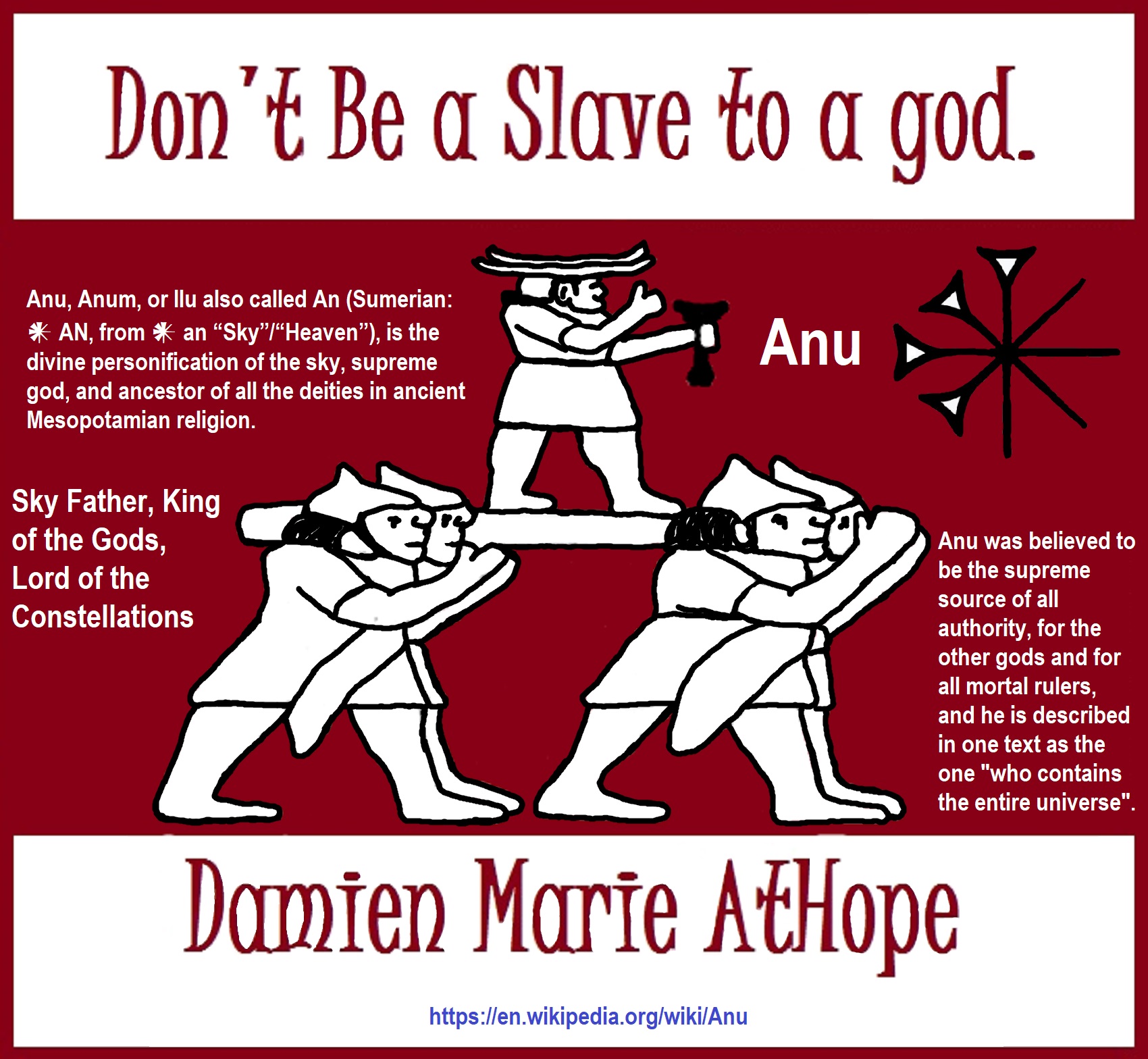
“Theists, there has to be a god, as something can not come from nothing.”
Well, thus something (unknown) happened and then there was something. This does not tell us what the something that may have been involved with something coming from nothing. A supposed first cause, thus something (unknown) happened and then there was something is not an open invitation to claim it as known, neither is it justified to call or label such an unknown as anything, especially an unsubstantiated magical thinking belief born of mythology and religious storytelling.
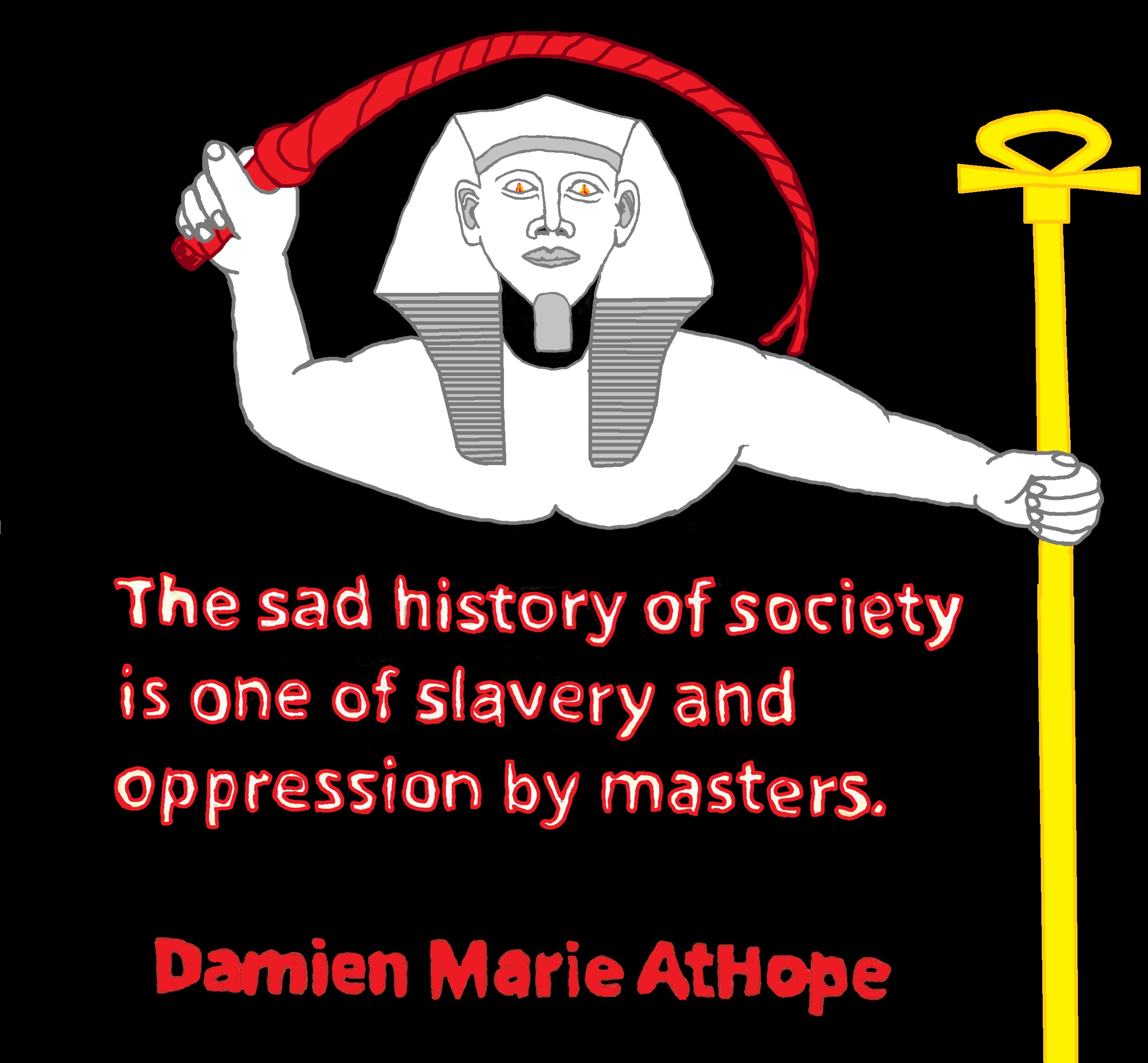
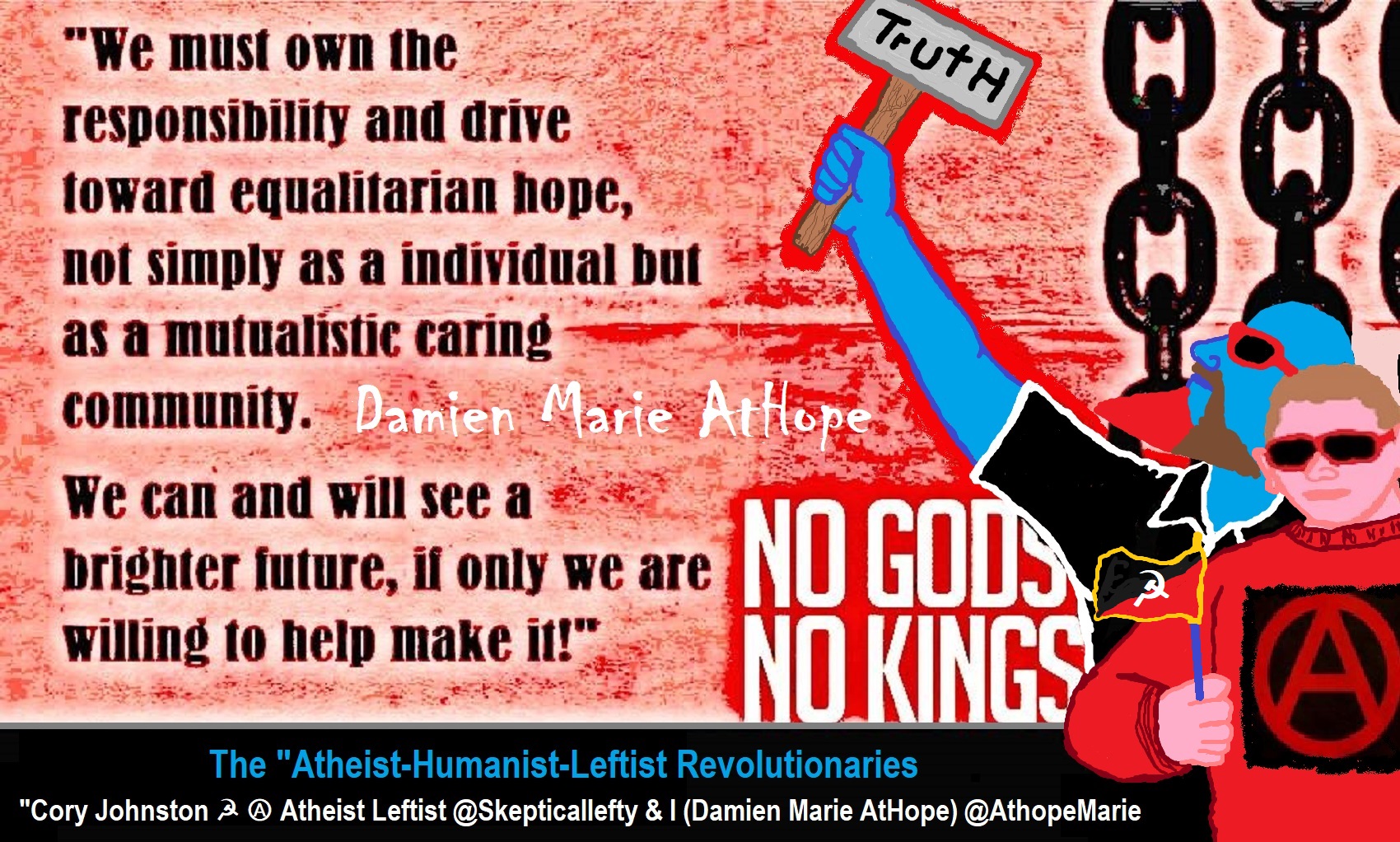
While hallucinogens are associated with shamanism, it is alcohol that is associated with paganism.
The Atheist-Humanist-Leftist Revolutionaries Shows in the prehistory series:
Show two: Pre-animism 300,000 years old and animism 100,000 years old: related to “Anarchism and Socialism”
Show tree: Totemism 50,000 years old: related to “Anarchism and Socialism”
Show four: Shamanism 30,000 years old: related to “Anarchism and Socialism”
Show five: Paganism 12,000 years old: related to “Anarchism and Socialism”
Show six: Emergence of hierarchy, sexism, slavery, and the new male god dominance: Paganism 7,000-5,000 years old: related to “Anarchism and Socialism” (Capitalism) (World War 0) Elite and their slaves!
Prehistory: related to “Anarchism and Socialism” the division of labor, power, rights, and recourses: VIDEO
Pre-animism 300,000 years old and animism 100,000 years old: related to “Anarchism and Socialism”: VIDEO
Totemism 50,000 years old: related to “Anarchism and Socialism”: VIDEO
Shamanism 30,000 years old: related to “Anarchism and Socialism”: VIDEO
Paganism 12,000 years old: related to “Anarchism and Socialism” (Pre-Capitalism): VIDEO
Paganism 7,000-5,000 years old: related to “Anarchism and Socialism” (Capitalism) (World War 0) Elite and their slaves: VIEDO
Paganism 5,000 years old: progressed organized religion and the state: related to “Anarchism and Socialism” (Kings and the Rise of the State): VIEDO
Paganism 4,000 years old: related to “Anarchism and Socialism” (First Moralistic gods, then the Origin time of Monotheism): VIEDO
I do not hate simply because I challenge and expose myths or lies any more than others being thought of as loving simply because of the protection and hiding from challenge their favored myths or lies.
The truth is best championed in the sunlight of challenge.
An archaeologist once said to me “Damien religion and culture are very different”
My response, So are you saying that was always that way, such as would you say Native Americans’ cultures are separate from their religions? And do you think it always was the way you believe?
I had said that religion was a cultural product. That is still how I see it and there are other archaeologists that think close to me as well. Gods too are the myths of cultures that did not understand science or the world around them, seeing magic/supernatural everywhere.
I personally think there is a goddess and not enough evidence to support a male god at Çatalhöyük but if there was both a male and female god and goddess then I know the kind of gods they were like Proto-Indo-European mythology.
This series idea was addressed in, Anarchist Teaching as Free Public Education or Free Education in the Public: VIDEO
Our 12 video series: Organized Oppression: Mesopotamian State Force and the Politics of power (9,000-4,000 years ago), is adapted from: The Complete and Concise History of the Sumerians and Early Bronze Age Mesopotamia (7000-2000 BC): https://www.youtube.com/watch?v=szFjxmY7jQA by “History with Cy“
Show #1: Mesopotamian State Force and the Politics of Power (Samarra, Halaf, Ubaid)
Show #2: Mesopotamian State Force and the Politics of Power
Show #3: Mesopotamian State Force and the Politics of Power (Uruk and the First Cities)
Show #4: Mesopotamian State Force and the Politics of Power (First Kings)
Show #5: Mesopotamian State Force and the Politics of Power (Early Dynastic Period)
Show #6: Mesopotamian State Force and the Politics of Power
Show #7: Mesopotamian State Force and the Politics of Power (Sargon and Akkadian Rule)
Show #9: Mesopotamian State Force and the Politics of Power (Gudea of Lagash and Utu-hegal)
Show #12: Mesopotamian State Force and the Politics of Power (Aftermath and Legacy of Sumer)
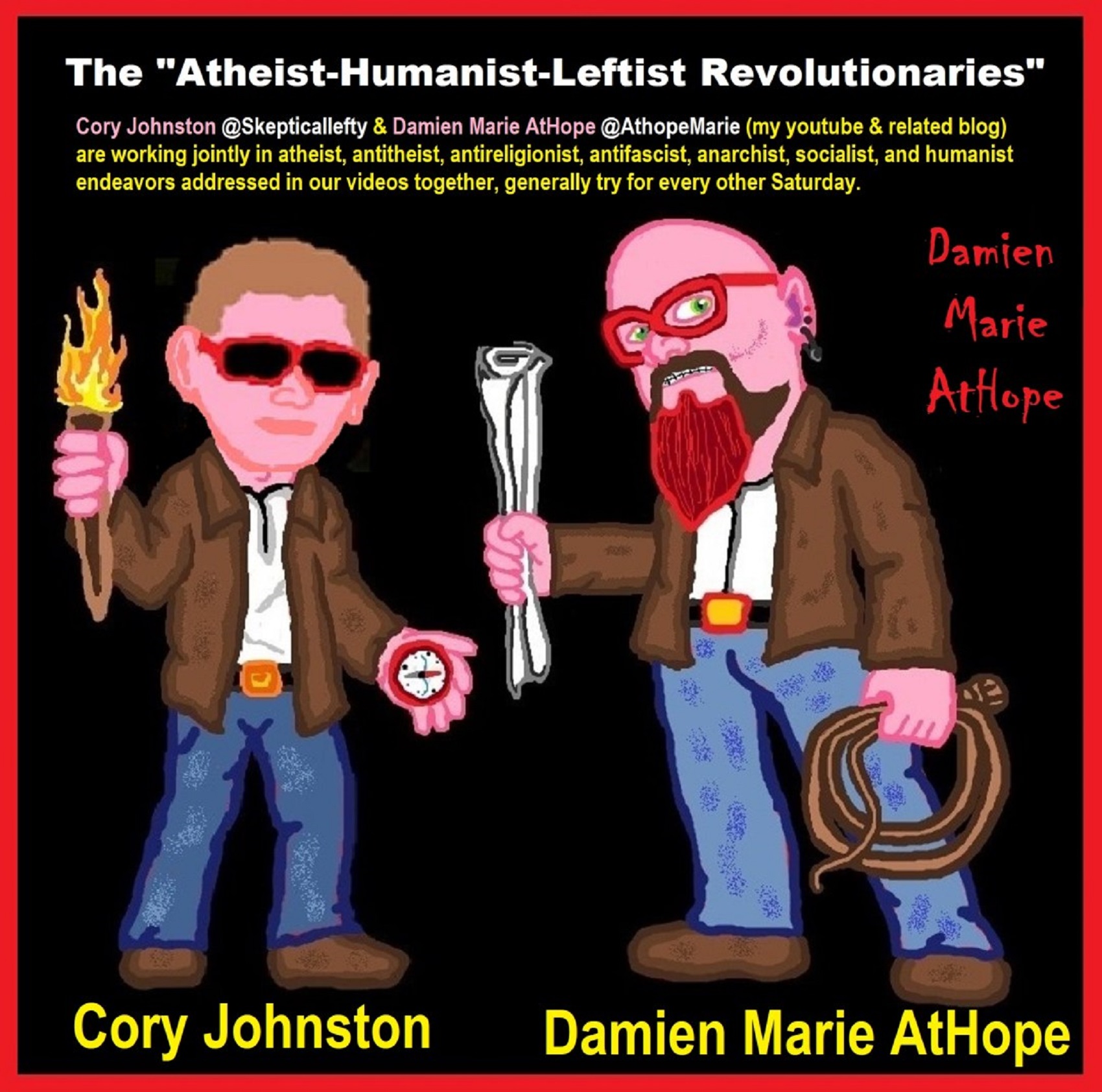
The “Atheist-Humanist-Leftist Revolutionaries”
Cory Johnston ☭ Ⓐ Atheist Leftist @Skepticallefty & I (Damien Marie AtHope) @AthopeMarie (my YouTube & related blog) are working jointly in atheist, antitheist, antireligionist, antifascist, anarchist, socialist, and humanist endeavors in our videos together, generally, every other Saturday.
Why Does Power Bring Responsibility?
Think, how often is it the powerless that start wars, oppress others, or commit genocide? So, I guess the question is to us all, to ask, how can power not carry responsibility in a humanity concept? I know I see the deep ethical responsibility that if there is power their must be a humanistic responsibility of ethical and empathic stewardship of that power. Will I be brave enough to be kind? Will I possess enough courage to be compassionate? Will my valor reach its height of empathy? I as everyone, earns our justified respect by our actions, that are good, ethical, just, protecting, and kind. Do I have enough self-respect to put my love for humanity’s flushing, over being brought down by some of its bad actors? May we all be the ones doing good actions in the world, to help human flourishing.
I create the world I want to live in, striving for flourishing. Which is not a place but a positive potential involvement and promotion; a life of humanist goal precision. To master oneself, also means mastering positive prosocial behaviors needed for human flourishing. I may have lost a god myth as an atheist, but I am happy to tell you, my friend, it is exactly because of that, leaving the mental terrorizer, god belief, that I truly regained my connected ethical as well as kind humanity.
Cory and I will talk about prehistory and theism, addressing the relevance to atheism, anarchism, and socialism.
At the same time as the rise of the male god, 7,000 years ago, there was also the very time there was the rise of violence, war, and clans to kingdoms, then empires, then states. It is all connected back to 7,000 years ago, and it moved across the world.
Cory Johnston: https://damienmarieathope.com/2021/04/cory-johnston-mind-of-a-skeptical-leftist/?v=32aec8db952d
The Mind of a Skeptical Leftist (YouTube)
Cory Johnston: Mind of a Skeptical Leftist @Skepticallefty
The Mind of a Skeptical Leftist By Cory Johnston: “Promoting critical thinking, social justice, and left-wing politics by covering current events and talking to a variety of people. Cory Johnston has been thoughtfully talking to people and attempting to promote critical thinking, social justice, and left-wing politics.” http://anchor.fm/skepticalleft
Cory needs our support. We rise by helping each other.
Cory Johnston ☭ Ⓐ @Skepticallefty Evidence-based atheist leftist (he/him) Producer, host, and co-host of 4 podcasts @skeptarchy @skpoliticspod and @AthopeMarie
Damien Marie AtHope (“At Hope”) Axiological Atheist, Anti-theist, Anti-religionist, Secular Humanist. Rationalist, Writer, Artist, Poet, Philosopher, Advocate, Activist, Psychology, and Armchair Archaeology/Anthropology/Historian.
Damien is interested in: Freedom, Liberty, Justice, Equality, Ethics, Humanism, Science, Atheism, Antiteism, Antireligionism, Ignosticism, Left-Libertarianism, Anarchism, Socialism, Mutualism, Axiology, Metaphysics, LGBTQI, Philosophy, Advocacy, Activism, Mental Health, Psychology, Archaeology, Social Work, Sexual Rights, Marriage Rights, Woman’s Rights, Gender Rights, Child Rights, Secular Rights, Race Equality, Ageism/Disability Equality, Etc. And a far-leftist, “Anarcho-Humanist.”
I am not a good fit in the atheist movement that is mostly pro-capitalist, I am anti-capitalist. Mostly pro-skeptic, I am a rationalist not valuing skepticism. Mostly pro-agnostic, I am anti-agnostic. Mostly limited to anti-Abrahamic religions, I am an anti-religionist.
To me, the “male god” seems to have either emerged or become prominent around 7,000 years ago, whereas the now favored monotheism “male god” is more like 4,000 years ago or so. To me, the “female goddess” seems to have either emerged or become prominent around 11,000-10,000 years ago or so, losing the majority of its once prominence around 2,000 years ago due largely to the now favored monotheism “male god” that grow in prominence after 4,000 years ago or so.
My Thought on the Evolution of Gods?
Animal protector deities from old totems/spirit animal beliefs come first to me, 13,000/12,000 years ago, then women as deities 11,000/10,000 years ago, then male gods around 7,000/8,000 years ago. Moralistic gods around 5,000/4,000 years ago, and monotheistic gods around 4,000/3,000 years ago.
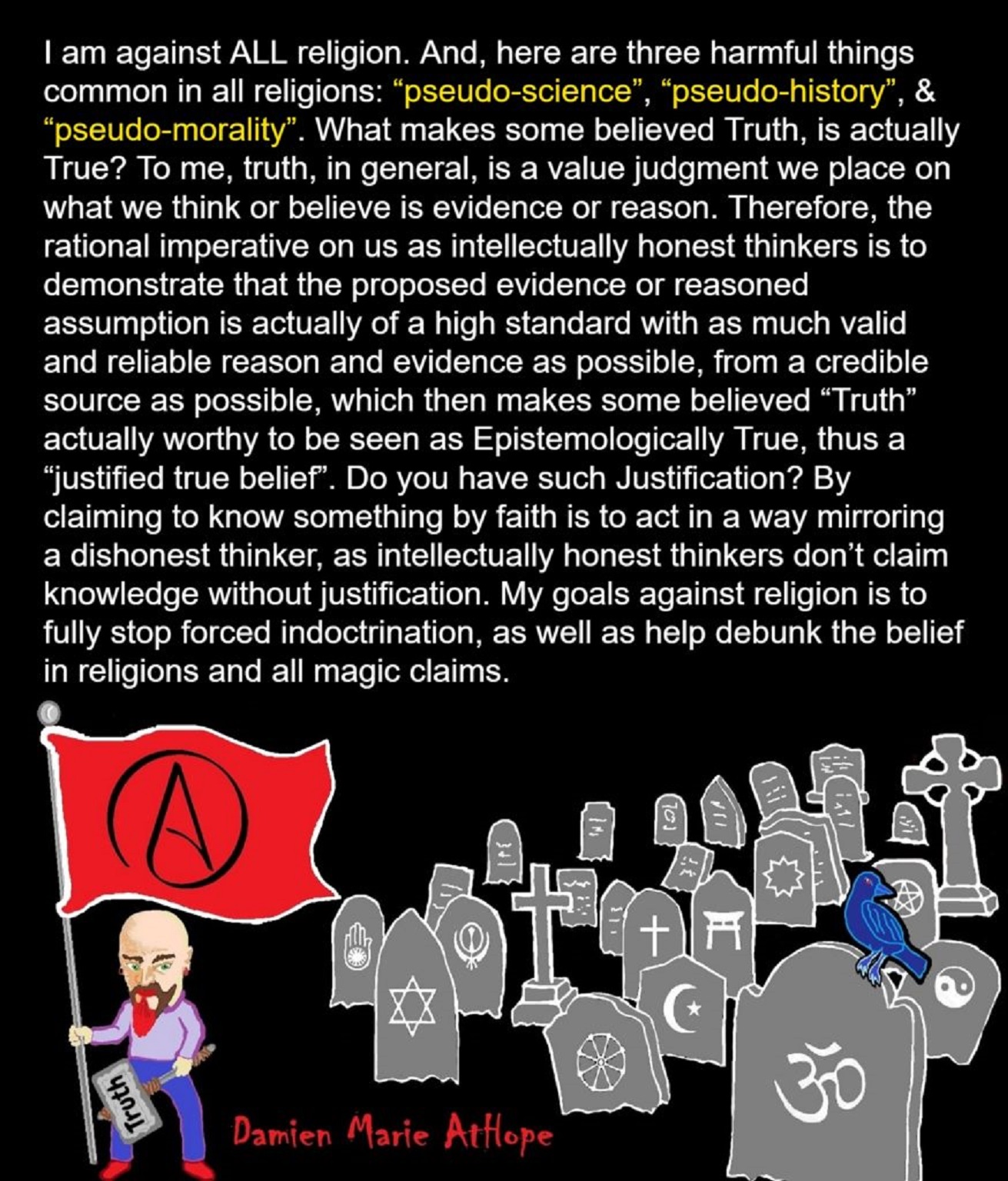

Damien Marie AtHope (Said as “At” “Hope”)/(Autodidact Polymath but not good at math):
Axiological Atheist, Anti-theist, Anti-religionist, Secular Humanist, Rationalist, Writer, Artist, Jeweler, Poet, “autodidact” Philosopher, schooled in Psychology, and “autodidact” Armchair Archaeology/Anthropology/Pre-Historian (Knowledgeable in the range of: 1 million to 5,000/4,000 years ago). I am an anarchist socialist politically. Reasons for or Types of Atheism
My Website, My Blog, & Short-writing or Quotes, My YouTube, Twitter: @AthopeMarie, and My Email: damien.marie.athope@gmail.com
